

‘Battle at Kruger’: The Ultimate Game Drive Footage
Watch ‘battle at kruger’ – lions v buffalo v crocodile.
‘Battle at Kruger’ is perhaps the most epic homemade safari video ever filmed. It’s also one of the most viewed, having raked up 83 million views on YouTube!
The now-legendary video was caught on camera in South Africa’s Kruger National Park in autumn 2004 by an amateur whilst on a guided safari game drive , just meters from the action.
Chevron employee David Budzinski was on holiday in Kruger National Park with his friend Jason Schlosberg, and ended up filming what any professional wildlife cameraman would see as the pinnacle of their career. It’s no wonder that the clip has so many YouTube views, and been featured in TIME magazine , National Geographic, and countless other wildlife websites and publications.
If you’ve not yet seen it, set aside eight minutes right now to watch this epic animal confrontation. Not for the faint-hearted, the eight-and-a-half-minute clip shows a graphic struggle for survival between a herd of buffalo , a small pride of lions , and some opportunistic crocodiles in the water.
Watch the full ‘Battle at Kruger’ video:
Most viewers will be rooting for the buffalo calf, but it’s also a powerful vision of the relationships between different animals and within a herd. Could you imagine the feeling of actually being there while this tale played out in front of your 4×4? It’s dramatic enough on the computer screen!
The video starts with a pair of adult buffalo with a calf leading a large herd alongside a river. From a distance, a group of four lions are resting and watching, and quickly assume a stalking position. Moments later the lions ambush the buffalo, sending them running, and pulling the baby buffalo into the water shallow water.
The lions quickly surround the baby buffalo in the water, biting its neck in an effort to kill it. They calmly pull the buffalo onto the riverbank but are ambushed by a pair of crocodiles, one of which bites the buffalo’s rear end, and a tug of war between lions and crocodile ensues. The lions eventually win and drag the buffalo on to dry land, where they settle down to tuck into a meal.
At this point, a large buffalo herd in formation slowly approaches the lions, and a couple of the braver males make charges at the lions. At one point a lion is flung high in the air on a buffalo’s horns, and one of the lions runs away.
A group of buffalos then advances to touching distance of the lions, at which point – miraculously – the baby buffalo stands up and runs back into the herd, seemingly OK. The remaining lions are then chased off one by one, and the video ends.
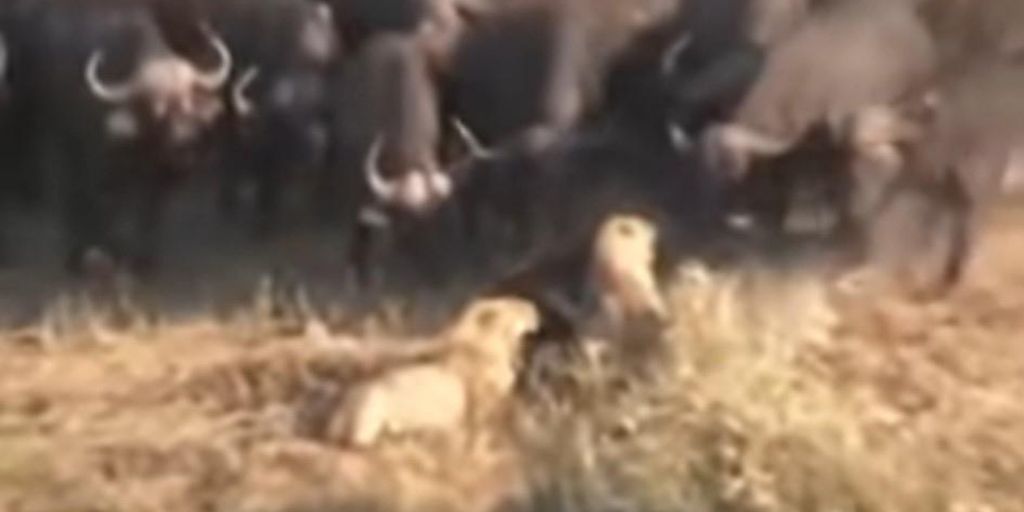
Still from ‘Battle at Kruger’ – the buffalo herd takes on three lions to get a calf back
What do you think of the ‘Battle at Kruger’ video? Share your thoughts (and even your own safari related videos) below in the comments section!
Top countries for safaris
- Botswana safaris
- Kenya safaris
- Namibia safaris
- South Africa safaris
- Tanzania safaris
- Uganda safaris
Safari basics
- Safari animals
- How to find the right safari company
- When to go on safari
- What to take on safari
- Safari clothing – what to wear
- Safari rules & etiquette
- Wildlife spotting tips
Most read articles
- All about the ‘big five’ animals
- Collective nouns for animals
- Safari movies to watch before you go
- The world’s fastest land animals
- Apex predators
- 10 Fascinating African tribes
- The biggest animals in the world
- 17 Epic hybrid animals
- The world’s ugliest animals
- Why are flamingos pink?
Africa’s best game reserves
- Chobe National Park, Botswana
- Etosha National Park, Namibia
- Kruger National Park, South Africa
- Masai Mara National Reserve, Kenya
- Moremi Game Reserve, Botswana
- Okavango Delta, Botswana
- Serengeti National Park, Tanzania

Session expired
Please log in again. The login page will open in a new tab. After logging in you can close it and return to this page.
Get Important 360° News and Notifications:

Kruger National Park
Kruger national park 360° virtual tours.
How To Watch 360° Videos & Photographs Using Any Device
This 6 hour game drive from Crocodile Bridge gate delivered lion sightings on three different occasions ( including the Vurhami Pride ), and a cheetah in the distance. Lots of plains game too, notably a very large herd of buffalo on the S28 road.
The Kruger National Park is one of the best places in Africa to cost effectively and successfully go on a self drive safari, as this 360° video illustrates. Two leopards seen within an hour of entering Malelane Gate.
This turned out to be a very good drive with lots of wildlife being spotted in the Southern part of the Kruger National Park, which has a high density of various animal and bird species.
Kruger National Park Live Webcams
Situated in the world famous Sabie Sands game reserve which forms part of the greater Kruger National Park ecosystem, this live waterhole webcam is the first and oldest in Africa.
Launched in 1998, it's manned by volunteers who pan and zoom the camera manually to highlight any wildlife that might be drinking at the dam.
Due to the fact that this cam has infrared capability, it's one of the best for nocturnal animal sightings.
Also based in the Sabie Sands game reserve which has no fences between it and the neighboring Kruger National Park.
This solar powered webcam is situated at a secluded waterhole near the Naledi Game Lodge in the Balule Game Reserve, which adjoins the Kruger National Park in the east.
It provides the opportunity to see a wide variety of animal species, particularly elephant, giraffe and antelope. And African predators have also been known to visit on occasion.
One of the few cams set on the banks of an African river, it provides the opportunity to experience the sights and sounds of the Olifants river ecosystem in real time.
Crocodiles and hippos are regularly seen along with a variety of other animal and bird species.
The Kruger Shalati is a train on a bridge over the Sabie River in the Kruger National Park that has been converted into luxury accommodation.
There are three live streams from the bridge and the surrounding areas with webcams strategically placed to optimise wildlife sightings.
Greater Kruger National Park Lodges
Kirkman’s kamp.
&Beyond's Kirkman’s Kamp is located in the world famous Sabie Sands Nature Reserve and contains 12 guest cottages, each with a private veranda.
Tintswalo Safari Lodge
You will find the Tintswalo Safari Lodge in the Manyeleti Nature Reserve and it offers six Explorer Suites, as well as the large Baines Presidential Suite, and the 2-bedroom Grant Family Suite.
Accommodation - Lodges & Rest Camps
The Kruger National Park has 12 main rest camps, 5 bushveld camps, 2 bush lodges and 4 satellite camps, so you are spoilt for accommodation choice when visiting there.
The greater Kruger Park area, which consists of privately run game reserves that lie next to the publicly managed Kruger National Park (with no fences separating them) , also contain a large number of lodges.
Sabi Sands : 24 lodges Timbavati : 18 lodges and 4 self catering camps Klaserie : 16 lodges and 5 self catering camps Balule : 19 lodges and 9 self catering camps
The park is situated within a malaria area so it's recommended that any visitors take anti-malaria medication.
Consult your medical professional about the correct medication for your situation.
Wildlife Sightings
The southern part of the Kruger National Park has a higher density of plains game and predators than the north, so you might see more game on a regular basis there.
That being said, you will still have excellent wildlife and bird sighting even in the northern parts of Kruger.
To get a better idea of what has being seen where, visit the Kruger Sightings Facebook page...
Flights - Skukuza & KMIA Airports
There is an airport situated inside the Kruger National Park itself near Skukuza rest camp, but it's not big enough to allow international flights.
So to get there you would need to take a connecting flight from one of the international airports in South Africa, like O.R. Tambo in Johannesburg or Cape Town International.
The Kruger Mpumalanga International Airport (KMIA) is based just outside Nelspruit and can accommodate international flights. It's a 45 minute drive to the nearest Kruger gate at Malelane.
Kruger National Park Weather
Being in a summer rainfall area means you can expect higher precipitation in the park during the months of September to March.
Summer (October to February) temperatures are regularly above 30° C and in winter (April to August) they rarely dip to below 10°.
Guided vs Self Drive Safari
These are the two kinds of safaris that can be undertaken in the Kruger National Park, both with their own inherent advantages and disadvantages.
Guided Safari Advantages: You benefit from the guides local knowleadge and the safari company takes care of all the logistics for you. Disadvantages: Higher cost.
Self Drive Safari Advantages: Lower cost and you have autonomy to make your own decisions and set your own pace. Disadvantages: You have to plan and execute all the logistics yourself.
- Kruger National Park Safari
- Planning your Kruger Park Safari
- What to Bring on Safari
- What to Expect on Safari
- Kruger Park Safari General Information
- Frequently Asked Questions
- Viva Safaris Company Profile
- Meet The Viva Safaris Staff
- Tremsisana Lodge and Marc’s Treehouse Lodge Compared
- Viva Safaris Newsletters
- Kruger Park Safari Enquiries
- Kruger National Park Safari Reviews
Safari Video Gallery
- Terms and Conditions
- Introduction
- Tremisana Lodge in the Media
- Accommodation
- Game Viewing
- History of Balule Game Reserve
- Safaris Staying at Tremisana Lodge
- Camera Trap Gallery
- Marc’s Treehouse Lodge in the Media
- Safaris Staying at Marc’s Treehouse Lodge
- Katekani Introduction
- Safaris Staying at Katekani Tented Lodge
- Masango Camp Introduction
- Safaris Staying at Masango Camp
- Safaris Staying at Luxury Lodges
- Special Kruger Park Safari Packages
- All Kruger Park Safari Packages
- Make a Reservation
- Make a Payment
A selection of fantastic safari game drive and wildlife sighting videos taken by our guides in the Kruger National Park as well as other private reserves including Balule and Motlala.

Facebook Page

- Tour & Activity Articles
- Destination Articles
- Photography
- Environment
- Biodiversity
- Climate Change
- Editor's Blog
- Magazine Updates
- Write For Us
- Work With Us
- Advertise With Us
- Environmental Speaker
WHAT ARE YOU LOOKING FOR?
Popular tags.
- conservation
- sustainability
- special places
How to Plan and Execute an Unforgettable Kruger National Park Self-Drive Safari: A Comprehensive Guide

Morning breaks, the morning call of the Cape turtle dove says, ‘Work harder, work harder’, reminds you that working is for other people; today, at least, you are on holiday. You are on safari in the Kruger National Park, South Africa’s majestic wildlife jewel, spanning an area about the size of Israel. On your agenda: get up early, drive through untouched Africa, find that leopard, and dodge that elephant. But first, coffee, of course, you are addicted; you even brought your plunger (french press) to ensure it’s just right. Using the self-catering rondavel’s (African-style hut) kettle, you prepare your flask for the morning drive.

Leopard up close and personal with Nikon P950
As the camp gate opens at dawn, eager tourists armed with cameras, binoculars or, like me, the superzoom Nikon P950 , keen as you are to capture that perfect National Geographic-worthy wildlife shot, await the gate to open. As you start the drive, you muse that, at Kruger Park, the humans have to stay in the zoo at night while the animals roam free. Sipping on your coffee, hunting for that first sighting, you see another car parked ahead. What are they looking at? You cannot see. Ah, the car has a birdwatcher warning: ‘We stop for birds’, better check the trees. There it is, you see it, it’s a European roller. You already have quite a few roller pictures and decide to move on. You have to find that leopard. Today, too, will undoubtedly yield some fantastic photo evidence, if not for National Geographic, then at least for Instagram. And so the day starts.

Ground Hornbill - Vulnerable - Visitors are requested to report their sightings
For many South Africans staying in the inland regions, going to the Kruger National Park on holiday is just one of those things you do every year. We most certainly do not call it self-drive or any such formal descriptions. Many South Africans pack their car and go to the Kruger, often with little forethought and concern. I, however, realised for many foreigners, it must be pretty daunting to get in the car and drive to this wild, untamed wilderness through a country you do not know, especially in a country where you have to take safety precautions.
I decided to give you a detailed guide that can help. Please let me know if you found this article helpful; it keeps me going. If you are reading this guide to find out about the Kruger National Park but prefer an organised safari, I can suggest BookAllSafaris or Viator to find a Kruger safari that suits your wallet and travel preferences.

Hippo & bird at the river
Planning your kruger park adventure, what is a good time of the year to visit the kruger park.
Every season has its advantages and disadvantages in the Kruger National, and the accommodation in the Southern part of the park is typically booked up the entire year, especially during the local December holidays. However, locals will usually tell you winter is a time to visit the Kruger National Park—the slightly cooler temperatures in an otherwise very hot climate. The reduced grass cover improves sightings. Many locals would go to Kruger during winter holidays and to the beaches of Cape Town or Durban Kwa Zulu Natal in the summer. As a tourist, you may want to combine beach and bush. In this case, the park is fantastic all year round.
Here are Some Advantages and Disadvantages by Season:
Summer (December-February) : Hottest time of year, with lush vegetation and full waterholes. Good for birdwatching and seeing newborn animals.
Autumn (March-May) : Pleasant temperatures, less rain and clearer skies. It is suitable for game viewing as animals gather around waterholes.
Winter (June-August) : Dry season with cool mornings and warm afternoons. Sparse vegetation makes spotting animals easier.
Spring (September-November) : Wildflowers bloom, and temperatures become warmer. It is suitable for seeing calves and baby animals.
Map: Paul Kruger Gate - Kruger National Park
What accommodation options are available.
Staying inside or outside the park in public or Private Accommodation , the Kruger National Park is a global attraction and offers a massive selection of accommodation options. SANPARKS manages the main camps in the Kruger National Park. You can book your accommodation through their website or on booking.com. Although many tourists may take a chance in the off-season to drive through the Kruger and look for camps with accommodation, planning your accommodation well ahead of time is advisable. The most popular camps are usually fully booked well ahead of time.

Hyena with cubs
There is also a range of accommodation options in the park that are private concessions. These often focus on luxury experiences. Surrounding the park, you can find private reserves such as Sabi Sands and Timbavati , often with no fences to the Kruger National Park. Also, outside the park, you will find various accommodation options that provide day tours into the Kruger National Park, providing the advantage of access if accommodation is full. Some places also offer budget accommodation, such as backpackers’ lodges.
Camping and Glamping
Most of the camps in Kruger National Park have campsites. These campsites are well equipped with electricity, communal kitchen huts, showers, and ablution facilities. The campsites can be booked through the SANParks website. If you prefer the comforts of home that formal accommodation provides with the African feel of a tent, Kruger National Park provides 'Glamping' options by SANParks and private concessions . Glamping is a fusion of "glamorous" and "camping," offering a luxurious outdoor experience with the comfort of modern amenities. It combines the adventure of camping with upscale accommodations, providing a unique and stylish way to connect with nature.

Endangered African wild dog
Vehicle rental options:.
Choosing the right vehicle is paramount before you embark on your Kruger adventure. You can opt to go for a standard rental vehicle. Even the most budget-friendly car will do the trick. I enjoyed one of the most memorable trips ever using just such a rental car. The only downside is the vehicle's height; tall grass sometimes causes an issue, and you may need to get creative to view some popular animals restricted by the massive number of 4x4 vehicles South Africans love to drive. Traffic situations happen mainly in the Southern Areas close to Skukuza.
If the perfect view is your objective, consider renting a higher vehicle, such as a 4x4 or minibus. You can also consider the motorhome or RV experience, which offers some real advantages in terms of height and amenities.

Lions often cause traffic situations in Southern Park
Booking a rental car:.
South Africa has a vast fleet of rental cars, 4x4s, and minibuses from most international providers. Streamline your journey by using platforms like Rentalcars.com to book your vehicle.
RV Vehicle Essentials:
The elevated windows of RVs offer panoramic views, putting you in the front row for every wildlife spectacle. Having toilet facilities on the vehicle proves to be handy as you cannot get out of the car in most of the Kruger Park, only in designated picnic spots, viewpoints and camps. Check with your provider on the amenities offered with the vehicle. Opt for affordability by renting through Motorhomerepublic.com. Maui Motorhome and Britz are popular options in the country.

Female violet backed starling at her nest
Malaria and health considerations.
Consult with a doctor regarding malaria risks, particularly in the northern areas during the wet summer. The Southern Parts of the park around Skukuza are generally accepted as safe from Malaria. But you may want to take malaria preventative tablets. The camps have basic medical assistance options, but keep in mind the closest hospitals are a substantial drive away, so keep your adventure risks to a minimum.

The male making sure we hear that we are intruding
Kruger national park safari packing list:, essentials:.
• Comfortable clothing: Lightweight, breathable shirts and pants for hot weather, long sleeves and warmer layers for cooler mornings and evenings. Quick-drying fabrics are ideal. (Many international tourists prefer complete safari outfits, but most South Africans will enjoy the park with comfortable everyday outfits)
• Hat and sunglasses: Protect yourself from the sun's harsh rays.
• Sunscreen and insect repellent: Choose effective options for the African climate.
• Binoculars: Essential for spotting wildlife during game drives.
• Personal toiletries and medications: Don't forget essentials like medications and personal hygiene products.
• Camera and charging equipment: Capture your Kruger memories!
• Torch (flashlight): Useful for early morning starts and night exploration.
• First-aid kit: Be prepared for minor cuts and scrapes.
• Reusable water bottle: Stay hydrated throughout the day.
• Comfortable walking shoes: Opt for sturdy shoes with good grip for uneven terrain.
• Book or travel journal: Keep yourself entertained and capture your experiences.
Optional extras:
• Safari bag or backpack: Easy to carry essentials during game drives.
• Swimsuit and towel: Take a dip in the camp pool if available.
• Adapter plug: Ensure you can charge your electronics.
• Snacks and drinks: Bring some non-perishable snacks for the road.
• Cash: Some smaller shops and markets may not accept cards.
• Guidebook or wildlife ID app: Enhance your wildlife spotting expertise.
Arriving in South Africa
When you land in south africa at johannesburg international airport (o.r. tambo international airport).
It is advisable to stay at least the night in Johannesburg. When you arrive in South Africa, you may be tired, and the drive may be unsafe. Only attempt to drive on the day you land if you arrive very early. If you are staying inside the Kruger National Park, consider the gate closing times, which differ in summer and winter.

Nelson Mandela Poster Johannesburg - Gregory Fullard
Your one night in jozi, the city of gold.
I suggest the Sandton area for this specific type of journey. The Sandton City area provides a range of hotel options close to a central shopping district. If you decide to stay longer than one night, ask your hotel what local tours are available. Popular tours include the Apartheid Museum, Nelson Mandela’s home and Soweto.
One of the main advantages of doing your safari in South Africa is that you have all the modern comforts at home, and they can assist you on your safari. The mix of first-world and wilderness is genuinely unique. You can use your favourite app to book your car and RVs and use your map applications to navigate (Inside the park, phone reception is mainly restricted to the parks). Your map application should still work. You can use booking.com to book your accommodation.
Driving to the Kruger National Park
How to get to kruger national park from johannesburg airport (o.r. tambo international airport).
The quickest route to Kruger Park from Johannesburg is 392 km via the N12 and N4. Driving to Kruger Park from Johannesburg International Airport takes about 4-5 hours without stopping along the way. Driving from Johannesburg to Kruger in perfect conditions should take 5-6 hours. The route has excellent rest stops. Milly's is the most famous, and about halfway on the N4 route; give it a try.
Driving from Johannesburg to Kruger is perfectly safe, although you should watch out for construction, toll booths, speed traps, and potholes. Navigating the roads leading to Kruger requires awareness of road conditions and toll fees. Overseas cards may not work at toll areas, so you must be prepared for toll fees in cash during your journey to avoid embarrassment (It is a real problem I witnessed). To be safe, do not divert from well-traveled routes, city roads, or directions by your favourite map application unless you check in with a reliable source.
I have warned you about the gate-closing times already ;) They still catch out the South Africans. Leave enough time to navigate inside the park to the camp. Remember, speed restrictions inside the park is 50km per hour. If you place the camp as a destination, your maps application should consider this for the arrival time.
Map: Malelane Gate - Kruger National Park
At which gate should you enter the park.
Your choice of the gate is very personal and dependent on the camp or accommodation options you choose. But here are some suggestions. The main gate, probably the most popular, is the Paul Kruger Gate. It provides access to the biggest camp, Skukuza. The drive to the gate may be slightly challenging yet fascinating as you must navigate some relatively rural areas. The quickest and most direct gate to enter the park I found is the Malelane gate. It provides access to the Berg-en-Dal rest camp and is not too far from Skukuza.
The Kruger National Park gate opening and closing times vary depending on the season:
November to january:.
Entrance Gates Open: 5:30 AM
Camp Gates Open: 4:30 AM
All Gates Close: 6:30 PM
February to March and October:
Camp Gates Open: 5:30 AM
All Gates Close: 6:00 PM
April to September:
Entrance Gates Open: 6:00 AM
Camp Gates Open: 6:00 AM
These are the general times, and specific gate times may vary slightly. Always double-check with SANParks

Elephants can be unpredictable stay at a distance
Inside the kruger national park, park rules for your safety:.
Familiarise yourself with camp and gate opening/closing times. Adhere to the 50km/h speed limit, ensuring a safe and enjoyable journey between camps. Do not leave your vehicle outside the designated camp, picnic or viewing areas. Stick to main routes, keep vehicles locked, and save emergency numbers from the rental company. Adhere to safety guidelines, especially during elephant encounters, you should keep your distance. Elephants often clearly indicate with their behaviour if your presence is disturbing. Move away promptly or risk being the villain of a viral video starring a vehicle elephant encounter with a squashed car.

Giraffe always a favourite up close with the Nikon P950
What animals are you likely to encounter at the kruger on your safari.
Kruger National Park is one of the most popular tourist destinations in South Africa because of the fantastic range of wildlife in their natural habitat. It is located in the northeastern part of the country and is home to various wildlife. The diverse range of wildlife includes the Big Five - lions, leopards, elephants, rhinos, and buffalos. Other animals you will likely encounter include cheetahs, giraffes, zebras, hyenas, hippos, crocodiles, and many more. There are over 150 mammal species in Kruger National Park, ranging from the very large (elephants) to tiny shrews. The park is also home to a wide variety of bird species, with over 500 species recorded.
To guide you through the incredible diversity of wildlife, I suggest taking along a comprehensive guidebook; my absolute favourite is Game Ranger in Your Backpack: All-in-One Interpretative Guide to the Lowveld .

Kruger National Park Game Drive
Kruger national park activities: a wildlife playground.
Kruger National Park offers a treasure trove of activities you can join and book at the various camps. Here are just some examples.
Wildlife Encounters:
• Game drives: Embark on thrilling morning or afternoon drives in open vehicles, guided by experienced rangers who expertly navigate the terrain and unveil the park's hidden wonders.
• Bush walks: Immerse yourself in the heart of the wilderness on guided walks, traversing diverse landscapes, and you may encounter a mating lion or a buffalo staredown (a personal experience).
• Night drives: Embark on a thrilling adventure into the nocturnal realm of Kruger. Spot creatures of the night, like lions stalking their prey, owls hunting rodents, and the mesmerising glow of fireflies illuminating the darkness.
You can book your game drive at the camp or find a private activity at GetYourGuide .
Rest and Relaxation:
• Picnic at rest camps: Pack a delicious picnic and head to designated picnic spots within the park, overlooking scenic landscapes.
• Swimming pools: Take a refreshing dip at rest camps, especially during the hot afternoon hours.
Family Fun:
• Junior Ranger programs: Let your little ones embark on exciting educational adventures with ranger-led activities and games. Learn about animal tracks, conservation efforts, and protecting nature.
• Bush braais (BBQs): Enjoy a traditional South African braai under the starry sky at designated areas within rest camps.
Beyond the Safari:
• Cultural experiences: Visit nearby villages and communities to learn about the region's rich cultural heritage. Engage with local craftspeople, taste traditional cuisine, and gain deeper insights into the life and traditions of the people who share this landscape.

Bateleur Couple Kruger National
Shops, restaurants and amenities in the kruger national park.
Most camps in Kruger Park have a camp shop. These stores, managed by National Parks, provide most of the necessities you will require for self-catering or camping holidays. Skukuza's store has the most extensive selection. The store's offerings include African memorabilia and everyday necessities such as bread, milk, coffee, cool drinks, and snacks. The shops stock some often left behind camping equipment and, most important to South Africans, braai wood, ice, liquor and meat for the evening's braai. If you left something behind, don't worry; you will most likely find it right there in the camp.
If you prefer eating in a restaurant, you will find each camp's restaurant selection has its flavour and style, offering breakfasts, simple lunches, and a la carte menus.

Rock Monitor Kruger National
Inside the kruger park, our journey continues.
That Leopard has been avoiding you every day. You checked yesterday’s sightings on the community pinboard at the camp and followed their general direction, but no leopard. Fortunately, your previous forays racked up sightings of four of the big five: a lion, elephant, buffalo and that endangered rhino guarded by some well-armed rangers.
The well-marked, stone-built road sign indicates ‘Tshokwane’ 10km. Just in time, you are starting to feel like breakfast. On arrival, you notice the well-prepared, most probably local, tourists cooking their breakfast on gas cookers provided by the camp. The English menu prompts you to order a local favourite, roosterkoek (literally translated as grill cake), grilled on the braai (South Africa’s version of the barbeque) right there. While you enjoy your meal under the typical African savannah tree, you ponder your place in this vast natural ecosystem. And, of course, lunch at one of the more formal camp restaurants, such as Satara, as one does when time is of little consequence.

RELATED STORIES
Unlocking harmony: deepening relationships through the people-parks win-win framework, tsowa unveiled: exploring the operations of a truly african remote zimbabwean island lodge, south africa, an ocean explorers paradise, knysna elephant park: more than a tourist destination, mozambique hails golden jubilee gems and conservation wins in zinave and banhine national parks.
- kruger park
- south africa
Thank you! 🥰 Conservation Mag is reader-supported. When you buy through our links, we may earn a commission.
- Editorial Guidelines
- Terms of service
- Privacy Policy
- Copyright Notice
- Fact Checking
Home > South Africa > Kruger Park Safari Tips
16 Kruger Safari Tips to See More Animals and Have a Better Trip

What's More Intimidating than a Lion?
I don't know. But the task of planning our Kruger Park safari certainly felt almost as intimidating.
We were spending a lot of money, we were novices, and we didn't want to screw it up, especially since my parents were joining.
Fortunately, thanks to good planning, good luck, and, most of all, great tips from our host Bjorn, our turned Kruger trip turned out great.
And nobody got eaten by lions.
This blog post shares the Kruger Parks safari tips we learned including why you should use Twitter, why the Big 5 is overrated, and why elephants are what you should really worry about more than lions.
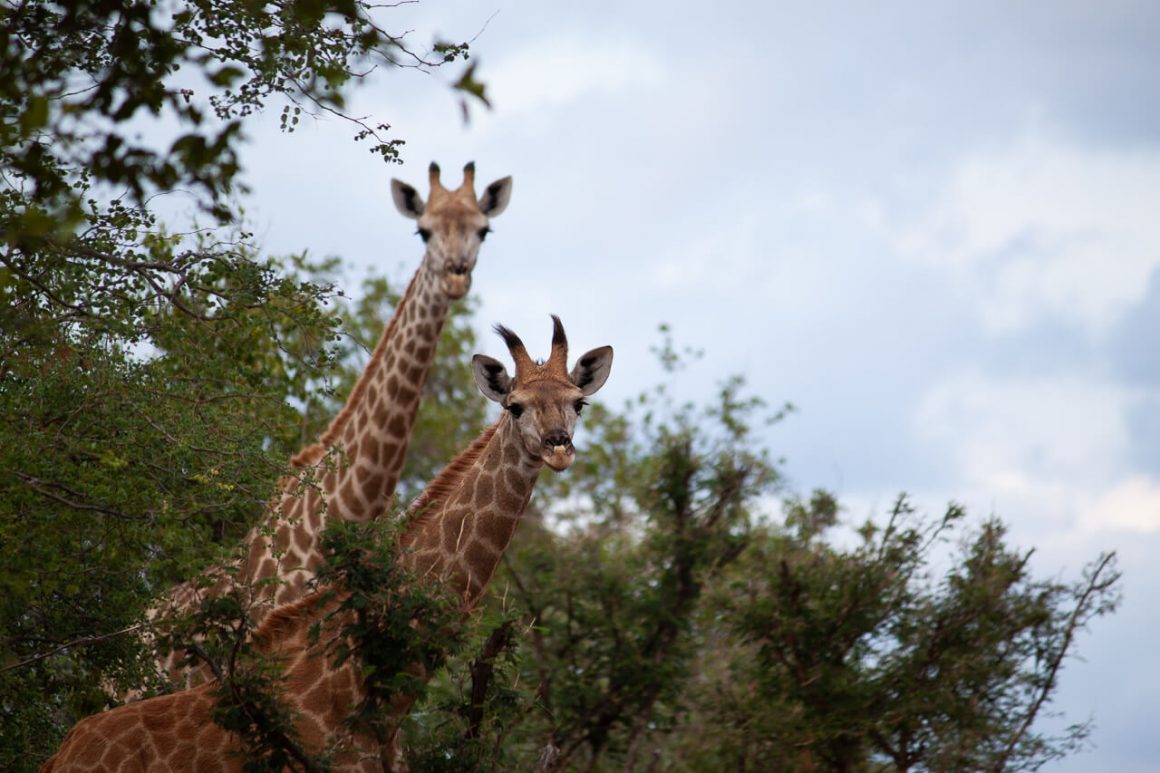
Kruger Park Safari Blog Outline
- Planning Tips
- Self-Drive Tips

Tips For Planning Your Kruger Safari
1. go during the dry season (but don't stress if you can't).
Kruger Park is a year-round destination, with each season bringing its own highlights.
During the dry season (Sep-Nov), animals are easier to spot because the vegetation is sparse and they have nowhere to hide. They also tend to congregate around watering holes.
In the wetter months, it's much greener so animals are tougher to spot but there are more newborn wildlife and migrant birds. We went in January and it rained, but we still saw plenty of game animals.
So don't worry too much about when you go.
There is a worst time to go, though …
Avoid the Christmas holiday season.
Prices are highly inflated because South Africans are on both summer and Christmas holiday and the roads inside the park will be busier than you'd like.

2. Don't Be Misguided
One of the biggest questions we had before our own Kruger Park trip was whether to hire a guide or not.
If you only remember one of our Kruger safari tips, this should be it.
We still don't have an obvious answer, but here's some info that might help you decide:
If you can afford it, get a private guide for your first day
If you can find a guide like Bjorn, the owner of Mbizi Lodge , where we stayed, it's worth the cost for at least one day. He guided us on our first day in Kruger and he was fantastic.
He actually seemed more excited to be on safari than we were!
For twelve straight hours, Bjorn kept us engaged and informed with info on everything from interesting info on animal behavior, spotting tips, crazy stories about the anti-poaching paramilitary, and his own story of how he, an ex-Salesforce employee, realized his dream to become a safari lodge owner and guide.
Not only did we learn and see more by having Bjorn with us on our first day but we also enjoyed our subsequent self-drives more too thanks to everything he taught us.
Beware of bogus safari guides
Bjorn warned us that many safari guides have no idea what they're doing. They bought their licenses from corrupt officials and completely skipped over the intense, multi-year certification course that guides are supposed to graduate from.
They know (and care) next to nothing about animals or the environment and are just doing their job for the money, so getting one of these guides can be a huge waste of time and money.
To avoid getting stuck with one of these bad guides, read forums, ask your hotel, and ask friends who have been to Kruger already (like us!) for a personal recommendation.
Educate yourself before you self-drive
Going on safari without a guide is not a bad alternative. It saves you money and gives you to freedom to go and stop wherever you want.
The downsides are you might see fewer animals because you don't know where or how to look and you don't have anyone to answer your questions or point out unusual or interesting behaviors.
But you can minimize those downsides by educating yourself.
Get a wildlife book or two, which we'll elaborate on in Kruger safari tip #4 , and watch documentaries like the Keeping Up with the Kruger TV series.
As an added bonus, doing this type of research will get you extra hyped for your trip.
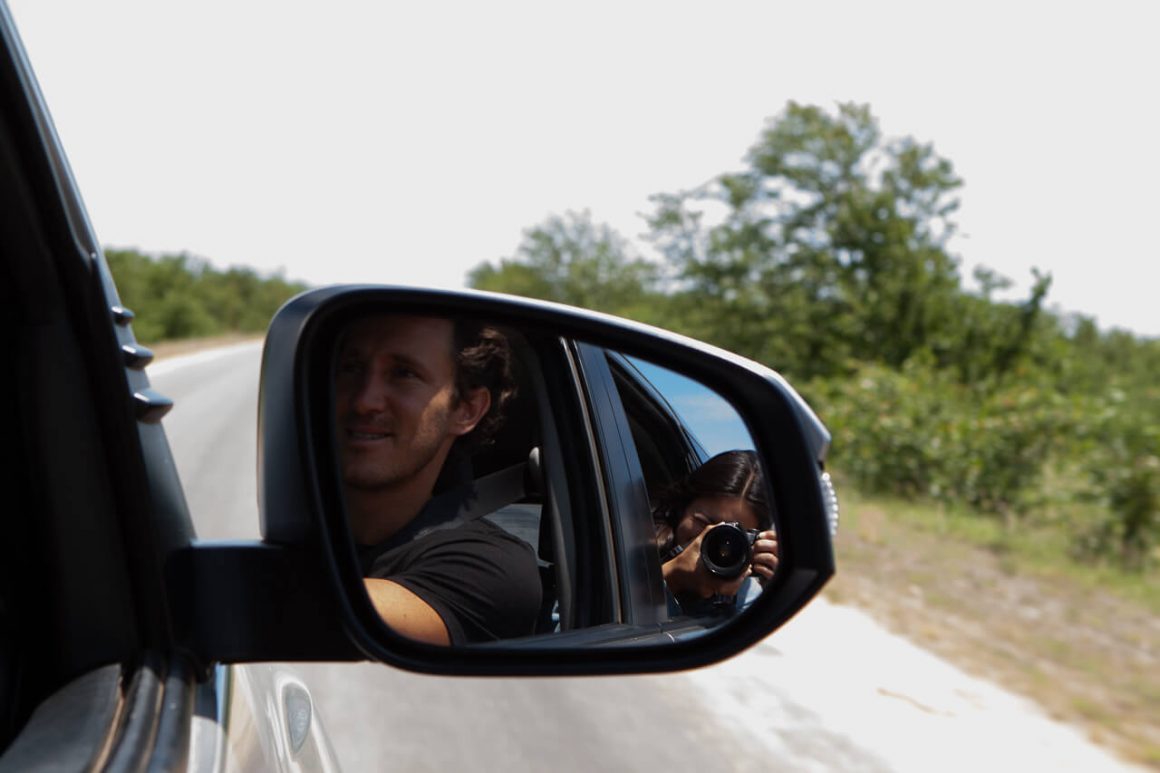
3. Choose Your Accommodation Wisely
Deciding where to stay in Kruger Park can seem like a daunting task. But it doesn't have to be.
Figure out what you'd like to see
If you're after birds, go to the North. If you're after the game, stay in the South. And if you're after maybe slightly less game but fewer people, stay in the middle of the park.
Then, decide whether you want to be inside the park, or not
There's a decent amount of camping inside the park with basic camping facilities. You'll have to bring your own food or stock up at one of the rest stops. Camping is around R250 per couple which makes this accommodation one of the most affordable. Other lodges inside the park vary in price and quality, but some luxury lodges can go as much as R15,000 per night.
If you don't want to camp and you're not rolling in dough, book some of the smaller lodges in advance to avoid disappointment.
Consider staying outside Kruger at Mbizi Bush Lodge
We loved staying at Mbizi Bush Lodge , located about 30 minutes from the Phalaborwa gate in the middle of the park.
Owned by a friendly young couple, Bjorn and Divya, it's a mid-priced alternative to the super-expensive lodges with a much more personal touch.
Bjorn is the game drive guide with a wealth of knowledge and even more passion for wildlife. Divya, his partner, is an amazing chef who treated us to some delicious, homemade meals. And Noah, their son, is too cute for words.
With only three cabins on site and such engaging hosts, our experience at Mbizi felt just as exclusive as and more friendly than any super-luxury lodge.

4. Decide How Many Days to Drive (and How Many to Rest)
The biggest question we had when planning our own Kruger safari was how many days to go for?
And on how many of those we should do game drives?
Based on our experience, I recommend between 3-6 days total spend about two-thirds of that time doing game drives and the other third stretching your legs on a bush walk (below) and exploring surrounding areas like Blyde River Canyon (below) .
5. Ensure You Have Super Vision
Whether it's with binoculars or a zoom camera lens, make sure you have a way to see far.
Animals are often further away than you think and even when they're nearby it's really cool to get a close-up.
For binoculars, Bjorn recommends getting a pair with at least 10×50 magnification.
For camera lenses, we saw other people with lenses that looked like the Hubble telescope but found our humble Canon 55-250mm zoom lens did the trick just fine. And it fit in our carry-on!
Consider renting camera gear
If you don't own a fancy zoom lens, consider renting one from a camera shop in Joburg or in one of the nearby towns. Africa Photographic Services in Nelspruit (Southern Kruger) offers rentals starting from about R250 per day.
Tip Within a Tip: Don't rely on your guide to have binoculars you can use, either. Ask in advance.

6. Get a Wildlife Book
We all rolled our eyes when my mom bought a couple of wildlife booklets in town on the way from the airport to the lodge.
But then we all found ourselves fighting over them and flipping through their pages throughout our entire Kruger safari.
They helped us identify all the different animals more easily, especially the many species of antelope, and provided fun facts about each of them, which increased our appreciation and understanding of what we were looking at.
Pick up a book in town in either Hoedspruit or Nelspruit or download a Kindle version here .

7. Don't Miss Blyde River Canyon
Blyde means "happy" or "glad" in Dutch. We felt the opposite of that for missing out on it because of poor planning.
Located approximately 55km southwest from Hoedspruit (the airport nearest the middle of the park), Blyde River Canyon is said to be maybe the largest green canyon in the world and one of Southern Africa's top sights.
It makes for a nice day trip to break up your long game drives and rest your eyeballs from constant animal searching.
Forever Forest in Blyde River Canyon offers many hiking routes that will take you through lush jungle, waterfalls, and some stunning viewpoints.
Alternatively, the Panorama Route is a scenic driving loop you can do.
And just because you're outside of Kruger doesn't mean you won't see animals. Be on the lookout for hippos, monkeys, crocodiles, and the elusive leopard along the way.

8. Avoid Jet Safari Lag
Even though we flew in from Cape Town, which is in the same time zone as Kruger, we had to deal with a version of jet lag.
Call it safari lag.
That's because we were waking up at 4:30 a.m. every day instead of the usual 6:30 to 7 to be out at dawn when the most animals are out.
Prepare for this two-hour time-change the same way you would if you were truly changing time zones. Consider going to bed and getting up earlier before you leave for Kruger, eating earlier dinners, and drinking less alcohol to sleep better.
And take big naps in the middle of the day like the animals do. This way, you'll feel fresh and your ability to spot animals will be on point.
9. Rent a Vehicle that Puts Comfort First
If you're renting a vehicle, place extra importance on comfort.
You will be spending many hours squeezed inside the thing and you want to be as comfortable as you can for a 12-hour journey.
Bigger isn't always better as SUVs aren't necessarily more comfortable. The SUV we were in for one day had high seats and low windows so Chris, who's 6 foot 3, ended up preferring to sit uncomfortably on the ground between the two back seats rather than strain his back and neck to bend over all the time.
And don't feel the need to splurge.
A sedan will have no trouble handling Kruger's paved roads and is way cheaper in both rental cost and gas.
Some say to get SUVs because you're higher off the ground and can see better. This may be marginally true and if money is no object to you, get one. Or rent a car with a sunroof.
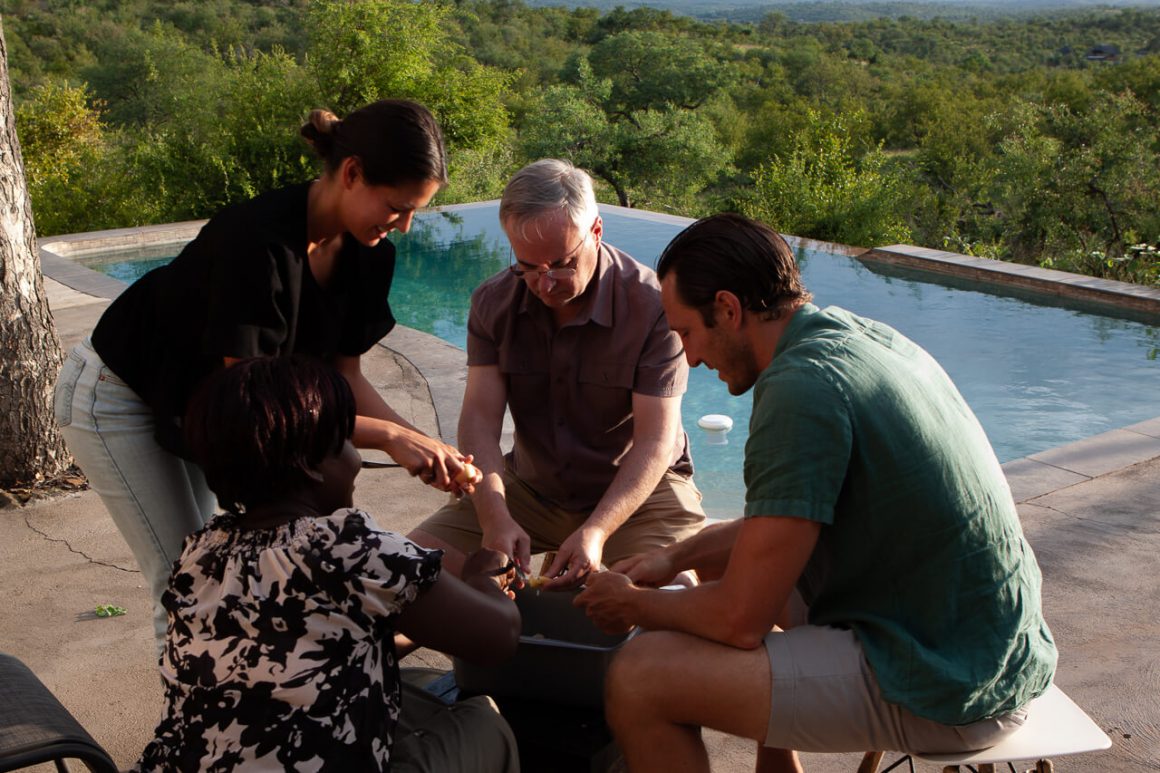
10. Find Out What's in Season
For an extra cultural or educational experience, look up what might be in season and if there are any local events or festivals that might be happening during your time in Kruger.
In our case, we lucked into marula season.
Marula is a South African tree with a fruit that resembles a cross between a mango and quince. It's the fruit behind the sweet, creamy, Amarula liqueur you may have tried before.
The fruit was so abundant you had to be careful to avoid it falling off the trees onto your head. People were madly collecting it to get madly drunk off the beer they made from it.
Selina, one of the staff at Mbizi, taught us how to make our own. It turned out to be the world's easiest beer to make.
We used forks to peel back the marula's tough skin and expose a lychee-like interior, which we squished in our fists to release a white creamy juice into a bucket. We then added some water and… that's it!
No yeast or anything else needed. Within a few days, the marula juice naturally ferments into a surprisingly tasty cider-like drink.
The whole experience was just as memorable as any animal sighting.
Kruger Self-Drive Safari Tips

11. Use Twitter
Use Twitter and follow the account Latest Kruger to keep up-to-date with all the latest sightings within the park.
The park's huge, so for most sightings the animals will have left by the time you get there, but you wouldn't want to miss a lioness and her babies if they happen to be just around the corner.
Also, we found it fun to keep updated on all the action and excitement others were having around Kruger.
We even joined in! When we spotted a caracal, my dad took a photo and tweeted it there. He was almost as excited as he was to see the animal when the account reposted his image to its 37 thousand followers!
And WhatsApp's for insiders
Ask your guide if he or she is part of the Kruger spotting WhatsApp group chat. On it, all the guides let each other know what they've spotted and where.
12. Don't Rely on Google Maps
Don't trust Google Maps' estimated driving times through Kruger Park.
Instead, use the estimated driving times in the printed maps available in guidebooks, like the one pictured in Kruger safari tip #4 above . We found these to be much more accurate.
And they saved the day for us.
If Chris hadn't checked the map, we would've been trapped in Kruger because the loop we thought would take 1 hour (because Google said so) actually took 3 hours, which wouldn't have given us enough time to get out of the gate before the park closed.
But still use Google Maps
While you shouldn't trust Google Maps' driving times, it's still an invaluable tool for tracking your location.
Remember to save the Google Map map of Kruger to your phone for offline use (check out our Google Maps Tips & Tricks post for simple instructions) so you always know where you are.

13. Make Your Own Big 5
The term "Big 5" originates from hunters who used it to refer to Africa's most dangerous animals: lion, leopard, buffalo, rhino, and elephant.
So, unless you're a poacher, it should mean nothing to you.
Forget about checking off the list, focus more on what you do see and not on what you don't see, and make your own Big 5 (or whatever number you want) of favorite animals you spot.
Our Big 5 consisted of giraffes, dwarf mongoose, hippos, ostriches, and dung beetles. And we saw lots of all of them!

14. Don't Worry About Starving
While it's nowhere near the Cape Town restaurant scene, we were surprised to find that Kruger Park had plenty enough food options to keep us fueled for our game drives.
The restaurants in the park had unexpectedly good food at reasonable prices. From vegetable curries to fish & chips and burgers, even the pickiest eater will be able to find something they like for R80 to R150.
Chris' giant schnitzel that could feed a small family of impalas, pictured above, was just R130.
Besides the restaurants, the Kruger rest camps all have shops with a near supermarket-level variety of food and drinks, so you can always pick up some snacks for the road if you're still hungry.
But don't leave your binoculars in the car when you stop to eat
Both the Letaba and Oliphants restaurants that we stopped at had fantastic views from which we could see hippos and elephants.

15. Do Get Out of Your Vehicle
Get out of your car…. Just not when you're on your own in the park. That's forbidden.
But 100% do so on a guided bush walk.
You won't see as many big animals, but seeing and hearing them when you're no longer protected by the shell of a vehicle feels even more primal. And the little stuff you'll find and learn about—footprints, insects, plants, berries, bird calls, smells—is equally cool.
We did one from our hotel at Mbizi Bush Lodge with a fantastic guide, Marius.
One of the unexpectedly cool things we saw during our bush walk had to be the dung beetles (one of our personal Big 5 we mentioned in Kruger safari tip #5 ). As Marius explained these animal's peculiar behaviors, we chuckled as we watched a male beetle showing off for his lady pushing by pushing her and the massive, perfectly spherical dung ball she clung to towards some distant destination.
If you're interested in getting in touch with our guide, contact Marius Swart at +27 82 254 2282. You can also book guided bush walks through SAN Parks' site .

16. Don't Piss Off the Elephants
When Bjorn told us stories about people, including fellow guides, who got their cars rolled and tossed because they came too close an elephant who was having a bad day, we thought these were unlikely, exceptional occasions.
But then it almost happened to us.
On a self-drive, we stopped to admire and photograph a group of about seven elephants that were about 10 meters away. As the true kings of the jungle, they mostly ignored us puny animals and did their own thing.
We caught the eye of the male equivalent of a teenager. And he didn't like the look of us. He turned to face us, blew out his ears, let out a big scream, and prepared to show us who's boss. Thanks to Bjorn's warnings, we already knew who was boss and we scurried away.

Get Planning
Hopefully, this blog post of our Kruger Safari tips will help make your trip an even more incredible one.
If you have any questions or tips of your own, please share them with us and fellow readers in the comments below.
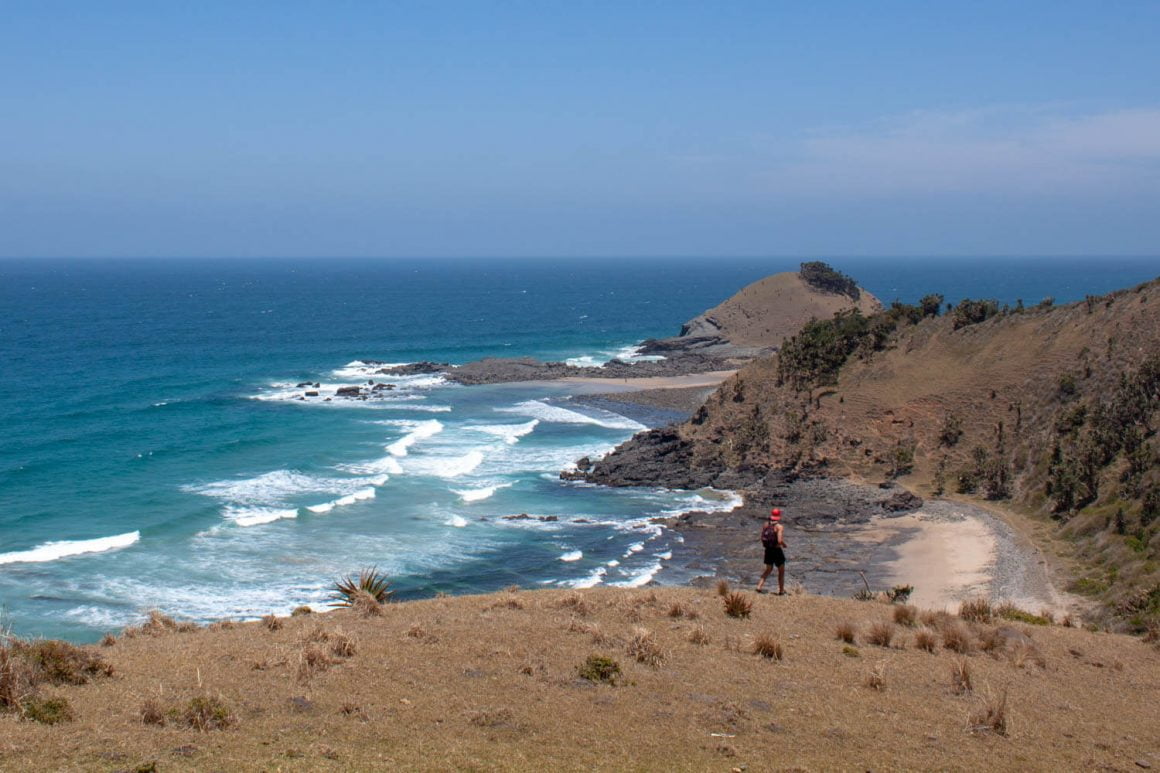
More South African Adventures
Don't miss out.
Please don't tell us you're only coming to South Africa for a Kruger safari.
You'd really be missing out if you did.
South Africa's got so much more to offer. And we're not just talking about Cape Town (…though Cape Town's a big part of it).
Once you make the right decision to explore more of South Africa, make another great decision to bookmark our site and check out our other posts and experiences:
- The Hectic Route – Our detailed 14-day journey from Jo-burg to Cape Town stopping in some of the most magical towns and stunning scenery.
- Cape Town Travel Blog – Our comprehensive, fun, unique, and insider guide to what may be our favorite city to live in in the world.
- Unearthing the Garden Route – Also a 4-part series. We share what other guides don't divulge, tips, and restaurant recommendations for South Africa's version of Hawaii.
Disclosure: Whenever possible, we use links that earn us a cut if you pay for stuff we recommend. It costs you nothing, so we'd be crazy not to. Read our affiliate policy .
3 thoughts on “16 Kruger Safari Tips to See More Animals and Have a Better Trip”
What is your take on the Malaria situation. The write ups everywhere have put the fear in me. HOWEVER – locals over and over have said: you are going for a short time – just cover up and do the bug juice, you'll be fine – none of us do the pills.
NOTE: taking doxy for 38 days with high risk of nausea and diarrhea is not something I look forward to.
Oh this is so useful, thank you! We are heading to Kruger park in April 2024 – 2 families – and have already left it slightly late as we'll be there over Easter. I'm from South Africa and went to Kruger in 1990, but left SA in 2000. So I feel like a foreigner planning!! ha ha Your blog post is well written with some great tips. I'll also check out the other posts of Cape Town and the Garden route, as we'll be doing that too.
Thanks Jo-Anne. Sounds like you're planning quite the epic reunion with SA! Enjoy!
What do you think? (Leave a Comment.) Cancel reply

- Kruger National Park: A Safari Guide
Last Updated on February 24, 2023
This page contains affiliate links. We may earn a referral commission if you make a purchase through the link, without any extra cost to you.
- Kruger National Park, South Africa
Are you looking for an amazing safari experience? You should consider visiting Kruger National Park.
Kruger National Park is located in South Africa and is one of the largest game reserves in the country. The park covers an area of over 19,000 square kilometers and is home to over 147 species of mammals, 114 reptile species, 51 snake species, 49 fish species, and a massive 508 species of birds . These numbers that are unrivaled anywhere else in South Africa.
The Big Five are featured at this park: buffalos, elephants, lions, leopards, and rhinos (both black and white), although the latter is extremely rare. Visitors may see various antelope species, giraffes, hippos, zebras, wildebeest, and hyenas in their natural habitats.
Table Of Contents
A Bucket List Destination
Kruger national park facts, gates at kruger national park, why should i go on safari, kruger safari options, october – december, january – april, what can you expect to see on your safari, what is the cost of a safari in kruger national park, entrance/exit times for kruger national park, entry fees for kruger, how many days should you spend at kruger national park, how to get to kruger national park, which area in kruger to visit, staying safe on your safari, public game reserves vs private game reserves, high-end private lodges in kruger national park, lodges and hotels outside of kruger, what to wear on safari, health risks in kruger national park, what should you pack for your safari, tips for self-driving game drives in kruger national park, our self-drive encounter with rhinos.
A safari in Kruger National Park is one of those incredible bucket list destinations. When most people think of a safari, they picture Africa – and for good reason. Kruger National Park is a paradise for nature lovers, boasting some of the most magnificent animal sightings in their natural environment.
The animals, the game drives, and the weather were all amazing; the entire trip blew our minds time and time again .

- The park covers an area of over 19,000 square kilometers.
- Since 1926, the park has been closed to hunting.
- All of the park’s animals are endangered to some degree and at risk of extinction owing to rampant poaching that continues despite active anti-poaching efforts.
- The Big Five are featured at this park: buffalos, elephants, lions, leopards, and rhinos (both black and white).
- Kruger National Park is one of the best places in the world to see wildlife in their natural habitat.
- The park was established in 1898.
- It is located in South Africa.
- The park was named after Paul Kruger, a Zulu chieftain who led his tribe’s resistance to British colonial domination in the 19th century. Paul Kruger served as the president of South Africa from 1883 to 1900.
- The South African National Parks Act was enacted on May 31, 1926, when Kruger Park South Africa was formed by the merger of the Sabie and Shingwedzi Game Reserves.
- Over 100,000 years ago, there is evidence of homo erectus (prehistoric man) residing in the region.
- Over 300 archaeological Stone Age sites have been discovered.
- Crocodile Bridge Gate, near Komatipoort
- Malelane Gate, near Malelane
- Numbi Gate, near Hazyview
- Phabeni Gate, near Hazyview
- Paul Kruger Gate, near Hazyview
- Orpen Gate, near Klaserie
- Phalaborwa Gate, near Phalaborwa
- Punda Maria Gate, near Thohoyandou
- Pafuri Gate, near Musina
- Giriyondo Gate
Read next – 10 African Safari Photography Tips
If you love animals, then a safari is definitely for you. There’s nothing like seeing these incredible creatures up close and in person. But even if you’re not an animal lover, Kruger National Park is still an amazing place to visit. The landscapes are stunning, the history is fascinating, and the experience is truly one of a kind.
Planning a Kruger safari can be a big task and a bit intimidating, but don’t worry, we’re here to help. In this blog post, we’ll give you all the information you need to plan an unforgettable trip to Kruger National Park. We’ll tell you when to go, what to expect, and how to make the most of your safari experience!
There are a few different ways to go on safari in Kruger National Park. You can choose to go on a self-drive safari, which means that you will be responsible for your own transportation and game viewing. Alternatively, you can book a guided tour with a reputable company. This option is often more expensive, but it will give you the opportunity to have a professional guide who knows the park well.
When Is The Best Time To Visit Kruger National Park?
The best time to visit Kruger National Park is between the months of May and September. This is the dry season in South Africa, which means that there will be less rain and fewer mosquitoes. The weather is also cooler during this time of year, making it more comfortable to spend time outdoors. Keep in mind that because this is the peak season, accommodation and tour prices will be higher.
We visited in September and it was perfect. Animal viewing was fantastic as the trees were bare, so it was easier to spot wildlife.
The temperature can be mild during the day, but it may become extremely chilly at night. This means that your sunrise or sunset game drives will be very cold – bring something warm to wear. You should have blankets in your vehicle, but you will appreciate a sweater too.
This is the beginning of the rainy season in South Africa. Flash rains are likely to bring about a lush jungle that is thicker, making animals more difficult to spot as a result of this.
Spring is a pleasant time to visit. Day temperatures can reach 40 degrees Celsius, and evenings are cooler, but they are not particularly chilly. Spring provides the opportunity to view new babies of all kinds of animals, as well as newborns.
While the rest of South Africa is warming up, Kruger experiences torrential downpours. The scenery comes to life in vivid hues, from the vibrant green of the forest to the deep blue of the waterways and lakes.
This also means that Lodges and camps are the cheapest at this time.
You can expect to see a variety of different animals on your safari, including lions, elephants, rhinos, buffalo, and many others. The best time to see wildlife is early in the morning or late in the afternoon when they are the most active .
The leopards are most active in the early morning and late at night, thus sunrise and sunset tours are popular. Expect to be woken up early and to have some late nights. It can get exhausting, but you will be fueled by all of the excitement!
The cost of a safari in Kruger National Park will vary depending on the type of safari you choose, the time of year you visit, and how long you stay. A self-drive safari is the most affordable option, while a guided tour is the most expensive.
Before you embark on your safari, it’s essential to factor in the cost of Kruger National Park. Here are just a few expenses that should be taken into account:
- Accommodation
- Activities (game drive tours, bush braais etc.)
- Food (self-planning or eating out)
Kruger National Park is open all year round, but the hours vary depending on the season. The park is open from 05:00 to 18:30 in the summer (November to February) and from 06:00 to 18:00 in the winter (March to October).
The gates open just before sunrise and close after dark, regardless of whether you’re a day visitor or stay for an extended period. You may be fined up to $300 if you are late to return to the entrance gate.
You can’t go on solo nighttime drives and need a SANpark game warden to join you.
If you go on drives in the park with official SANpark game rangers, the fees will be included in your drive’s costs.
If you take an independent drive, or self-drive, through the Kruger Park, you’ll have to pay entrance fees.
As Of January 2023, the fees are:
International visitors: R460 per adult per day, and R230 per child per day. This is about £22/USD26 per day, or £11/USD13 per day.
South African Citizens and Residents (must take ID): R115 per adult, per day and R57 per child per day.
You can buy these at the gate by visiting the small adjacent hut and filling in some forms. The SANParks site here has further information on entry fees and other formalities.
As you can see, a trip to Kruger National Park may get costly after several days; nevertheless, it is well worth the effort!
We recommend spending at least three days in Kruger National Park. This will give you enough time to explore the different areas of the park and see a variety of wildlife. If you have more time, we suggest staying for five days or longer.
If you are able to stay at least three days in Kruger, you will be able to enjoy some downtime between game drives. You’ll be amazed at how much wildlife you see from your lodge!
The best way to get to Kruger National Park is by flying into Johannesburg and then renting a car for the drive. The drive from Johannesburg to Kruger takes about five hours. You can also take a bus or a train, but these options are not as convenient.
If you are really looking to splurge, you can also fly into Kruger. The main airports are Nelspruit, Hoedspruit, and Skukuza.
Once you’re in Kruger National Park, it can still be quite a drive to your lodge or other accommodations.
There are a few different areas of Kruger National Park to choose from, and the best one for you will depend on your budget and what type of safari experience you are looking for.
The most popular area is the southern part of Kruger, which is where you will find the majority of lodges and hotels. This area is also the most expensive.
If you are looking for a more authentic African safari experience, we recommend staying in the northern part of Kruger. This area is less developed and thus more affordable. It is also home to a greater variety of wildlife.
No matter which area you choose, you are sure to have an amazing safari experience in Kruger National Park!
We stayed at Jock Safari Lodge and had a safari experience that we will NEVER forget. We cannot recommend Jock Safari Lodge highly enough! The staff, the rangers, the food, the property. It was all incredible.
When on safari, it is important to follow the rules of the park and your guide. Do not get out of the vehicle unless you are in a designated area, and be sure to stay on the trails. Do not approach animals, as they may be dangerous. If you see an animal that you would like to photograph, use your zoom lens.

Kruger National Park is a government-owned organization dedicated to preserving South Africa’s wildlife. Animals are entirely unrestrained in Kruger National Park, which is a national park run by SANparks.
A private game reserve is on privately-owned land and is enclosed by fences. While you may find the same wildlife, the smaller ground area of the private land could mean that you see more animals.
When you visit a private game reserve, keep in mind that you’re not really in Kruger National Park. You’re in the region known as Greater Kruger National Park, which embraces all of the reserves adjacent to the national park as well as those within.
Private game reserves are often limited to luxurious lodges, but public game reserves will have a variety of options to appeal to a wider range of guests.
If you’re looking for a luxurious and intimate safari experience, consider staying in one of Kruger’s high-end private lodges. You’ll find that the accommodations are top-notch, the service is excellent, and the prices are sky-high. But if you can afford it, it’s worth every penny! Top-rated lodges include Lion Sands Ivory Lodge , Sabi Sand Game Reserve, Savanna Private Game Lodge, and Singita Boulders.
For a more affordable option, consider staying in one of the lodges or hotels outside of Kruger National Park. You’ll still be able to enjoy all the safari activities, but you won’t have to pay the high prices of a private lodge.
For our safari, we chose Jock Safari Lodge as we noticed a steal of a deal that we could not pass up, making a luxury safari an affordable one. Jock Safari Lodge is a public game reserve. The property is located in the Kruger National Park and shares a border with the world-renowned Sabi Sands Private Game Reserve, giving Jock Safari Lodge guests the best of both worlds – an authentic African safari experience without forgoing any luxury.
Great lodges to choose from for your safari adventure:
- Jock Safari Lodge
- Needles Lodge
- Maqueda Lodge
- Lukimbi Safari Lodge
- Mbizi-Bush-Lodge
One of the most common questions we get asked is “What should I wear on safari?” The answer is not as simple as you might think. It really depends on the time of year and what part of Africa you’ll be visiting. If you’re going to be in Kruger during the summer months (November to February), the days can be quite hot, so you’ll want to dress in light, natural-fiber fabrics that will keep you cool. Khaki is always a good choice. You should also pack a hat and sunscreen to protect yourself from the sun. If you’re going to be in Kruger during the winter months (March to October), the days can be cool, so you’ll want to dress in layers. A light jacket or sweater is a good idea. You should also pack a hat and scarf to keep yourself warm. In general, you’ll want to avoid wearing anything bright or flashy. Stick to earth tones like khaki, olive green, and brown. Not only will you blend in with your surroundings, but you’ll also be less likely to attract the attention of insects. And speaking of insects, be sure to pack insect repellent! When it comes to footwear, closed-toe shoes are a must. Sneakers or hiking boots are ideal, but if you don’t have either of those, any closed-toe shoe will do. Just make sure it’s comfortable enough to walk in, as you’ll be doing a lot of walking if you do a walking safari.
Remember, your safari is in an open vehicle. The wind might really whip up and surprise you when the jeep starts to move, how chilly it can feel! While your vehicles will have blankets available too, having layers is always the best option!
As with any travel, there are some health risks to be aware of before you go. The most important thing you can do is to make sure you’re up-to-date on all your vaccinations. There are no required vaccinations for entry into Kruger National Park, but the Centers for Disease Control and Prevention (CDC) recommends that all travelers be up-to-date on the following routine vaccinations:
Measles, mumps, rubella (MMR), Diphtheria, tetanus, pertussis (DTaP), Varicella (chickenpox), Influenza, Polio and Rabies, Meningitis, Polio.
Malaria is also a risk in Kruger National Park. The best way to protect yourself is to take antimalarial medication and to use insect repellent. If you’re pregnant or have a medical condition that prevents you from taking antimalarial medication, it’s important to talk to your doctor before you travel.

- Insect repellent – You’ll want to have insect repellent with 30% deet or higher for your African adventure. It is a horrible feeling to get eaten alive by mosquitoes!
- Closed-toe shoes (sneakers or hiking boots) are important to bring because you will be doing a lot of adventuring. Protect your precious toes! Hiking boots are great protection against the elements, especially if you do a walking safari! Ben’s insect repellent works well!
- Layers of clothing (to account for temperature changes) with light, natural-fiber fabrics. The clothing that works for one time of day likely will not work for another.
- A light jacket or sweater for cool evenings – Evenings can get chilly during certain parts of the year, so it’s important to bring something warm.
- Hat and sunglasses
- Sunscreen is a must. The African sun is hot and it is important to protect your skin from the sun’s harmful rays. And, keep the sun off of your face and out of your eyes with a hat.
- Binoculars don’t just magnify your vision, but also bring forth incredible details that you may have otherwise missed. We used our binoculars for more than safari – we utilized them to observe penguins at Boulder’s Beach near Cape Town and on our adventure cage diving with sharks in South Africa ! There are endless opportunities for how you can use your binoculars on a Southern Africa journey.
- Glasses and Sunglasses – Make sure to get the most out of your sightseeing and take in all that you can! If corrective eyewear is part of your daily wear, remember to pack it! Aside from that, don’t forget your sunglasses – the sun can be extremely intense and you’ll appreciate the bit of protection from the glare.
- Camera With A Zoom Lens – When we went on safari, we saw a ton of people holding up their ipads for photos. If you’re going on a life-changing journey like a safari, take proper photography equipment ! Even if you don’t know how to use it perfectly, having a camera and a zoom lens will make all the difference in capturing those special moments. Extra SD cards, an extra set of batteries, and a battery charger should also be packed along for the journey. Capturing impressive photographs while on safari is near impossible with a standard camera phone. You’re spending all that money on a safari, bring a real camera ! Personally, we love Canon photography products. Furthermore, some safari lodges have gone as far as prohibiting camera phones during game drives because poaching is a HUGE problem and geolocations just give poachers a map.
- Any necessary medication – Come prepared!
- A map of the park – If you are self-driving, a map could come in handy!
- Plenty of drinking water and snacks – Do not be without food and snacks while you’re adventuring around Kruger National Park. The drives can be long and far away from the necessities, so stock up that vehicle on a self-drive. You may also want to bring some snacks for your game drive, especially if you have dietary restrictions. If you’re on a game drive with a lodge, expect a stop partway through the drive for some (provided) refreshments.
If you’re planning on doing a self-drive game drive in Kruger National Park, there are a few things you should keep in mind. First, always stay on designated roads and trails. Do not veer off into the bush, as this is dangerous and against the rules. Second, be sure to follow all posted signs and obey all traffic laws. The speed limit in Kruger is 50 kilometers per hour (31 miles per hour), so be sure to drive accordingly. Third, remember that you are sharing the road with animals. Drive slowly and carefully, and always yield to animals. Finally, keep your windows up and your doors locked at all times and fill up with gas when you pass a station. Arrive early as they only let in a limited number of vehicles each day for self-drives.
This will help to keep you safe in the event of an animal encounter. Also, give the animals plenty of space.
We had a day of self-driving around Kruger as we arrived way too early for our check-in. Driving around Kruger National Park, we knew to give the animals a lot of space, and that the animals could cause a traffic jam. We waited and waited for three rhinos to go on their way, and once they started off the road, we slowly continued, driving on the far side of the road to give them extra space. They kept turning around back to the road and bluff-charging us. It was quite the encounter as our hearts skipped a few beats, and we certainly gave them a ton of space! It did not matter how long we sat there to let them move on, or how we waited to give them space, they did not like our presence one bit. After some patience, the rhinos finally decided to move on.
We hope that this guide has helped you plan your safari in Kruger National Park. Have a safe and enjoyable trip!
Love it? Pin it for later!

Latest Posts

17 Awesome Things To Do In Maui

Grasse: The Perfume Capital

Travelling In Scandinavia On A Budget

Journey Under The Sea At Maui Ocean Center
Worldadventurists.

Explore Destinations
- Adventures & Adrenaline 35
- Caribbean 4
- Destinations 477
- Featured 443
- North America 398
- Travel Tips 44
- Wanderlust 14
Maui is a beautiful island located in the Central Pacific, part of the Hawaiian archipelago. It is known for its ...
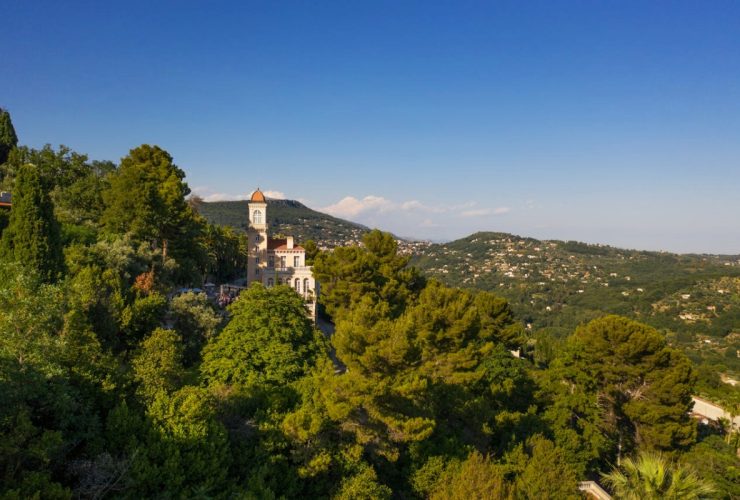
Wearing perfume is a simple act for most people, not realizing the intricate process involved in creating each new fragrance. ...

Journey Under The Sea At Maui Ocean Center Nestled in the heart of paradise, the Maui Ocean Center, the Aquarium ...
TOP DESTINATIONS
- Kruger Park
- Okavango Delta
- Serengeti National Park
- Victoria Falls
TOP COUNTRIES
- South Africa
TRAVEL DEALS
View All Travel Deals
SOUTHERN AFRICA
East africa, indian ocean islands, top experiences.
- Beach Holidays
- Family Safaris
- Honeymoon Safaris
- Desert Safaris
- Luxury Rail Safaris
- Multi-Generational Safaris
- Positive Impact Safaris
- Photographic Safaris
- Walking Safaris
WILDLIFE SAFARI
- Big Five Safaris
- Birding Safaris
- Gorilla Trekking Safaris
- Migration Safaris
- Mobile Camping Safaris
- Horseback Safaris
FEATURED EXPERIENCES
Comfort levels, property types.
- Tented Camps
- Boutique Hotels
Featured Safari Collections
- Elewana Collection
- Ker & Downey Botswana
- Newmark Hotels
- Red Carnation
GET TO KNOW US
- Meet The Team
- Pricing Explained
- Traveller Reviews
- Traveller Stories
- Why Book With Us?
- HerdTracker
- Safari Cost Calculator
- South Africa In 360
- Trusted Safari Partners
What are you looking for?
- Safaris & Tours
- Destinations
- Experiences
- Accommodations
- Why book with us?
Hello traveller!
It's in Cape Town now.
We're sorry. Our safari planners aren't available now. Our office hours are 08:00 - 19:00 (GMT+2).
Call us to speak to an experienced safari planner.
Alternatively, we recommend...
Schedule a phone or Zoom call with one of our safari planners
Complete our travel enquiry form to connect with a safari planner
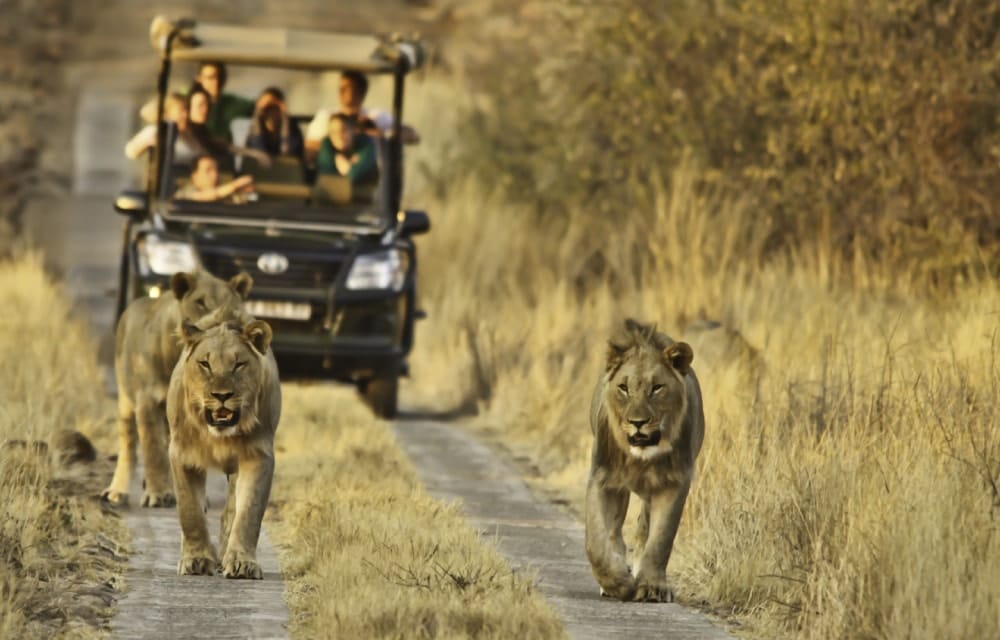
- Kruger National Park Safari
The ultimate guide to your next Kruger National Park Safari
Get to know kruger national park.

By Adelle Belle
Safari Travel Planner
Extending over a similar area to Wales, Kruger National Park is a 20,000km2 (7,722 square mile) national park that supports more than 160 mammal and 500 bird species, including substantial populations of all the Big Five .
The park is an important stronghold for several of Africa’s most iconic large mammals. It supports more than half the world’s remaining white rhinos, along with substantial populations of buffaloes, elephants, black rhinos, leopards, cheetahs, African wild dogs, giraffes, and one of the few viable lion populations in southern Africa.
Birding in Kruger National Park is also excellent, particularly in the summer. Other wildlife you can see at Kruger National Park includes baboons, warthogs, hyenas, many small predators, and around a dozen antelope species.
Kruger National Park Video
- Kruger National Park
How it Works
View our recommended safaris for inspiration and get ready to plan your dream safari
Contact us or fill out an enquiry form and one of our travel experts will help you tailor make your perfect safari
Enjoy an authentic African experience, with peace of mind
Why Kruger National Park?
- One of Africa’s largest national parks
- Big Five viewing , especially rhinos
- More than 517 bird species recorded
- Drive yourself around the public sector or treat yourself to a stay in a private concession.
Where to go in Kruger National Park
- Kapama Game Reserve
- Kruger National Park Concessions
- Makalali Private Game Reserve
Balule Nature Reserve on the western border of the Kruger National park encompasses 400km2 (154 square miles) of unspoiled bushveld. This private nature reserve shares unfenced borders with the Kruger and neighboring private reserves allowing animals to roam freely.
One of the largest rivers in the Kruger National Park, the Olifants River, flows through the Balule reserve, and its waters and riverine forests attract high densities of mammals, reptiles, and birdlife. This means that all the wildlife you see on a Kruger safari, including the famous Big Five, can also be experienced in the Balule Nature Reserve.

Balule boasts a wide range of small intimate lodges and camps that cater to those looking for an affordable private getaway, a family-friendly option , or the ultimate in privacy, comfort, and luxury. All-inclusive stays, as well as self-catering options, are available throughout the Balule reserve.
Highlights of Balule
- Daily game drives and walking safaris with experienced rangers are the best way to spot the Big Five and learn first-hand about the local ecosystem. In Balule, the rangers can track animals off-road (something not allowed in the Kruger) to provide the best sightings.
- There is hardly a more tranquil aerial experience than floating over the African savannah in a hot-air balloon – just one of the activities on offer in the Balule area. If you have the nerves, you can take an adrenaline-filled flight in a microlight aircraft or go white-water rafting. You can book a boat cruise down the Olifants River for a more relaxed afternoon.
- Several lodges offer day trips to the nearby Blyde River Canyon, the third-largest canyon on the planet. It’s a break from the bush life in the Kruger and certainly a bucket list destination.
Practical Information for Balule
- By car, the Balule Nature Reserve is approximately six hours from Johannesburg. Daily international and domestic flights call in at OR Tambo International Airport. You can catch a connecting flight to a local airport (Phalaborwa, Hoedspruit, Nelspruit, or Skukuza) near Kruger. Transfers to and from your lodge (about 45 minutes) can be arranged.
- Temperatures are high during the day, even in winter, so bring sunscreen, a hat, and sunglasses. Light, long-sleeved clothing offers protection against the sun and mosquito bites. Pack warm clothing, too, as evenings can get chilly.
- Wear neutral-colored clothing like brown, khaki, and beige, as bright colors make it easier for animals to spot you. In turn, dark colors like navy and black can attract insects. Balule is in an area at risk of malaria. Get advice from your doctor before you travel.
The 130km2 (50 square mile) Kapama Private Game Reserve lies just west of the Kruger National Park and a mere 10 minutes from the town of Hoedspruit. It is not only home to the Big Five , but the sprawling savannah grasslands and riverine forests straddling the Klaserie River in the east of the reserve see more than 40 species of mammals and over 300 bird species.
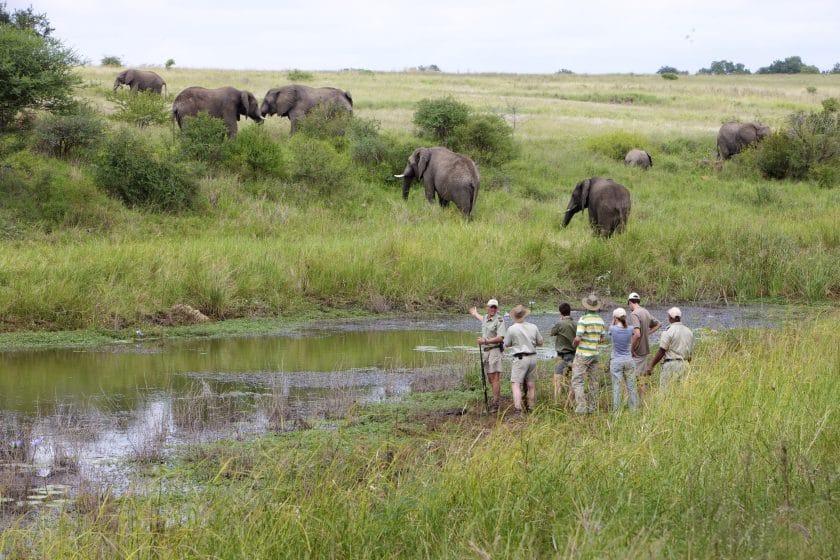
Kapama has four luxury lodges, each with its flair. The bespoke villas overlooking the Klaserie River at Karula are suited to the discerning traveler looking for the ultimate in privacy and comfort.
The River Lodge , with its contemporary design, is a more social space perfectly suited to young couples and groups of friends.
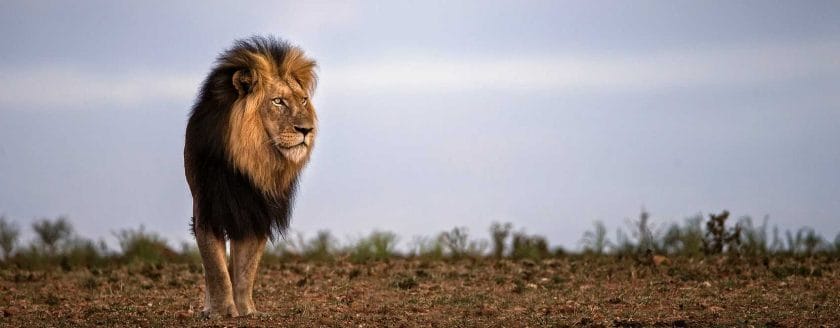
Highlights of Kapama Game Reserve
- Ditch the big vehicles and strap on some walking shoes for a guided walking safari . Skilled rangers will show you wildlife and share traditional knowledge about tracking, medicinal plants, and birdlife .
- Kapama offers a 2-day photography workshop led by a leading African wildlife photographer so you can hone your skills before heading out on game drives aimed explicitly at photography .
- The Romantic Sleepout lets couples experience a night under the stars on a private platform in the African bush. You even get a private chef that will prepare a five-course dinner!
Practical Information for Kapama Game Reserve
- The nearest international airport is OR Tambo International in Johannesburg, about 6 hours travel time from the reserve by car. OR Tambo is serviced by domestic flights from all over South Africa, so you can also fly to Hoedspruit, the nearest local airport to Kapama. From here, it’s a short transfer by car to the reserve.
- Kapama offers the discerning traveler the option of flying directly to the reserve from OR Tambo and Cape Town International airports in a privately owned aircraft.
- Bring warm clothing (it gets cold at night), a hat, sunglasses, and sunscreen to protect against the heat during the day. Wear muted colors like khaki, brown, or green to avoid being easily spotted by animals. Bright colors can attract insects.
- Kapama, like all of the Kruger, lies within a malaria region.
The Klaserie Private Nature Reserve covers a whopping 600km2 (232 square miles) of wilderness on either side of the Klaserie Rivier just west of the Kruger National Park. You’ll come face to face with the Big Five – lions, leopards, elephants, buffalo, and rhinos – as well as some of Africa’s less spotted species, like wild dogs and cheetahs, on your Klaserie safari adventure.
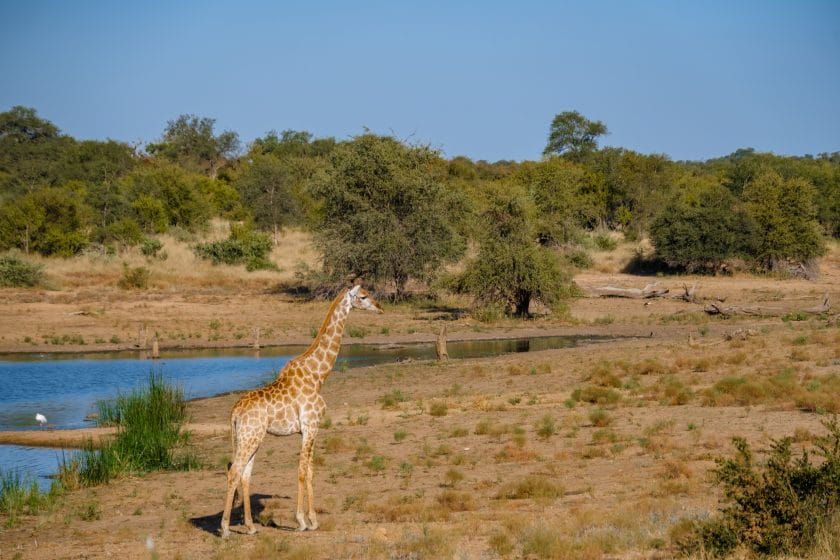
Klaserie’s range of safari camps and lodges cater to families, groups of friends, honeymooners, and discerning travelers looking for exclusive luxury. Families should consider Makumu lodge, where they can book an entire lodge without age restrictions for the youngsters. At the same time, the Klaserie Drift, Senala, and Klaserie Camps offer fully catered or self-catering perfect for couples.
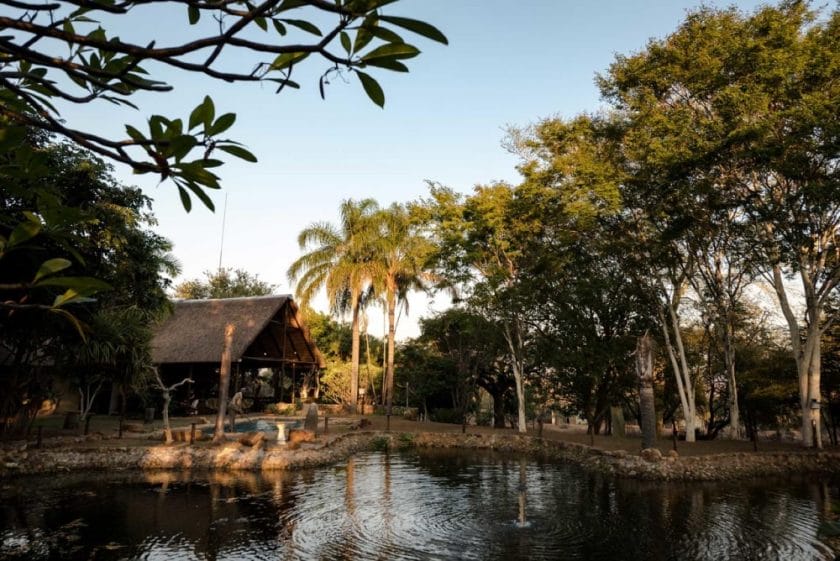
For top-tier luxury, look no further than the intimate riverside suites at Klaserie Sands River Camp or the classy exclusive suites at Baobab Ridge.
Highlights of Klaserie
- Some lodges host bespoke bush dinners and traditional barbecues at particularly stunning outdoor spots in the reserve. You can even arrange to camp at certain water holes for a truly immersive night in the African bush.
- A walking safari with an experienced ranger is one of the most exhilarating experiences in the African bush. You’ll see animals from a unique perspective and be fully immersed in the sights and sounds of the environment.
- Twice-daily game drives in open 4×4 vehicles within the private reserves give you the highest probability of seeing animals. With experienced guides who can drive off-road (unlike in public areas of the Kruger), you’ll tick off Big Five sightings in no time. Some lodges also offer night drives.
Practical Information for Klaserie
- The Klaserie Private Nature Reserve is roughly a six-hour drive east of Johannesburg. Daily international and domestic flights call in at OR Tambo International Airport, where you can catch a connecting flight to a local airport near Kruger. The closest local airport is in Hoedspruit; from there, it’s a 45-minute transfer to the reserve.
- You don’t need special safari clothes, but neutral colors like beige, brown, green, and khaki are recommended. It makes it harder for animals to spot you and be scared off, and brighter colors attract insects.
- Prepare for scorching days and bring a hat, sunglasses, and sunscreen. Depending on the season, nights and early mornings can be freezing, so pack some warm clothing too. Ask a medical practitioner about malaria medication before you leave, as this part of South Africa carries a risk. A course of prophylaxis is recommended.
The Kruger National Park is world-renowned for its spectacular wildlife. It’s the largest nature reserve in South Africa and, indeed, one of the largest on the continent.
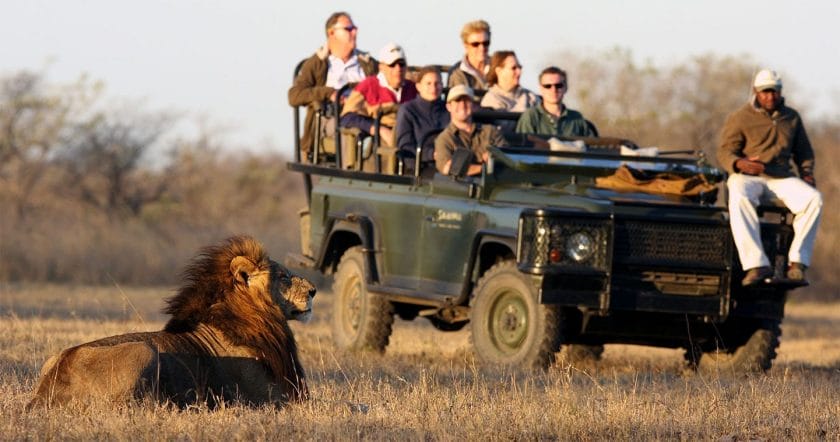
At 360km (224mi) long and 65km (40mi) wide, the surface area surpasses that of the nearby country of Swaziland! Despite its size, the density of wild animals found here is one of the highest on the planet, making for superb viewing opportunities no matter where you are in the park.
The southern and central regions of the Kruger are most frequented by visitors, and for a good reason: the game viewing is most reliable on a safari here. It’s your best bet for lion and leopard sightings, especially common along the Sabie River between Lower Sabie and Skukuza.
In central Kruger, the open grasslands are stocked with plenty of elephants, while grass-feeders like wildebeest and buffalo attract predators like lions, cheetahs, and leopards.
Finally, in the far north, your reward is not only solitude from the crowds of the south but also an area of outstanding natural beauty as the landscape transforms from subtropical to tropical.
Large concentrations of baobab trees are particularly beautiful. Unfortunately, big game sightings are less frequent in this part of the Kruger, although birding safaris , especially in the summertime, are pretty spectacular.
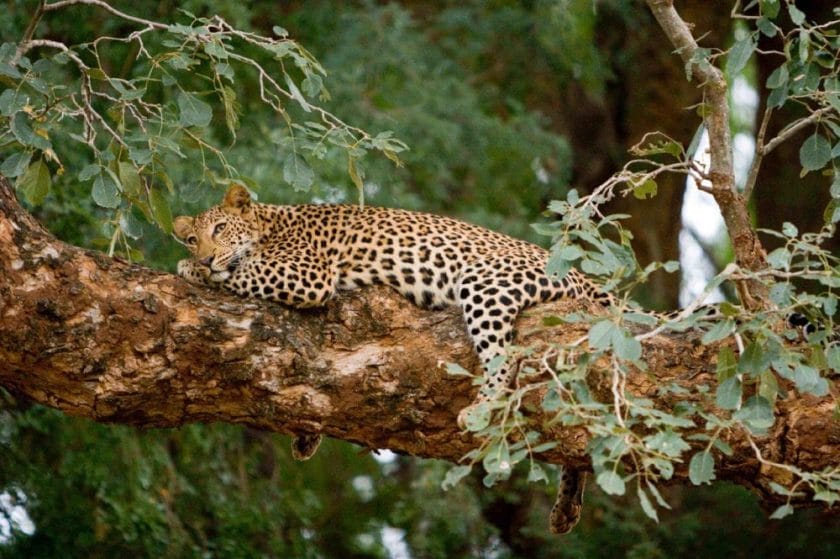
Kruger caters to all, whether you are a solo traveler, a couple on a romantic getaway, or a family looking for the quintessential safari adventure. Several accommodation options are scattered across the park, ranging from campsites to family cottages, safari tents, and exclusive guesthouses.
The main camps are well stocked with modern amenities, and most have shops, restaurants, pools, and fuel stations.
If you’re after total exclusivity or the ideal honeymoon getaway, head for one of the private concession areas within Kruger. Each concession is home to several world-class luxury lodges that provide five-star accommodation and cuisine, personal game rangers, and tailor-made experiences.
Highlights of Kruger National Park Concessions
- The Kruger is one of the few places where you can see the world’s largest land mammals mere meters from your vehicle. The park’s vast network of good roads provides excellent self-drive safari routes.
- The park has a superb avian population (over 500 species!), and keen birders can cross off dozens of sightings during a visit. Keep an eye out for the Big 6: the martial eagle, the ground hornbill, the saddle-billed stork, the kori bustard, the lappet-faced vulture, and the unique Pel’s fishing owl.
- Many guided walking trails , bookable at all main camps, offer a truly immersive bush experience. Hikers are accompanied by experienced armed game rangers who track elephants, rhinos, and lions on foot. Hikes vary from a few hours to overnight excursions with catered dinners and luxury bush tents.
Practical Information for Kruger National Park Concessions
- The Kruger National Park is approximately a five-hour drive from the nearest international airport, OR Tambo, in Johannesburg. Various car rental companies have counters at the airport.
- Alternatively, you can fly to a local airport such as Phalaborwa, Hoedspruit, Nelspruit, or Skukuza and rent a vehicle there. Private lodges offer shuttle services to and from all airports.
- Book well in advance for popular public camps like Skukuza and Letaba during peak holiday seasons in December and July. Avoid the holiday seasons altogether if you prefer fewer fellow visitors.
- Take precautions for sweltering days and cold nights. Bring a hat, sunscreen, sunglasses for daytime temperatures (over 30°C/86°F), and warm clothing for chilly evenings.
- The Kruger is a malaria zone, and it’s advised that visitors take prophylactics. Consult your healthcare professional on a course of medication before you travel.
Makalali Private Game Reserve is located on 260km (162mi) of bushveld near the town of Hoedspruit on the western edge of the Kruger National Park.
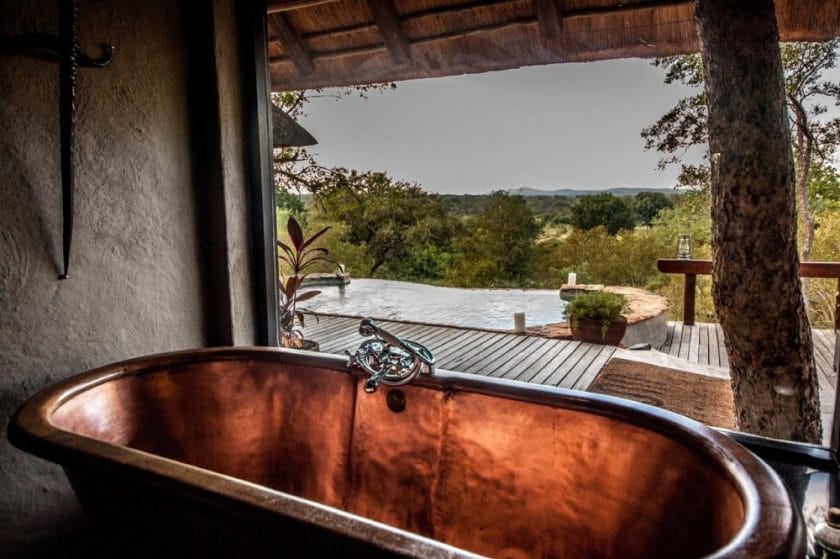
While the styling of the main lodges at Makalali features more contemporary design elements than your typical safari lodge, the wildlife experiences are as quintessentially African as elsewhere in the greater Kruger area.
It’s home to the Big Five and zebra, kudu, cheetah, and wild dog populations.
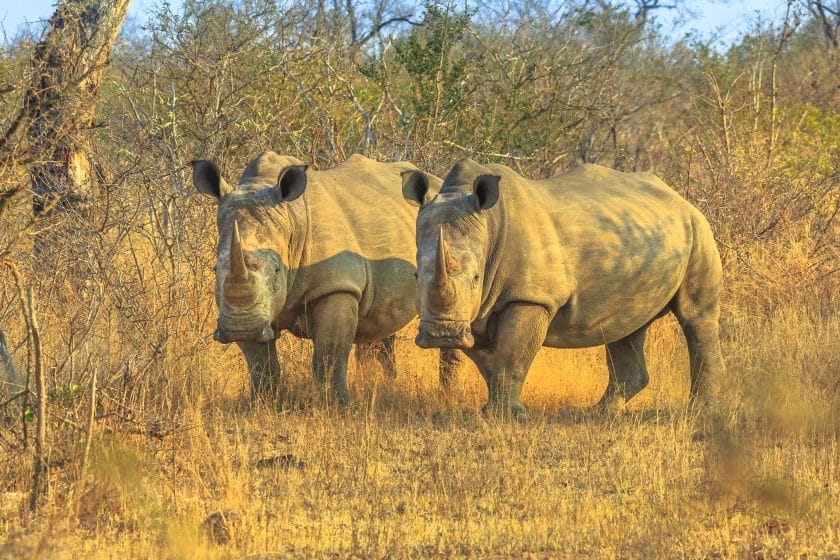
Makalali’s main lodge caters to the mid-range traveler looking for a safari experience with a touch of luxury, while the river lodge is a private 5-star affair. The river lodge also caters to families, as do the more luxurious accommodations at Garonga.
The Little Garonga Camp is an intimate and exclusive affair with only three suites, each with its own platform decks overlooking the bushveld. At the Safari Camp, the setup caters to couples with six private luxury safari tents overlooking a dry riverbed frequented by animals.
Highlights of Makalali
- Nature walks and game drives in open 4×4 vehicles, led by expert guides, are the ideal way to experience the wildlife of the African bush on a safari.
- Take to the skies in a hot-air balloon and experience the stunning African savannah from a unique perspective. The more adventurous can also enjoy flights over the reserve in a microlight aircraft.
- Golfing excursions can be arranged to the superb Hans Merensky golf course next to the Kruger National Park. Wildlife like giraffes and hippos can often be seen on the course.
- The reserve is involved in a cheetah research project, and a visit to the facility allows you to see the world’s fastest land animal up close. African wild dogs, lions, and wild cats can also be seen here.
Practical Information for Makalali
- The nearest international airport is OR Tambo International in Johannesburg. Several daily domestic flights service smaller airports, and it’s possible to fly to Hoedspruit. From here, it’s a short journey to the reserve. Alternatively, some lodges offer direct air transfers.
- Bring warm clothing as it gets cold at night and a hat, sunglasses, and sunscreen to protect against the heat in the day. Dull colors like khaki, brown, or green make you harder to spot by animals and don’t attract insects as much as bright colors.
- Consult a healthcare practitioner about preventative medication, as the Kruger is a Malaria zone.
There are just three lodges in the 23,000-hectare Manyeleti private game reserve on the western edge of Kruger National Park – which means game viewing without the crowds.
With no fences to separate Manyeleti Game Reserve from Kruger National Park and the private reserves Timbavati to the north and Sabi Sand in the south, the game can wander freely.
As you traverse Manyeleti’s 200km (124mi) of gravel roads in search of the Big Five , you’re unlikely to see many other cars – day visitors are not allowed, and each of the three lodges on the concession has just a few beds.
Sabi Sands is often lauded as the most prestigious private reserve in South Africa, perhaps due to the reserve’s longstanding conservation efforts.
The original reserve was proclaimed in 1898, and by 1949 the landowners had merged their properties (mostly ex-agricultural land) into what is now the Sabi Sands Game Reserve .
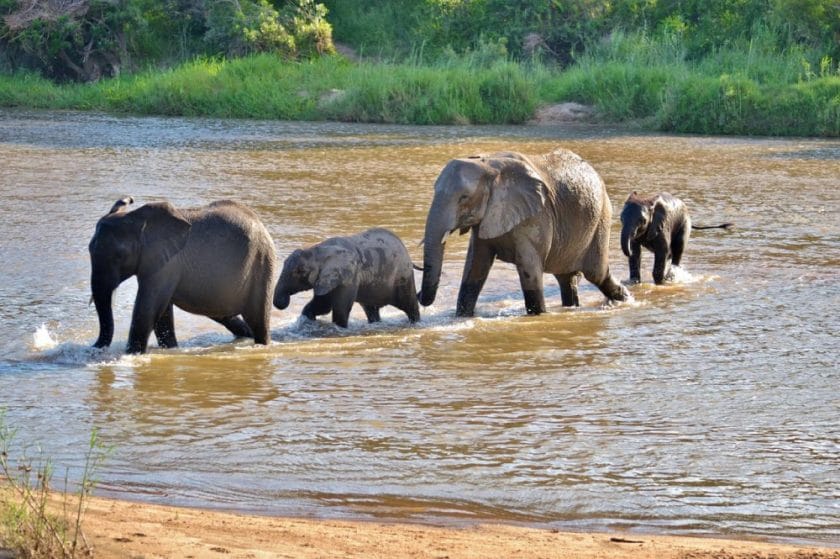
The massive 650km2 (251 square mile) private reserve shares unfenced borders on the western boundaries of the Kruger National Park, allowing animals to roam freely between the reserves.
Thanks to the re-purposing of boreholes previously used for the farms into waterholes for wildlife, Sabi Sands can offer a year-round water source not affected by seasonal changes. This means you’re never far away from spotting the Big Five and the hundreds of other species that make up the greater Kruger population at any time of the year.

Sabi Sands is all about luxury and exclusivity, so you won’t find day visitors, camping, or public picnic sites here. The reserve’s wide range of lodges and camps are styled for every taste – some are very affordable, while others offer the crème de la crème in luxury living. Whether you’re looking for an immersive bush camp, a secluded honeymoon suite, or your own exquisite private villa, Sabi Sands has it all.
Highlights of Sabi Sands
- Sabi Sands is famous for its leopard sightings and although spotting these elusive cats is never guaranteed, with expert safari guides at your disposal, your chances of a great sighting are arguably higher here than anywhere else.
- The reserve has excellent photographic opportunities and guides that understand light, angles, and composition to help you get that postcard shot. Photographic safaris are on offer at several lodges.
- Daily game drives in open 4×4’s and walking safaris by expert guides are included in your stay.
Practical Information for Sabi Sands
- By road, Sabi Sands is approximately 450km (280mi) from Johannesburg, where OR Tambo International Airport is served by daily international and domestic flights to major cities in the rest of the country. From OR Tambo, you can schedule a charter flight directly to Sabi Sands or a nearby local airport (Hoedspruit, Kruger/Mpumalanga, or Skukuza).
- Wear natural colors like khaki, brown, or green to avoid being easily spotted by animals and scaring them off. Remember to bring warm clothing as it gets cold at night and a hat, sunglasses, and sunscreen to protect against the heat in the day.
- Sabi Sands, like the rest of the Kruger, lies within a malaria region. Consult your doctor before you travel, as it is advised to take a course of prophylaxis.
The 140km2 (54 square mile) Thornybush Game Reserve is located near the town of Hoedspruit on the western border of the Kruger. The famous Big Five – lion, leopard, elephant, rhino, and buffalo – roam freely in the reserve while great numbers of plains game like giraffes, kudu, zebra, and waterbuck can also be seen.
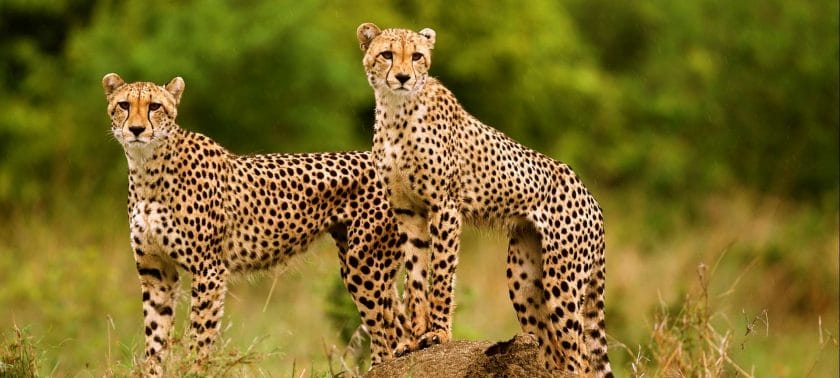
Highlights of Thornybush
- Daily game drives in open 4×4 vehicles with experienced trackers greatly enhance your game viewing experience. Unlike in the public areas of the Kruger, guides are allowed to track animals off-road or at night.
- Photographic opportunities are excellent at Thornybush. Your safari experience, including game drives and walks, can be tailored specifically to meet your photographic needs.
- Guided nature walks allow you to experience the African bush firsthand, and the rangers are keen to share local knowledge.
- With over 300 species in the reserve, birding safaris are excellent. Tailored game drives with an experienced guide will have you tick rare and unique species off your list of bird sightings in no time.
- Extensive conservation studies have been done at Thornybush on the ultra-rare Pangolin. This elusive anteater is the most trafficked animal globally and is critically endangered. While never a guarantee, your chances are good to spot one on a night drive at Thornybush.
Practical Information for Thornybush
- Thornybush is about 5 hour’s drive from Johannesburg. Several daily domestic and international flights depart from OR Tambo International airport. From OR Tambo, you can fly to a local airport (Hoedspruit, Nelspruit, Skukuza, or Phalaborwa) close to the reserve. From here, a short transfer will get you to Thornybush.
- Bring warm clothing as it gets cold at night and a hat, sunglasses, and sunscreen to protect against the heat in the day. Light long-sleeved clothing serves as good protection from the sun too.
- Thornybush is situated within a malaria region. Speak to your doctor before you travel for advice on anti-malaria medication.
Timbavati Game Reserve is home to one of nature’s most magnificent creatures, the white lion. Ancient folklore tells of a time when the local Shangaan tribe saw a bright light streaking across the sky and crashing on the African savannah.
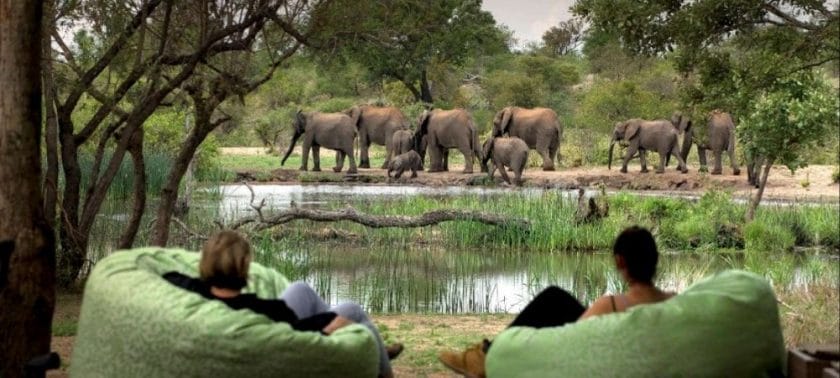
Shortly after that, the lions of Timbavati began giving birth to snow-white cubs. These unique lions have been regarded as sacred ever since.
Timbavati Game Reserve encompasses a vast 580km2 (224 square miles) of savannah on the western border of the Kruger National Park. The borders are unfenced and allow wildlife, including the Big Five , to migrate freely between the reserves.
An abundance of plains game like kudu, giraffe, wildebeest, buffalo, and waterbuck can be seen, while the endangered African wild dog is also often spotted in Timbavati.
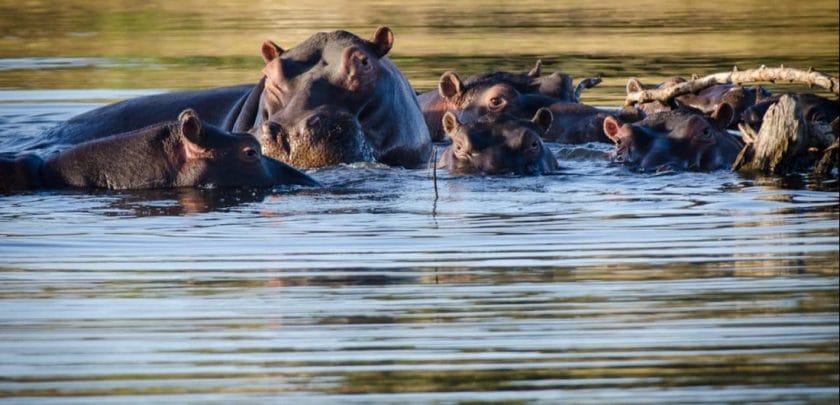
The collection of luxury lodges at Timbavati caters to the traveler looking for a touch of class. Your African safari need not be without spa treatments, private pools, and five-star cuisine!
Walkers River Camp, Jaydee, and Eagle Owl are three exclusive self-catering camps offering families or groups of friends a truly secluded safari experience while still providing all the amenities you’re used to at home.
Highlights of Timbavati
- Timbavati is home to the endangered white lion, and sighting one of these unique creatures is a once-in-a-lifetime experience.
- Photographic safaris can be tailored to your needs. Professional photographers with specialized game-drive vehicles will give advice and tips and can arrange additional gear if needed.
- Daily personalized game drives and bush walks greatly increase your chance of animal sightings. The traditional knowledge shared by the skilled rangers is invaluable too.
- Timbavati is aiding rhino conservation by micro-chipping their rhino population. Guests at the Kings Camp can participate in the tracking and darting process.
Practical Information for Timbavati
- The Timbavati reserve is roughly a six-hour drive from Johannesburg. Daily international and domestic flights call in at OR Tambo International Airport, where you can catch a connecting flight to a local airport (Hoedspruit, Nelspruit, Phalaborwa, or Skukuza) near the reserve.
- Some of the lodges in Timbavati have private runways, and you may opt to travel (approx. 1 hr 30 min) by scheduled flight directly from Johannesburg to your accommodation.
- It gets scorching in the day so bring a hat, sunglasses, and sunscreen. You’ll also need to pack warm clothing, as evenings and early mornings can be chilly.
- Malaria is a risk in this part of Africa, so it’s advised to speak to your doctor about a course of prophylaxis before you travel.
Travel with Confidence
With over 20 years of experience, our team will help you tailor your itinerary to your perfect adventure., 24/7 support, personalized, popular kruger national park safaris, these recommended tours for kruger national park can be tailor-made to match your budget..
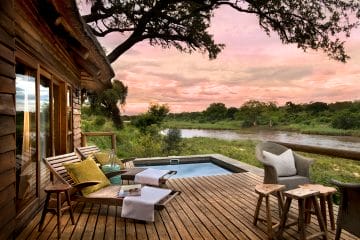
Best of South Africa and Botswana Safari
Southern Africa South Africa Cape Town Kruger National Park Johannesburg Botswana
From $ 7450 /USD

Kruger Safari and Mozambique Beach Combination
Southern Africa South Africa Kruger National Park Mozambique
From $ 4560 /USD
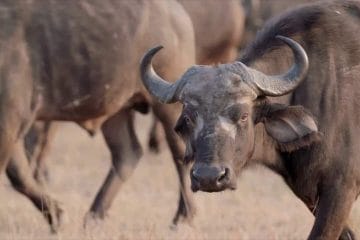
Big Five Safari in Mala Mala
Southern Africa South Africa Kruger National Park Sabi Sands
From $ 3760 /USD
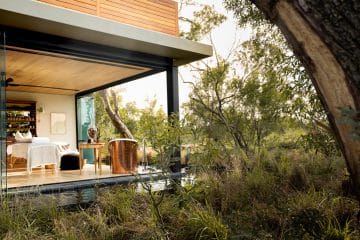
Cosmopolitan Cape Town and Greater Kruger Safari
Southern Africa South Africa Cape Town Kruger National Park Thornybush Johannesburg
From $ 8200 /USD
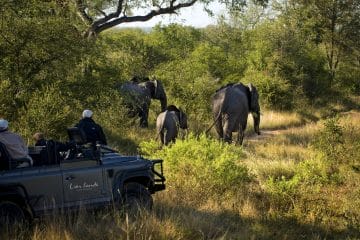
Luxury Kruger Park Safari
Southern Africa South Africa Kruger National Park
From $ 2800 /USD
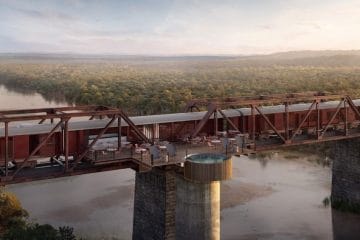
Kruger, Timbavati and the Panorama Route
South Africa Kruger National Park Panorama Route Timbavati
From $ 3980 /USD

15 Kruger National Park Safaris to choose from
Stay for 3 - 14 days
Experience our Tailor-made Tours in Kruger National Park
When is the best month to travel to kruger national park.
- Kruger National Park in January
The Kruger is at its hottest during January. You’ll want to be in the shade during mid-day as temperatures regularly soar over 30°C/86°F. It’s also the rainy season which brings mild humidity and afternoon thunderstorms. Evenings are generally warm and pleasant.
The holiday season in South Africa lasts until the second week of the month, so to avoid the crowds, it’s best to head for the north of the park, one of the private concessions within Kruger, or the several private reserves along its borders.
Besides, the oasis of a luxury lodge is the best place to be in the summer heat. Game drives in these areas deliver better results than self-driving in the Kruger, as the expert game rangers can track animals off the beaten track.
The rainwater turns the African savanna beautifully lush and green, but it also means animals are harder to spot.
More available water keeps them from congregating at larger water holes too. Birding safaris , however, are excellent since large numbers of migratory species can be seen.
- Kruger National Park in February
Daytime temperatures remain in the high 20°C/68°F and can sometimes rise into the mid 30°C/86°F. February sees the last of the summer rainfall, and the occasional late afternoon thundershower can occur. The evening temperatures are usually mild.
Birding safaris are excellent during the summer months, and the far northern regions (Punda Maria and Pafuri) of the park are especially exceptional since they see many migratory species.
Since the vegetation in the park is very dense this time of year, game viewing is better done in the private reserves where expert game rangers can track the animals off-road, something taboo within the Kruger.
Summer weather makes game viewing harder for several reasons: animals have plenty of water and are not drawn to larger water holes, they prefer to stay put in the shade during the day, and thicker vegetation makes them harder to spot.
On the flip side, the greenery is excellent for landscape photography, birding is good, and many summer-born animals can be seen.
- Kruger National Park in March
March is the last of the summer months in the Kruger. While daytime temperatures are dropping, you can still expect hot days, pleasant evenings, and the occasional afternoon thundershower.
March is generally a quieter time in the Kruger than the months leading up to it, so the southern and central regions see much fewer visitors. Head for the roads that run along the riverbanks between the camps of Skukuza and Lower Sabie (Sabie River), Olifants and Letaba (Letaba and Olifants Rivers), and Olifants and Satara (Timbavati).
You’ll see fewer visitors in the Kruger, and the thick green and leafy vegetation make for beautiful landscapes, but it also makes game viewing harder. Furthermore, the abundance of water throughout the park means fewer animals congregate around larger water holes.
- Kruger National Park in April
April brings autumn to the Kruger, and the vegetation in the park gradually fades from lush bushveld to a dry brown and yellow palette.
Rainfall decreases, but the occasional afternoon thundershower still occurs. Daytime temperatures remain hot while nights are getting cooler but not cold.
For the best probability of seeing animals, the private concession areas and game lodges on the western border of the Kruger are a good bet. Here the expert guides can track animals better in the thick vegetation.
April is also the last month in which a birding safari is still good in the northern regions of the park – as soon as winter begins to arrive, the migratory species depart for warmer climates.
April often has good weather with clear skies, so it’s a pleasant month in terms of weather, but the park (excluding private concessions and reserves) gets very busy during the Easter weekend at the end of the month. Finding accommodation in the public camps of the park can be difficult.
- Kruger National Park in May
May heralds the turning point where the Kruger’s climate starts to transition into winter. Towards the end of the month, the rain begins to dry up, and the landscape becomes dry and dusty. Daytime temperatures remain warm and pleasant, while evenings start getting cooler.
Cooler temperatures make venturing to the far north of the park more pleasant, and the thinning vegetation helps in spotting the less dense populations of animals here.
May is generally your last chance to see the landscape flourishing before winter sets in, turning the vegetation dull and brown. However, the central and southern regions see fewer visitors this time of the year and, due to higher populations of animals, still offer the best game viewing opportunities.
Flights tend to be cheaper this time of the year before going up for the June/July holiday season. The park also sees fewer visitors in May.
On the flip side, if you enjoy sweeping green landscapes, this is not the time of the year to visit, as the impending winter season turns the vegetation brown, leafless and dull.
- Kruger National Park in June
June is both the coldest and driest month in the Kruger. Daytime temperatures are mild, and humidity is low, but evenings and early mornings can get quite cold.
The southern and central regions of the Kruger are best for game drives during winter since there are more rivers and other water sources, meaning these regions carry a higher population density of animals.
There are also more accommodation options here (besides camping), and you might be interested in staying indoors in the cold evening weather.
From June onwards, the Kruger’s animals, specifically the elusive big cats, become easier to spot in the sparse vegetation and tend to move around a bit more in the cooler temperatures.
Evenings and early morning game drives are quite cold, and the bushveld is not as pretty as in the summer months.
- Kruger National Park in July
July is second only to June as the coldest month in the year and equally dry. ‘Cold’ in the Kruger, however, only really applies to nights and early mornings since the daytime temperatures are usually quite comfortable and even fairly hot on some days.
The northern parts of the reserve receive fewer visitors, which makes it a good option if you want to avoid crowds. However, there is a greater density of animals in the south, especially when it comes to predators, which makes it your best bet for good sightings. Explore the areas adjacent to the Sabie River: Satara, Skukuza, and Lower Sabie.
The winter landscape is dull and dry, but that’s a good thing for game viewing as the vegetation is sparse and the grass low, making animals easier to spot.
The cooler weather and low humidity make for delightful days in the park. Still, South African school holidays and European summer holidays make July the Kruger’s second busiest time of the year.
- Kruger National Park in August
Things are slowly starting to warm up during August, but rain is still absent, and the climate remains dry. Humidity is low, daytime temperatures sit in the mid 20°C/68°F, and evening temperatures are mild.
August is the middle of the dry season, and water sources for the animals are scarce. For the best game viewing opportunities, it’s best to stay in the central and southern regions of the park, where there are more water sources and a higher density of animals.
August is a good month for game viewing on safari since the rainless winter season thins out the vegetation, making it easier to spot animals. Camping can be uncomfortable in the colder night temperatures.
- Kruger National Park in September
Spring arrives a little later in the Kruger, so the flora does not experience a colourful transformation this month. Vegetation is still sparse and colorless after the rainless winter. Temperatures during the day are hot and humid, with little to no rain expected.
At the end of the dry season in September, the vegetation in the Kruger is at its sparsest. For this reason, it’s the best time of the year to visit the Kruger, and any of the large permanent water holes make for good animal sightings. Stick to the southern and central regions for the highest density of animals.
The risk of malaria is low, and you’re likely to find large concentrations of animals at watering holes at this time of the year, but the days are often uncomfortably hot, dry, and dusty.
- Kruger National Park in October
The first proper rain of the wet season starts to arrive during November in the form of the occasional afternoon thundershower. Expect hot and humid days and balmy evenings.
The southern section of the park has the highest density of animals, and in terms of visitor numbers, November is the calm before the storm of the end-of-year holidays.
The upper central and far northern regions start seeing the first arrivals of migratory bird species and are a good bet for birding-focused safaris .
November is a great time to spot baby animals, and the young impala, one of the most abundant antelope species in the park, is especially cute.
It’s a quieter time of the year, too, as most South Africans plan their visits for the December holidays. On the other hand, humidity is high, and the risk of malaria increases.
- Kruger National Park in November
- Kruger National Park in December
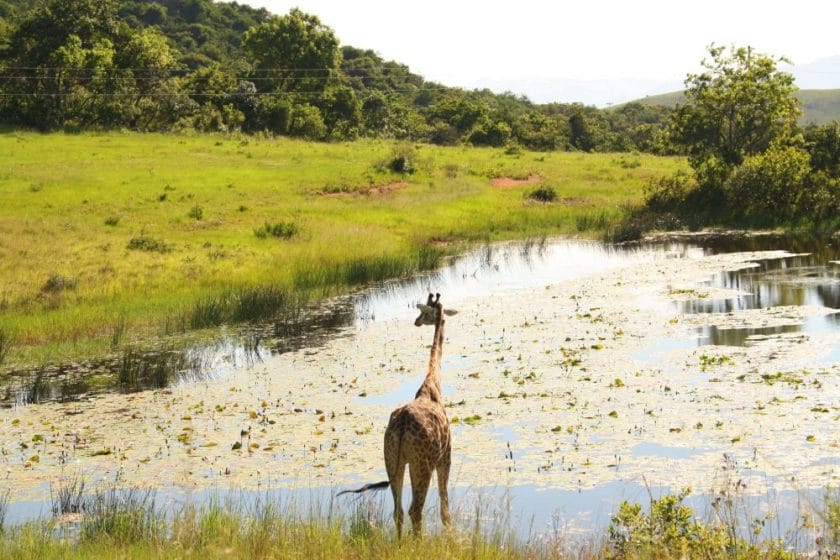
The last month of the year is extremely hot as well as the wettest in the Kruger. Expect plenty of rain with hot and humid conditions as daytime temperatures climb well above 30°C. Evenings can be equally hot and humid.
December is high season, so the whole of Kruger gets pretty busy. Head for the northern parts of the reserve where fewer visitors venture if it is solitude you are after. However the north has lesser densities of animals, so for the best game-viewing opportunities, you might consider the private concessions in the park and the private luxury reserves on the Kruger’s western perimeter. These areas provide exclusivity and much less crowded game viewing.
Many baby animals are born this time of year to coincide with the abundance of water and food sources. This makes for special sightings even though the lush vegetation makes game viewing harder than in winter. The downside is that this is peak season and the park is packed with visitors. Additionally the hot and humid weather might not suit everyone.
Our Recommended Tours in Kruger National Park
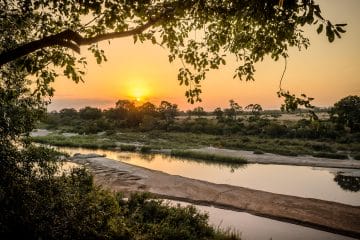
A grandiose journey through Cape Town, the Wine...
South Africa Cape Town Franschhoek Sabi Sands
From $ 14000 /USD
Looking for Something Unique?
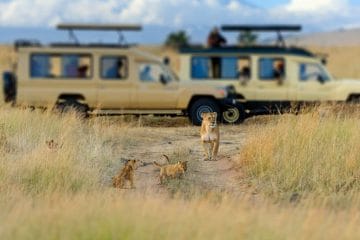
Big Cat Safaris in Africa
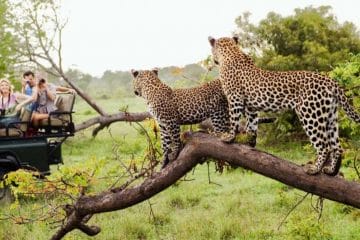
Big Five Safaris in Africa
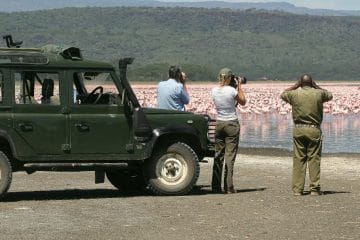
Birding Safaris in Africa
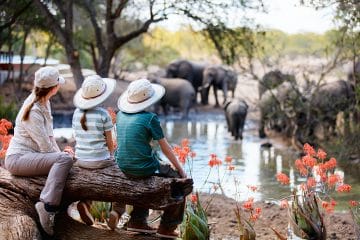
Family and Kid-Friendly Safaris in Africa
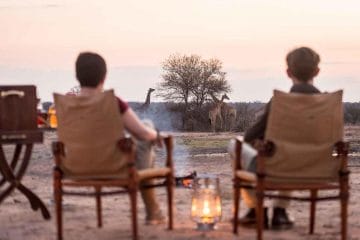
Honeymoons in Africa
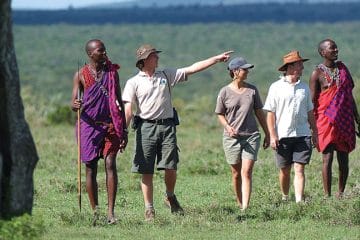
Walking Safaris in Africa
Why travel with us?
Recent reviews from travellers who planned and booked their africa trips with discover africa safaris, adelle bell was most helpful.
Kruger National Park & Sabi Sands Nature Reserve Safari Review
Peter, United States 21 Oct 2023
Life changing experience.
10 Day South Africa & Cape Town Safari Review
Joe, United States 20 Oct 2023
Brilliant. megan was efficient, on the ball and prepared everything..
Vic Falls, Botswana & Okavango Delta Safari Review
Sally, South Africa 09 Sep 2019
Brilliant tanzanian safari.
Family Safari in Tanzania Review
Jeens/Middleton family, Canada 05 Sep 2019
Wonderful service and great adventures.
Discover Africa Safari Review
SBH, United States 29 Apr 2017
Superb service.
Amazing South African Trip Review
Julia, United States 23 Dec 2015
Ready to plan your tailor-made safari.

Devryn Panaino, Safari Travel Planner
Free safari planning advice from destination experts
Faqs about kruger national park.
- Travel along the N1 through Polokwane (Pietersburg). Link up with the R524 at Makhado (Louis Trichard) and follow this route for 140km. This will bring you to the gate.
- Allow 5 to 6 hours for the journey to the gate. Pafuri Border Camp is about 70 kilometres from the gate.
- Allow plenty of time for the drive to the camp, especially if you want to take advantage of the game viewing opportunities!
- Safari/bucket showers are common in mobile or tented camps where there is no permanent plumbing. They are an effective yet environmentally friendly way to shower where water is at a premium and provide plenty of hot water to wash comfortably.
- Generally, there is an en-suite private shower stall within your tent with a “rainfall” style shower head at which you can control the water flow. Outside the tent, there is a large waterproof bag or bucket which is filled with about 10 to 15 litres (5 US gallons) of hot water before being raised with a pully/rope system to either connect to the shower pipe or fill a cistern.
- The water is delivered at the ideal temperature so it is best to use it as soon as it arrives. Staff typically fill the showers at a pre-arranged time of day, or you simply need to give them a few minutes notice so they can get it ready.
- Safari lodges have guest rooms similar to a hotel with en-suite bathrooms. They are comfortably furnished with facilities normally associated with a hotel rooms, except your rooms are normally set in beautiful wilderness settings, with nature and wildlife around.
- Tented lodges have rooms which are tents on a platform and with a roof and also have en-suite facilities with showers, flush toilets and hot water. Basically all the amenities of a hotel room, except canvas walls and roof.
- The boutique lodges and camps can be very stylish and smart in terms of design and decor, often with very spacious rooms and even going so far in some cases as having plunge pools for each room.
- Eco-camps and smaller tented camps have insect-proof tents with en-suite facilities including a safari shower and flush toilet. They give a more authentic safari experience but the tents are comfortably furnished with proper beds and you don’t need to bring your own sleeping bag! The emphasis is usually on having excellent guides and great wildlife viewing away from the crowds. Guests often eat together and people travelling alone usually say that they found the atmosphere friendly and enjoyed meeting other like-minded travellers around the campfire in the evening or at dinner.
- The Adventure Camps are a budget option with guests bringing their own sleeping bags and towels. Accommodation is in small dome tented with a mattress on the floor. Each tent has its own nearby cubicle with a flush toilet, safari shower, and wash basin. The Adventure Camps are suitable only for those who don’t mind “real camping” and can put with some degree of “roughing it”. Apart from the accommodation in simple dome tents, the meals and the guiding are the same standards as the higher quality camps and game drives are in 4x4 safari vehicles. For those on a limited budget, the Adventure Camps are a good alternative to the big tourist lodges and minibus tours for those for whom the safari experience is more important than hotel accommodation.
- Most lodges and hotels will have safes for your valuables either in your room or at the reception.
- The local currency is the South African Rand (ZAR). There are numerous currency exchange outlets and the main credit cards (Visa, MasterCard, Amex and Diners) are normally accepted everywhere.
- Most petrol stations and toll roads take credit cards, but always have a small amount of cash on you for tips etc. Numerous ATMs can be found in all the big towns.
- Electricity in Botswana, Kenya, Namibia, South Africa, Tanzania, Zambia, Zimbabwe and in most of the continent is 220/240 volts.
- Most safari lodges and camps are not connected to an electrical supply. Solar lighting (backed up by batteries) is common, with many lodges having a generator, which runs part of the day (morning and late evening when guests are out on their activities).
- Lanterns also provide light at night. In many camps running on solar power, you will not be able to use a hairdryer.
- Some areas won’t suit the family and it's also wise to be aware of malaria in others, however, South Africa has a few malaria-free safari locations and there are other safari lodges and bush camps throughout Africa that cater to young children and toddlers, just do the research beforehand.
- Southern Africa is a hot wildlife destination. There is a world of luxury bush camps, lodges and Eco-friendly tourist establishments in the heart of wildlife heaven.
See Kruger National Park in Your Comfort
- Affordable Safaris in the Kruger National Park
- Budget Safari in the Kruger National Park
- Luxury Safari in the Kruger National Park
The Kruger National Park offers a surprising array of mid-range safari options for the traveler who wants to avoid roughing it but is not partial to having the utmost in luxury.
Part of making your visit to the park more affordable lies in how you put your trip together: shave off a spa treatment here and a five-course dinner there, and soon you’re left with most of the luxury but much less of the cost one on your affordable Kruger Safari trip .
Instead of taking a charter flight or shuttle service directly to your lodge, hire a car at the airport and make a road trip out of the journey to the Kruger National Park.
The world’s third largest canyon, the Blyde River Canyon, is en route to the Kruger and certainly worth a visit, not to mention other nearby sites like Sabie’s Waterfall Route and the quaint village of Pilgrim’s Rest.
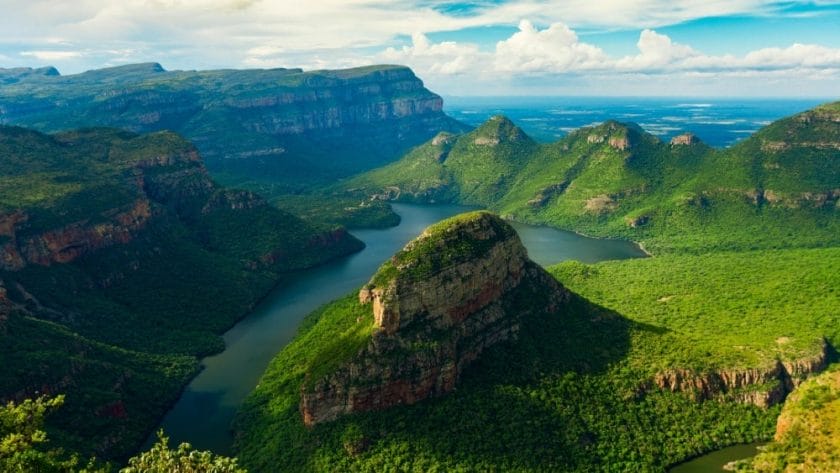
A great way to enjoy the Kruger National Park is to split your stay between one of the public camps of the park and a lodge within one of the private concession areas. This means you’ll have time to enjoy self-drive safaris in the park, which is a great hands-on game-viewing experience.
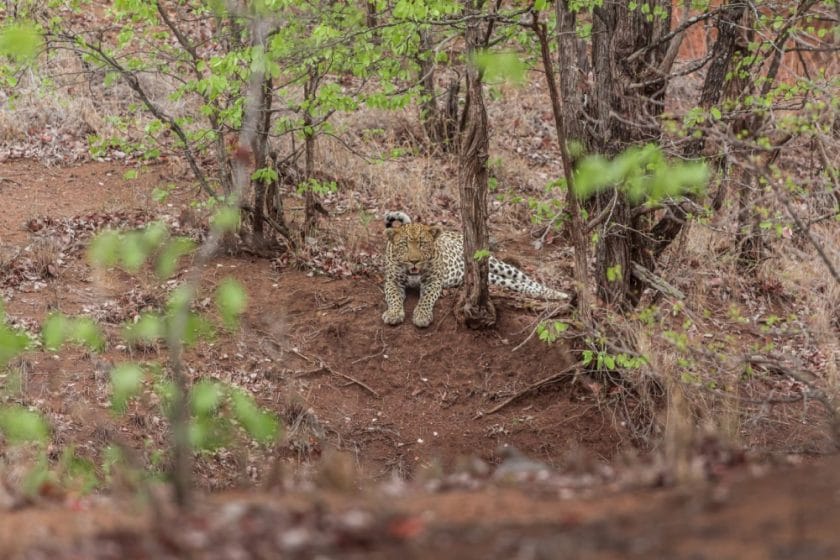
Once within the exclusive concession area, a seasoned guide will use their expertise to show you the very best of the African bushveld. As a bonus, these guides are allowed to conduct game drives outside of their concessions into the park’s public areas to give you an optimal chance of spotting elusive species such as the enigmatic leopard.
Several of the private luxury reserves along the unfenced western border of the park, known as the Greater Kruger, contain affordable lodges, guest houses, and tented camps aimed at a mid-range budget. Self-catering is an option in some of the camps and guest houses, many of which you’ll have exclusive use of if you book the whole camp or house.
Stay at these, and you’ll save on some of the over-the-top frills while enjoying treats like guided game drives and walking safaris . Here guides are allowed to track animals off-road and at night – something you are not allowed to do on your own in the public areas of the Kruger.

Practical Information for Affordable Safaris in the Kruger National Park
- Travel in the off-season when both flight and accommodation prices are lower. The winter season (May to September) is less busy in the Kruger yet still excellent for game viewing. Keep an eye out for package deals, as many of the lodges offer free nights and discounted offers.
- Rent an SUV or a 4×4 vehicle , as the added height is helpful for game viewing, especially in the summertime when the grass in the Kruger stands tall. The extra interior space is also welcome on long drives and for luggage storage.
- Several rental companies offer fully kitted vehicles that are camp-ready with rooftop tents, awnings, kitchen setups, chairs, and tables. Larger vehicles also cater to groups or families.
- Staying just outside one of the park’s main gates – in Hazyview, Phalaborwa, or Nelspruit, for instance – and making day trips into the Kruger is often comparatively more affordable.
The Kruger National Park is certainly the most well-suited safari destination for budget-conscious travelers. More than a century of conservation efforts have ensured that the magic of the African bush and its incredible wildlife is accessible to all who visit the Kruger.
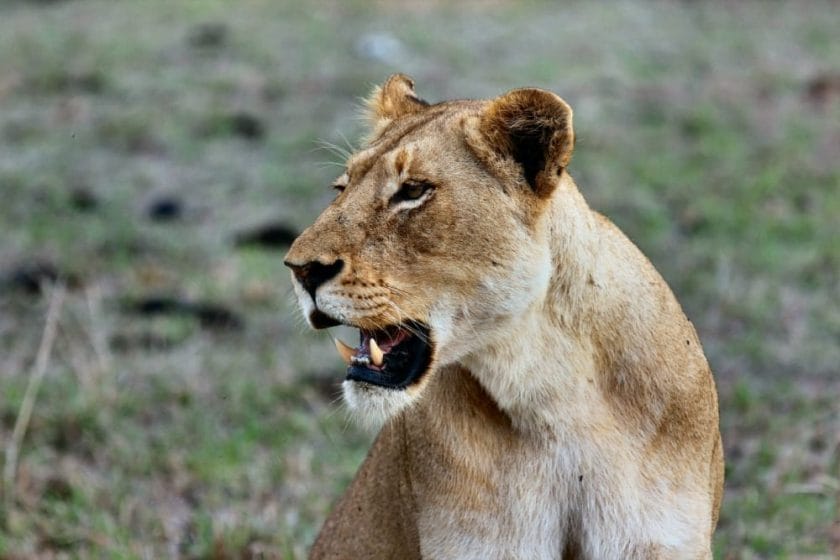
Getting to the park is easy – from the nearest international airport, OR Tambo International in Johannesburg, a comfortable drive along the N4 highway will get you there in under five hours. All major car rental companies have counters at the airport offering a comprehensive range of rental options.
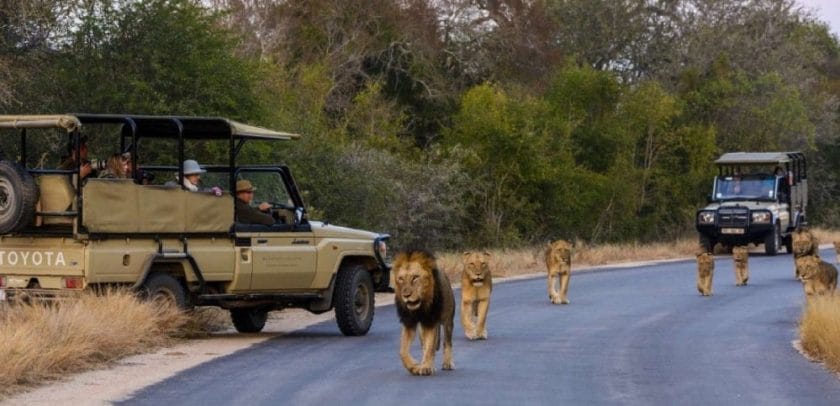
One of Kruger’s best features for those on a budget is that you can conduct game drives in your own vehicle. The well-maintained road network (mostly tarred or good gravel) within the park means you don’t need to hire an expensive 4×4 – a regular hatchback or sedan will do the job on your budget Kruger safari tour .
The cost of accommodation usually takes a large chunk out of any travel budget, but luckily the Kruger has a wide range of affordable accommodation options throughout the 19,485km2 (7,523 square mile) park.
The southern regions around Lower Sabie, Skukuza, Berg-en-Dal, and the central regions near Letaba and Satara offer more bang for your buck in terms of facilities and game viewing opportunities.
These regions are also more easily accessible than the far north, meaning that you spend less time traveling to and from your destination and more time experiencing wildlife or leisure time at camp.
Camping is the most affordable accommodation option. The Kruger main camps have ample facilities such as restaurants, swimming pools, and grocery shops that make for a most comfortable stay without breaking the bank.
Traveling in the Kruger on a budget doesn’t necessarily mean you have to camp, as many camps also offer reasonably priced safari tents, chalets, and guesthouses. These are excellent options for groups of friends and families.
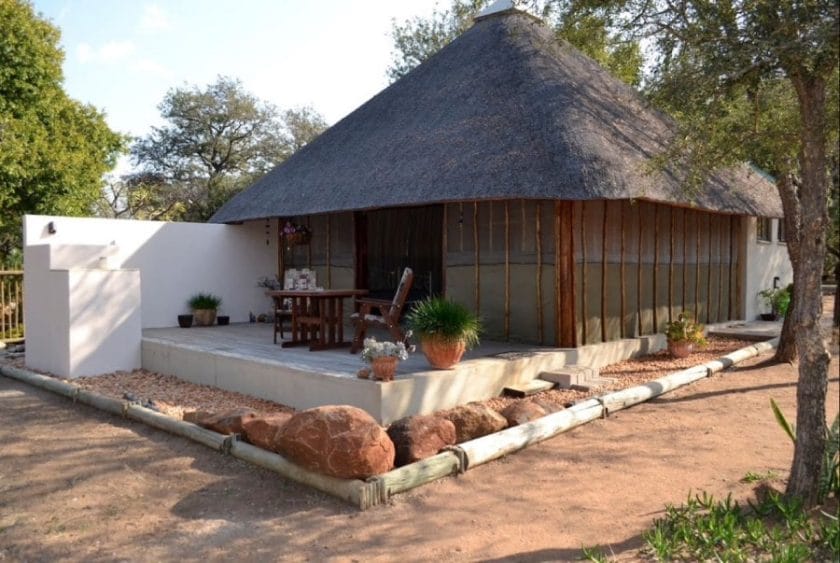
While there is no denying that a luxury safari lodge is an experience bar none, there is plenty of benefit in a more hands-on approach. You curate your experience by setting your own schedule, planning daily excursions, and seeing the Kruger the way the locals do.
Travel Tips for Affordable Safaris in the Kruger National Park
- Book accommodation well in advance if you plan on traveling during Easter, the school holidays in late June/early July, or the month of December. The park is at its busiest during these periods.
- Many car rental companies offer camping-ready vehicles that are fully kitted with all equipment needed for setting up a campsite. This is a much more convenient option than sourcing camping gear separately.
- The park offers guided bush walks from all the main camps, which are an exceptional way of experiencing the wildlife of the Kruger. Game drives in open 4×4 vehicles are also on offer and are an excellent way to supplement your own game viewing.
- Several overland and hop-on-hop-off bus tour operators offer all-inclusive travel packages to the Kruger National Park. These tours typically include transport to and from major cities, accommodation (camping) in the park, and game drives.
The Kruger National Park consistently ranks among Africa’s best luxury safari destinations. The private concessions and game reserves here spare no expense when it comes to absolute opulent living in the heart of the African bush.

While the vast expanse of the Kruger National Park public areas is meant to cater to all, you’ll want to head to one of the private concession areas if all-out indulgence is what you’re after.
Here all your needs are taken care of from the moment you set foot in these exclusive sections of the park to the moment you leave. The concessions are set in prime Big Five country and are unfenced, meaning you can experience exceptional game viewing minus the crowds.
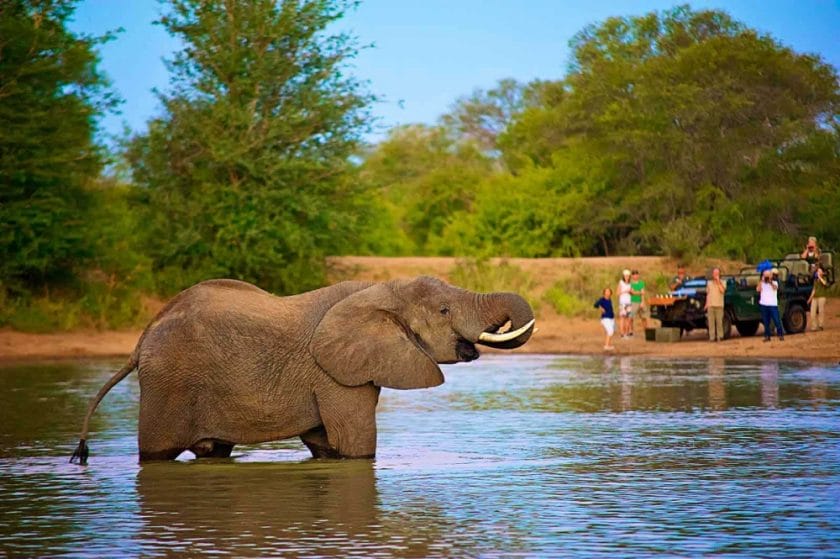
The private game reserves on the western perimeter of the Kruger, many of whom share unfenced borders with the park, are arguably a step up from the concession areas. The lodges, luxury tents, and villas are set in the most spectacular environments possible, and the views from your suite or villa are often worth the trip alone.
Most lodges offer personal guides, housekeeping staff, and chefs and customize your stay according to specific needs. Expect private swimming pools, wine cellars, libraries, rooftop viewing areas, five-star spa treatments, therapeutic massages, and wellness centers.
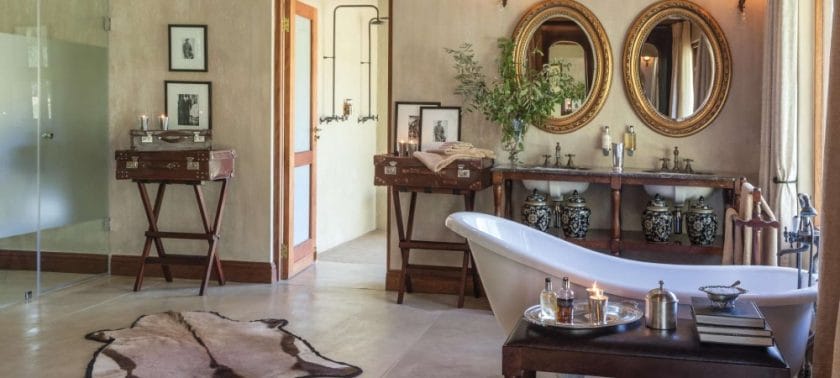
Both the concession lodges and private reserve lodges offer activities not found elsewhere in the park, such as nighttime game drives, off-road tracking of animals, and activities specifically developed for children. Several lodges offer tailor-made experiences that might focus on photography , romantic getaways , birding , and even fine dining.
Speaking of dining, the luxury lodges’ cuisine is world-class with a distinctive African flair. What’s more, meals are often set in spectacular bush settings.
Ever had breakfast while overlooking a waterhole teeming with wildlife? How about high tea under an ancient African acacia tree? You simply must try a lavish five-course dinner prepared by your personal chef with the Milky Way shimmering over an atmospheric lantern-lit banquet.
- Most lodges offer direct air transfers to and from the nearest international airport, OR Tambo, in Johannesburg. However, some lodges offer direct or connecting flights from other popular destinations such as Cape Town , Victoria Falls , Vilanculos , and Mauritius .
- Speak to a dedicated safari expert who’ll curate your Kruger National Park safari , as well as connecting destinations, to your specific needs. There’s no better way to distill the myriad of options in the Greater Kruger to your personal itinerary, budget, family size, and expectations.
- Several lodges offer private and secluded villas for exclusive use. This option caters to the discreet individual, couple, or family by providing personal housekeepers, chefs, and game rangers for your stay.
- A host of personalized activities and excursions in the Greater Kruger and nearby regions can be arranged from your lodge. These include, but are not limited to, helicopter, hot-air balloon, and microlight flights over the stunning Blyde River Canyon, golfing at the world-class Hans Merensky or Leopard Creek Golf Estates, and customized photographic , horseback and birding safaris .
Holiday Styles and Options in Kruger National Park
- Romantic Safari in the Kruger National Park
Picture this: A red sun kisses the horizon as the last rays of daylight bathe the camelthorn trees around you in a warm glow. At the waterhole in front of you, a mother elephant helps her newborn take a mud bath while an elegant giraffe kneels nearby for a drink.
You sip a sundowner and watch as a troop of baboons grooms each other, a pod of hippo snort in the water, and a herd of impala antelope nibble away at an early dinner on a grassy embankment. As the day’s heat fades, a palpable serenity descends on the world, and another glorious African day ends.
This is not just some idyllic scene from a nature documentary; this is daily life in the Kruger National Park.
It’s easy to see why the Kruger National Park is consistently rated as one of the top safari destinations in Africa. The enormous 20000 km2 (7,722 square mile) park is not only home to the famous Big Five (elephant, rhino, cape buffalo, lion, and leopard), but it also boasts an incredibly diverse African savanna biome.
More than 140 species of mammal, including oddities such as the shy aardvark and the fierce honey badger, call it their home, while over 300 species of trees stand proudly scattered across the landscape.
The Kruger National Park is a birder’s paradise , so be sure to pack your binoculars and keep an eye out for a large variety of raptors, vultures, storks, kingfishers, and weavers among the 500-odd species.
Each season brings its own flavor to the Kruger, changing the features of both the landscape and animals, meaning no two visits are alike. Summers are hot, humid, and full of rainfall that drapes the landscape in a lush green grassy cloak. Winters are a dry affair but much cooler and excellent for game viewing.
While wildlife is certainly the main attraction, the Kruger has another major drawcard: its world-class lodgings. Since becoming South Africa’s first official national park in 1926, the Kruger has systematically established a wide range of accommodation options in a dozen main camps, several bushveld camps, private lodges, and four remote satellite camps.
Whether you fancy camping, self-catering cottages, family units, guest houses, luxury lodges, or even your very own private villa, you’ll be spoiled for choice throughout the park.
Besides the accommodation within the Kruger , a host of private game reserves on the park’s western perimeter share unfenced borders with the Kruger, which means you can also experience the park’s abundant wildlife from several exclusive 5-star luxury safari lodges.
Here you’ll enjoy everything from personalized game-viewing experiences and spa treatments to exceptional cuisine and more, all with little to no other visitors.
Ease of access completes the trifecta of Kruger’s best features. The park lies a mere four to six hours from the nearest international airport (OR Tambo in Johannesburg), making travel to and from the reserve a breeze.
You can even travel via a charter flight and cut travel time to under two hours. An extensive network of tar and good gravel roads makes it easy to get around in the park. You won’t need a 4×4 or a GPS to find your way here.
The Kruger National Park is a place that you can visit for a lifetime without ever running out of sensational experiences. Thanks to nearly a century of conservation efforts, Mother Nature’s circle of life remains largely untouched in the reserve. Best of all, you can easily and comfortably observe it without needing a David Livingstone-style expedition.
The Kruger is, without a doubt, a place where the warm heart of Africa still beats strong. Spend enough time here, and you’ll soon find your own heart beating to the same rhythm.
There is something intrinsically romantic about the African savannah, one of the last vestiges on Earth where the majesty of nature so effortlessly inspires a sense of connection. It’s no wonder the Kruger National Park is the quintessential South African safari destination for couples.
The park’s proximity to the OR Tambo International Airport in Johannesburg (only a 5-hour drive away) means that you could arrive in South Africa in the morning and watch the sun set over the African savannah by the end of the day.
All major car rental companies have counters at the airport, and self-driving allows adding other scenic destinations, like the Blyde River Canyon, on the way to the Kruger. Alternatively, scheduled flights to local airports near the Kruger cut travel time significantly.
The budget-conscious traveler might choose to stay at one of the various self-catering chalets, guest houses, or lodges and do self-drive game viewing in a rental vehicle.
However, for the ultimate in privacy and luxury, it’s best to head to one of the dozen-or-so private concession lodges within the Kruger or the collection of private luxury reserves on the western edges of the park.
Here you’ll enjoy opulence to the finest detail. Secluded suites with sensational views, private pools, outdoor rose (or champagne!) baths, and exquisite cuisine set the scene for the best romantic getaway.
Several private game reserves offer treehouse experiences: a night under the stars on a secluded raised platform in the bush. There’s no better way to spend an evening with a loved one, not to mention the fine dining provided by your own personal chef.
Speaking of meals, why not try traditional gourmet cuisine under the open African sky? Various lodges offer a bush banquet set in the open bush framed by lantern light and the Milky Way overhead.
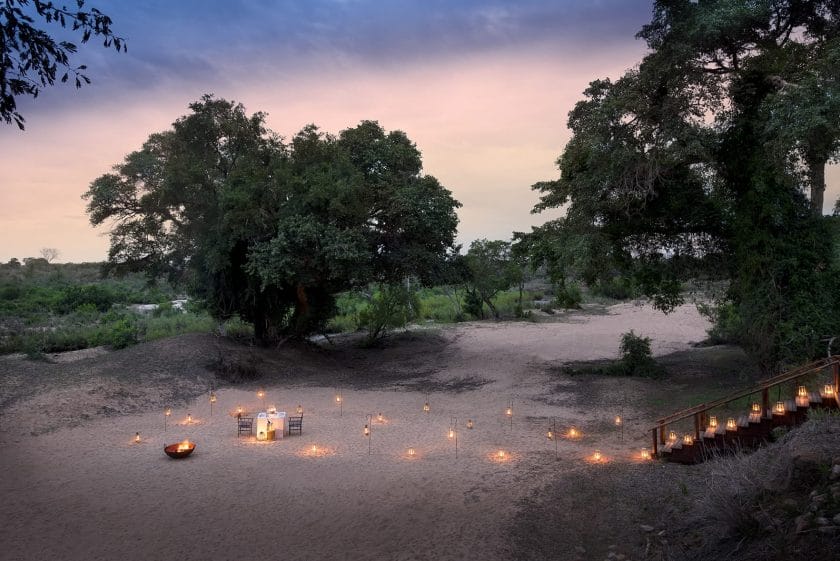
Many couples-orientated packages at the luxury reserves include personal game drives and bush walks with an experienced game ranger who will tailor the experience to your preference, such as photography , birding , or spotting rare species at night.
Spa treatments are a quintessential luxury on any honeymoon, and when you stay at one of the luxury lodges, you can expect the very best. Want to keep active during your stay? Most lodges offer gyms, yoga classes, and wellness centers.
Travel Tips for a Romantic Safari in the Kruger National Park
- Most of the luxury lodges offer all-inclusive packages specifically aimed at couples. Book one of these, and you won’t have to worry about a thing from start to finish. Honeymoon packages that include activities and experiences aimed explicitly at couples are often offered at a discount.
- Combine a trip to the Kruger with a visit to one or more of Southern Africa’s other top attractions like Cape Town , Victoria Falls , and Mauritius . Several lodges and tour operators offer such combo packages.
- Scheduled flights from OR Tambo arrive and depart daily from local airports (Hoedspruit, Nelspruit, Phalaborwa, or Skukuza) near the Kruger, which cut travel time to under 2 hours. From here, a short transfer gets you to your lodge. Several lodges have private airstrips, so direct flights are possible too.
Who is Travelling to Kruger National Park with you?
- Family Safari in the Kruger National Park
- Solo Travel in the Kruger National Park
The Kruger National Park sits right at the top of family-friendly safari destinations in South Africa. The park prides itself on being accessible to young and old alike, and many South Africans will confess to cultivating a life-long love for the African bush from an early age in the Kruger.

A family holiday in the Kruger is best done in one of two ways; either self-driving or choosing an all-inclusive package at a private lodge. Both options have their own unique appeal depending on the type of holiday experience you’re after.
Long hours in the car are always a concern when traveling with children, but the Kruger is only an easy five-hour drive from the nearest international airport in Johannesburg. All major car rental companies have counters here and offer vehicles suited to families. Alternatively, you might opt for a shuttle service when staying at an all-inclusive luxury lodge.
En route to the Kruger National Park, whether self-driving or by lodge transfer, there are plenty of rest stops, and you can even turn it into a scenic road trip of sorts by including some of the sights on the stunning Panorama Route. Once inside the park, the vast network of good tar and gravel roads makes getting from one place to another equally comfortable.
Exploring the park in your own vehicle means your family stays together, and you can plan outings according to personal preference. If you’re traveling with toddlers, this is the only way you can take them on game drives in the reserve, as children under the age of 6 are not allowed on the game drives in open 4×4 vehicles (for safety reasons) provided by the park. Similarly, only children over 12 may join guided bush walks .
The southern and central regions of the park are more family-friendly than the far north since distances between rest areas are not so spread out, the landscape is more varied, and animals are more abundant. Skukuza, Satara, Lower Sabie, Letaba, and Berg en Dal camps are superb family-oriented accommodation options since they offer restaurants, shops, swimming pools, child-friendly activities, museums, and movie screenings.
Although staying at a luxury lodge is naturally more costly, the experience is more personal with offerings such as private family villas, your own guide in an open 4×4 game viewing vehicle, and special activities for children.
Travel Tips for Family Safari in the Kruger National Park
- Rent an SUV or a 4×4 with good ground clearance for your visit to the park. The additional vehicle height makes for better game viewing, and the extra space will come in handy for luggage and make the time spent in the back seat more comfortable for the youngsters.
- Some rental companies offer fully kitted camping vehicles with enough equipment and tents for the whole family. This is a great all-inclusive option if you plan on camping in the Kruger. The kids might not like getting up early on holiday, but it’s worth it in the Kruger. The early mornings are best for game viewing, not to mention cooler than during the day. The same goes for late afternoon game drives.
- Grab a park map at an entrance gate or a camp shop. You’ll need it to navigate the park when self-driving.
- When traveling with small children, bring some games, puzzles, and books to entertain them during leisure time in camp or long drives in the car.
- All the main camps have restaurants with reasonable prices and small shops for self-catering, so there’s no need to over-pack your car with food supplies.
There is a very particular kind of adventure that comes with solo traveling. It takes you to unimaginable new places, experiences, and people and also affords the opportunity for calm, uninterrupted self-reflection. The vast expanse of the Kruger National Park offers you plenty of both.
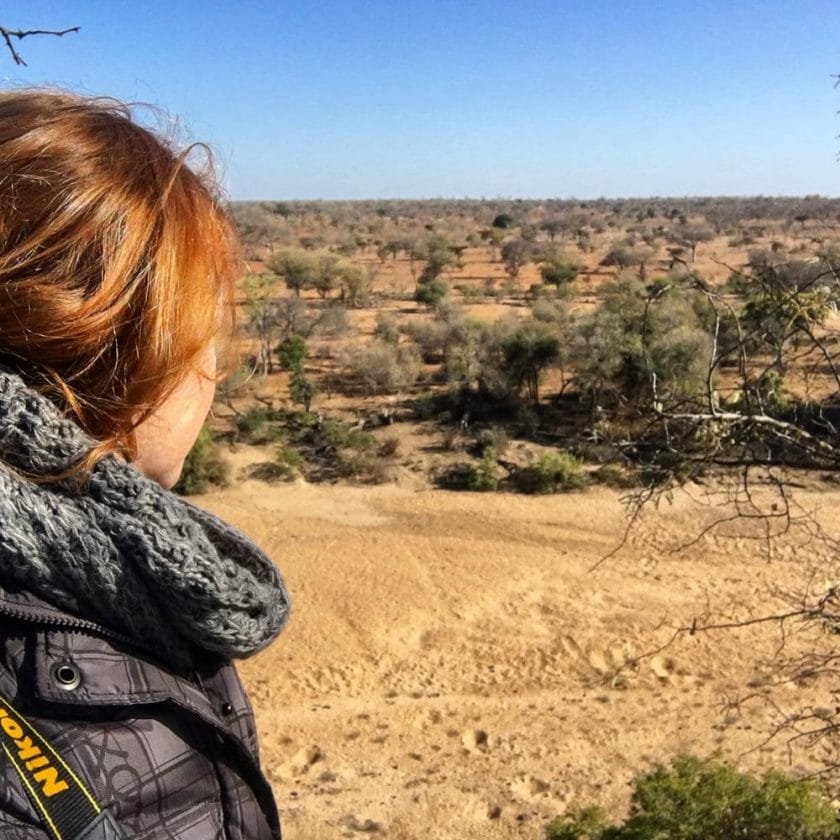
Kruger National Park might be one of the wildest places in Africa and home to the biggest land mammals on Earth, but that doesn’t mean that it is out of bounds for the solo traveler. The extensive network of tar and good gravel roads makes getting around a breeze, and a wide selection of accommodations suits every budget .
The myriad of campsites is a great DIY option, while safari tents, chalets, and guest houses offer all the creature comforts (plus the marvel of air conditioning) you’re used to at home.
If you’re looking for a touch of exclusivity and personalized service, take your pick from one of the private concession areas within the park or the multiple five-star luxury lodges that border the Kruger.
In the private concession areas and private game reserves, you’ll arguably get a more personal experience than going solo in the park’s public areas.
Daily game drives with an experienced ranger come as standard at most luxury lodges, birding and photography excursions can be tailored to your preference, and shuttle services to and from airports eliminate the need to rent a vehicle. Last but not least, all meals are taken care of.
The southern and central regions of the Kruger National Park are your best bet for spotting large populations of animals and having access to comfortable accommodation facilities like restaurants, fuel stations, and shops.
If you’re a veteran of solo travel and have the time, then the northern part of the park is much less populated with stunning, unspoiled landscapes.
Travel Tips for Solo Travel in the Kruger National Park
- If you plan on spending multiple days in the reserve and/or plan to move between different camps, you’ll need a vehicle. The roads are superb, so any vehicle will do, but if you’re planning to camp, you may want to consider renting a camper van or kitted-out 4×4.
- A larger rental vehicle like an SUV or 4×4 can aid game viewing since it has a height advantage, especially in the summer when the grass is tall.
- There’s no public transport within the park. If renting a vehicle is not an option, or you prefer not to drive, stay at one of the private lodges in the greater Kruger, where shuttle services and daily game drives are included in your stay.
- Be sure to buy a map of the reserve at the entrance gate or a camp shop. You’ll need it to navigate through the Kruger on your own.
- All the main camps have restaurants with reasonable prices and small shops for self-catering. You can also book guided drives and walks with rangers from here.
- Several overland and hop-on/hop-off tour operators offer multi-day guided trips to the Kruger. Join one of these, and you’ll meet fellow travelers, and your accommodation, meals, and game drives in the park are included.
- Why Kruger National Park
Registered Members of these Organizations
USEFUL LINKS
- Safari Tours
- Accommodation
- Why Book with us?
- Content Collaborations
- Safari Cost Estimator Tool
- Wildebeest Migration
- Privacy Policy
- Website Terms of Use
POPULAR COUNTRIES
- View All Countries
POPULAR DESTINATIONS
- View All Destinations
- Cape Town Holidays
- Etosha National Park
- Chobe National Park
TRAVEL BLOGS
- The Best of Kenyan Cuisine: 10 Dishes to Savour on your next Safari
- Norse Atlantic Adds New Direct Flight to Cape Town
- Travel News Digest, 19 April: SA Airports Celebrated, Rhino Poaching Concerns, Cape Town ‘Big Six’ Appeal
- FastJet Adds Surcharge to Vic Falls Route
- A Seasonal Guide to Honeymoon Safaris in Africa
OUR LOCATION
2nd floor, Tygervalley Chambers One, 27 Willie van Schoor Avenue, Bellville, Cape Town , 7530
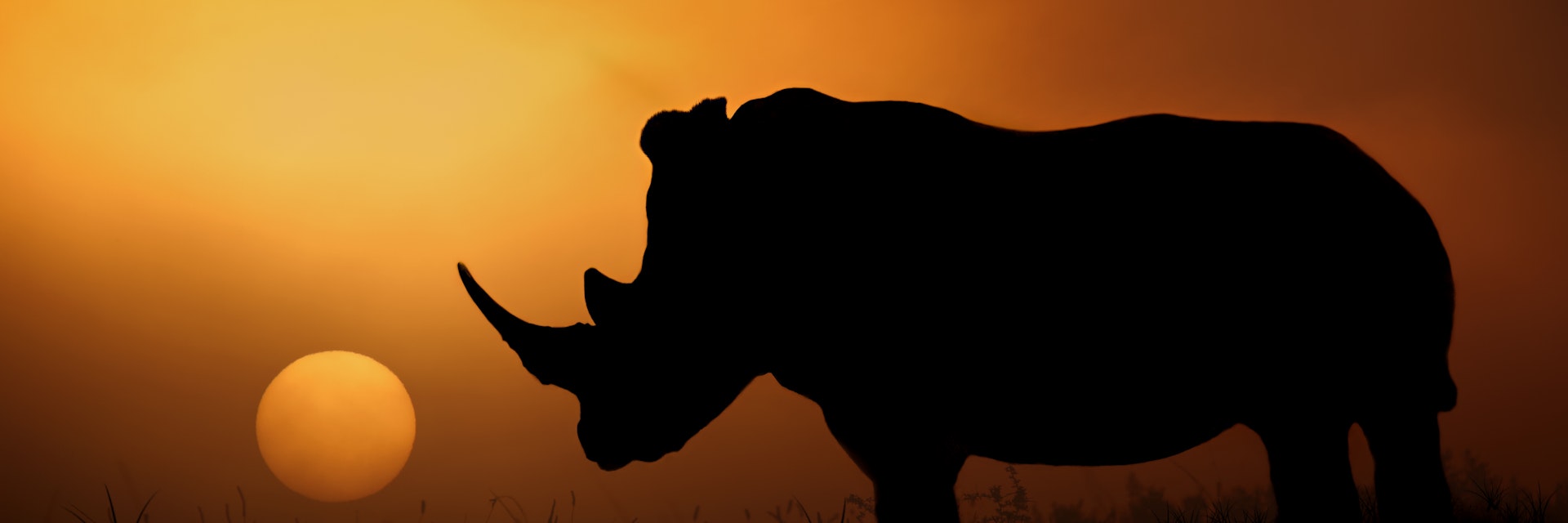
Kruger National Park
Kruger is one of the world's greatest wildlife-watching destinations. All of Africa's iconic safari species – elephant, lion, leopard, cheetah, rhino, buffalo, giraffe, hippo and zebra – share the bushveld with a supporting cast of 137 other mammals and over 500 varieties of bird.
Leave the planning to a local expert
Experience the real Kruger National Park. Let a local expert handle the planning for you.
Attractions
Must-see attractions.

Elephant Hall Museum
Even if you're not staying at Letaba Rest Camp, it's worth swinging by to check out this excellent museum. It has life-size skeletons and dozens of…
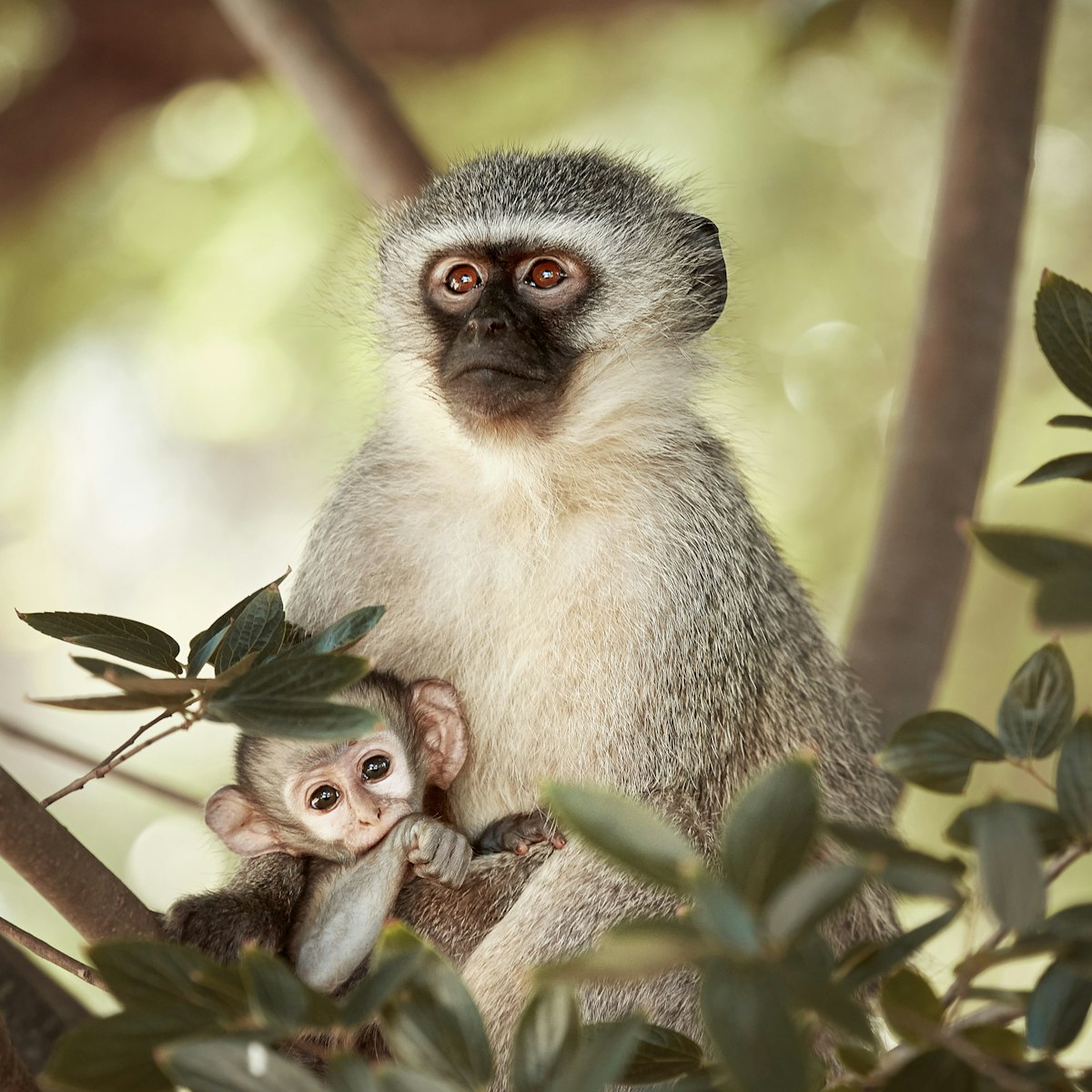
Sabi Sand Game Reserve
Within the borders of the large Sabi Sand Game Reserve are some of Southern Africa’s most luxurious safari lodges and the best wildlife watching on the…
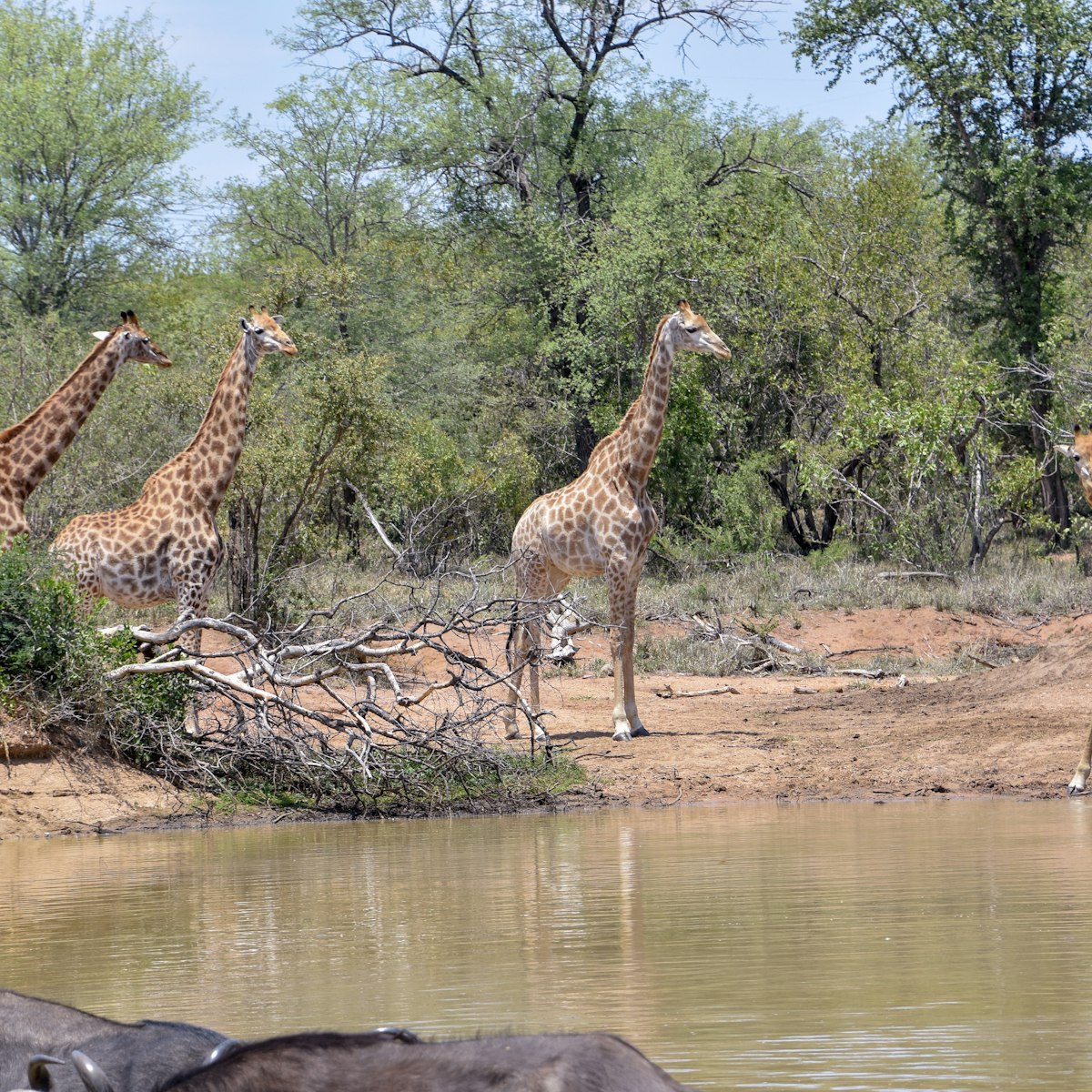
Kapama Private Game Reserve
With four luxury lodges and the Big Five in residence (as well as occasional passing wild dogs and great birding), 13,000-hectare Kapama gets all of the…
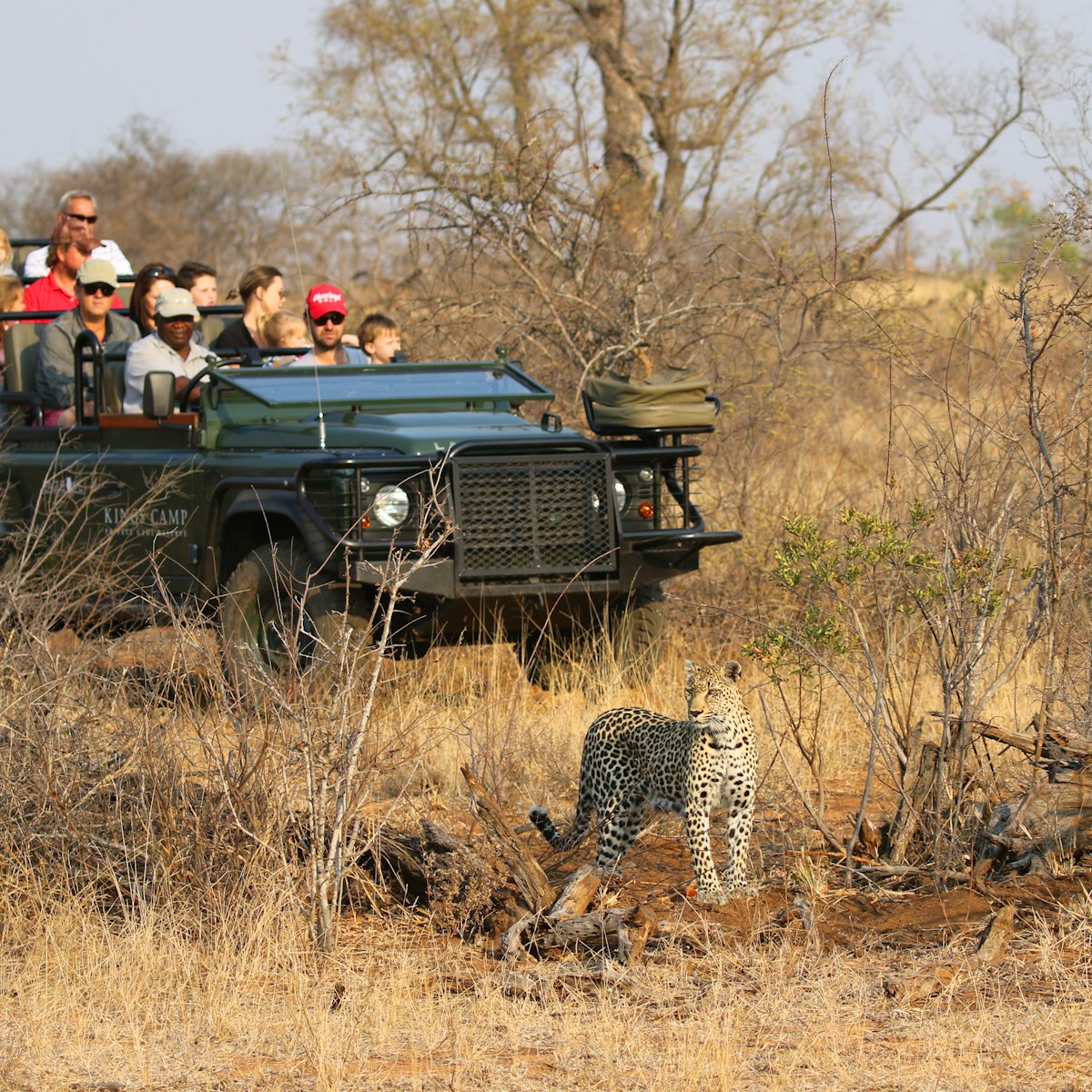
Timbavati Private Nature Reserve
Timbavati abuts Kruger National Park's western boundary and has an excellent mix of wildlife, conservation and good accommodation. Its accommodation…
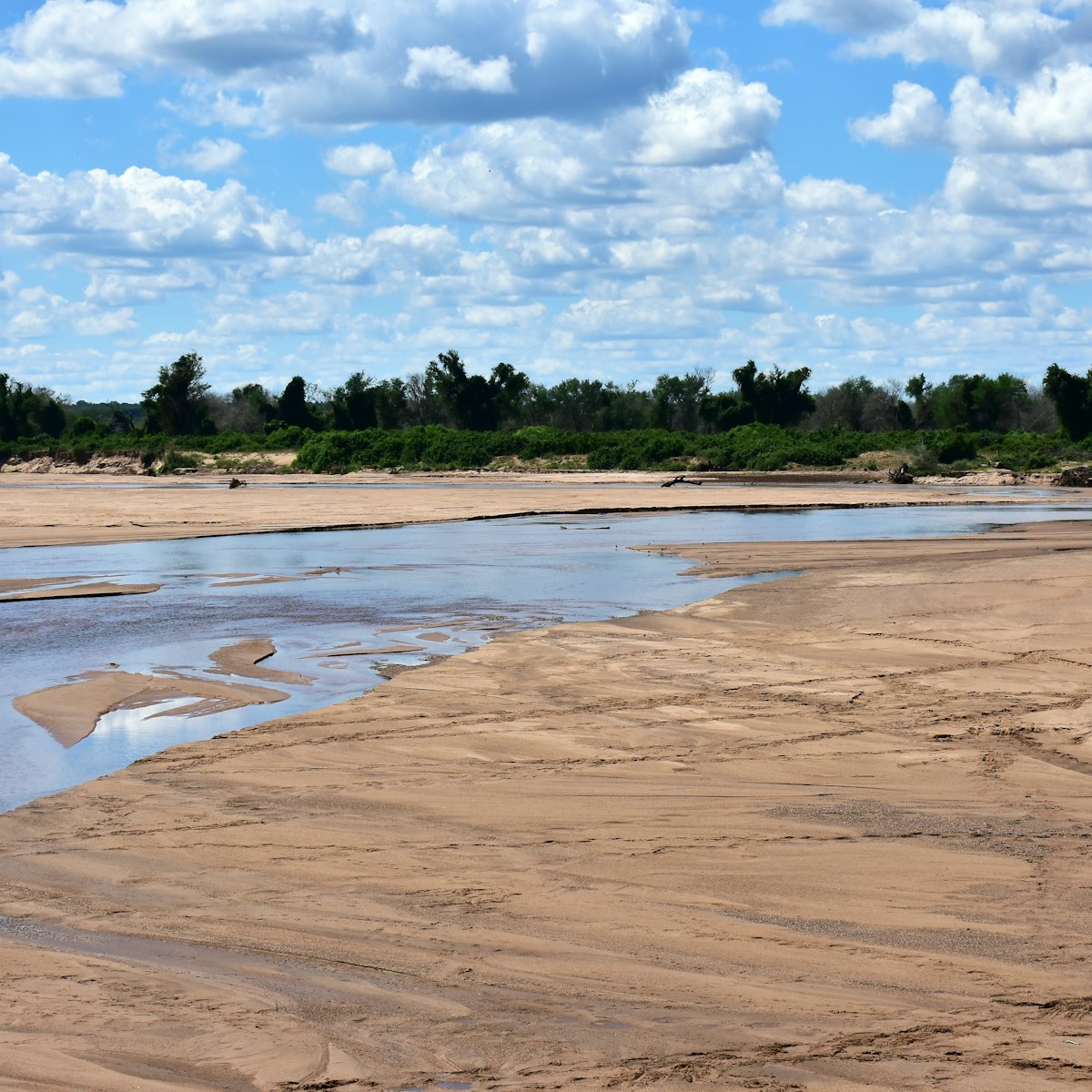
Crooks Corner
On the outskirts of a beautiful fever-tree forest, Crooks Corner marks not only the confluence of the Luvuvhu and Limpopo Rivers but also the historic…

Bobbejaankrans
This overlooks a section of the Timbavati River that animals often visit to slake their thirst. It's especially good early morning or late afternoon.

Renosterpan
This waterhole north of Berg-en-dal usually lives up to its name (renoster is rhino in Afrikaans). Late afternoon is best.

Klaserie Private Nature Reserve
A 600-sq-km (or 60,000 hectare) private wildlife reserve in the greater Kruger area, Klaserie has strong conservation credentials.
Plan with a local
Experience the real South Africa
Let a local expert craft your dream trip.
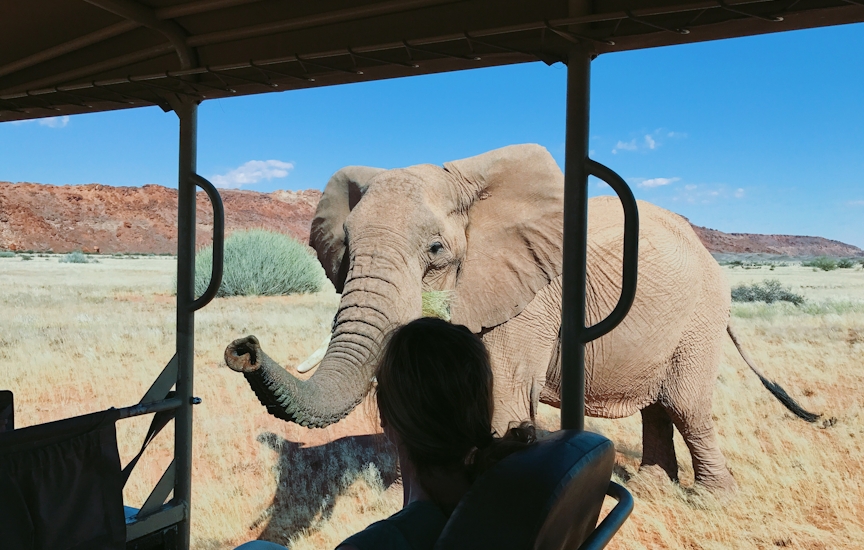
Latest stories from Kruger National Park
Filter by interest:
- All Interests
- Adventure Travel
- Art & Culture
- Beaches, Coasts & Islands
- Food & Drink
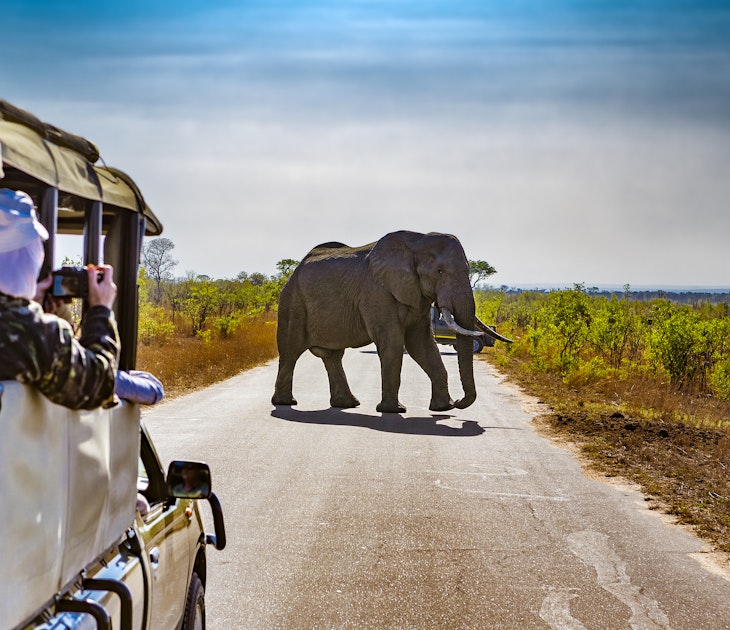
National Parks
Jan 5, 2022 • 8 min read
Preserving mountains, grasslands, beaches and deserts, South Africa's national parks are natural wonders. Here's a guide to South Africa's best reserves.
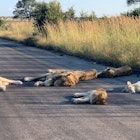
Apr 21, 2020 • 2 min read
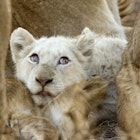
Sep 30, 2019 • 6 min read
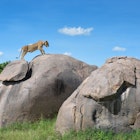
Jul 3, 2019 • 6 min read
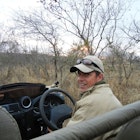
Jan 31, 2012 • 5 min read
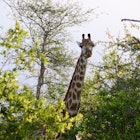
Jun 18, 2010 • 2 min read
Purchase our award-winning guidebooks
Get to the heart of Kruger National Park with one of our in-depth, award-winning guidebooks, covering maps, itineraries, and expert guidance.
Kruger National Park: the complete safari guide
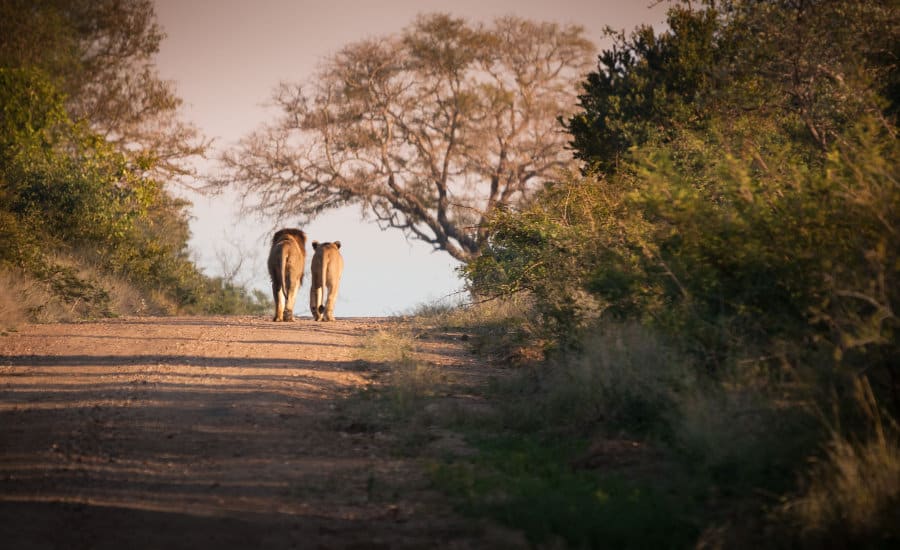
Kruger National Park is one of the top safari destinations in Africa . Safaris in the Kruger offer a chance to immerse oneself in the vibrant soul of the continent .
Surround yourself in untamed beauty. Peek into the lives of South Africa’s wildlife. And learn about your favorite animals. This national park is among the most famous in the world, and by the end of the article you will know how best to enjoy it.
For adventure lovers and nature fanatics , there is nothing better than a safari in Kruger National Park. You are guaranteed an unmatched, intimate experience, full of wonder and excitement.
This guide covers everything you can look forward to, including accommodation and tour options in a world-class, internationally acclaimed sanctuary.
4 Reasons to Go on a SANParks Kruger National Park Safari
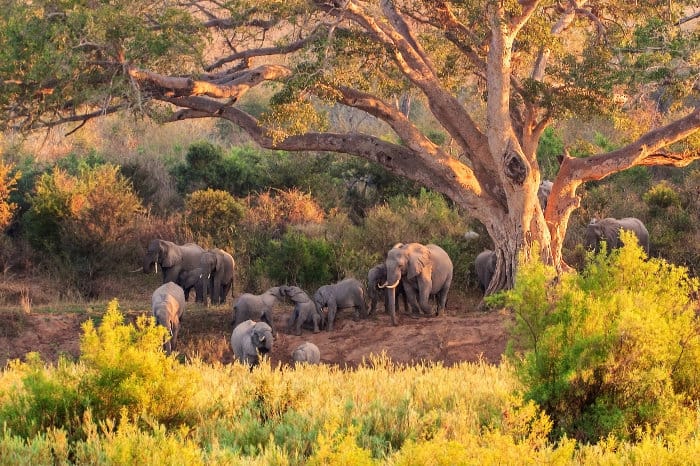
“In every walk with nature, one receives more than he seeks” – John Muir
1. Untouched wilderness
Kruger National Park is South Africa’s most unforgettable wildlife preserve. There’s minimal evidence of human life in the park, and visitors adapt to nature, rather than the other way round. With over 2-million hectares of unique wild habitats, there is an abundance of architectural wonders and historical sites.
The land is filled with legend and history. it emanates an ancient and tranquil atmosphere that gives visitors an authentic feeling of being in the African bush.
2. Visit the largest National Park in South Africa
The park reaches over into the Mpumalanga and Limpopo provinces, and in total it is a massive 19 633 km².
Not only is the Kruger Park the biggest national park in South Africa, but it also offers a sanctuary for wildlife .
Many of the private reserves have removed all boundaries. This means that African animals are free to roam and live out their lives in a natural way. You will enjoy a safari that captures the essence of what daily life is like for the wild animals of Africa .
3. A unique experience

A safari in Kruger invites you to step into the captivating lives of its wild animals. Kruger’s authentic safari encounters will keep you in awe of the beauty these animals possess. There are plenty of opportunities to see them in their natural habitats.
Kruger Safaris include encounters with many mammals , reptiles , and birds . As well as indigenous trees and diverse amphibians .
Highlights include:
- A diverse range of accommodation options – from camping to 5-star treatment
- Plenty of exhilarating activities
- A safari for every type of budget
- Professional FGASA -registered field guides
- Remarkable catering facilities
- Family retreats and tours
- Encounters with some of Africa’s most revered animals
With so much to love about a visit to this spectacular destination, it’s no wonder that Kruger National Park has become a must-visit on everyone’s safari bucket list. The remarkable Kruger Park gives visitors a chance to enjoy one of the most fascinating, diverse and genuine safaris.
4. See the famous Big Five
You cannot go on a safari in Africa without knowing about the magnificent Big Five . This is the name given to a special group of animals. It comprises the Cape buffalo , African elephant , lion , leopard , and rhino .
The Kruger National Park offers a rare chance to view all of these powerful animals throughout the large open spaces. A Kruger safari includes drives in areas where you are most likely to see each of them in their natural habitats.
What to Expect on a Kruger Safari

With so much on offer in the Kruger, it can be hard to know exactly what a safari entails and what it doesn’t. This guide covers some basic aspects of your safari , so you can be best prepared for this enthralling South African safari experience.
Budget-friendly options available
The SANParks Kruger National Park offers safaris that can match any type of budget . This means you won’t need to pay an arm and a leg.
Are you looking for a luxury experience instead? You can choose that as well. Treat yourself to 5-star lodges with lavish amenities.
However, there is also a lowkey, camping safari if you’re looking for a more affordable option. Or even the cheaper, self-catering options. We expand on this further on in our guide.
Go on guided tours
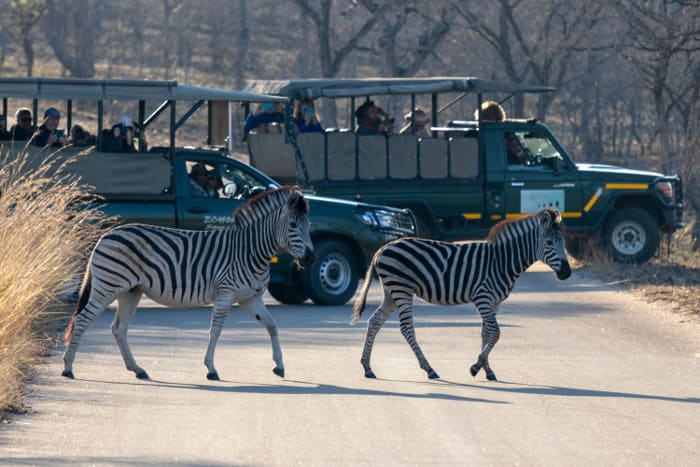
There are plenty of tour options available, and many types of safaris for you to go on. Plan ahead and choose the kind of safari that suits your needs. Before you book, decide whether you want a big group , small group , a family tour or a romantic escapade for two.
Enjoy all-day adventure
Expect to start your days at the crack of dawn and wake up in the early mornings. Safari drives usually start at around 6 am. You need to be out of bed by 5 am, to make it for breakfast at 5:30 am.
Get comfy in the car
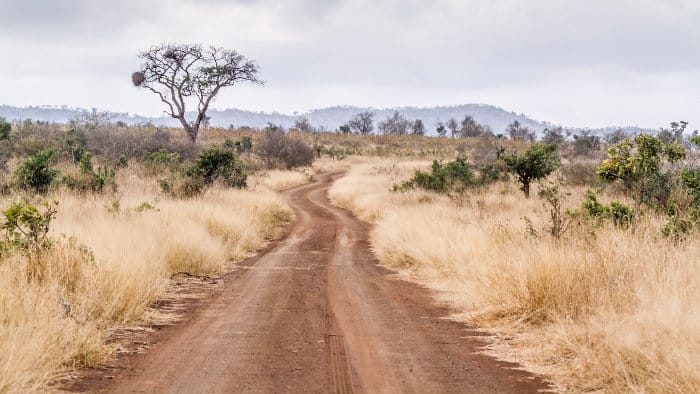
Expect to drive… a lot . After all, a safari is all about taking you through the wilderness (safely).
On safari, you spend countless hours in your safari vehicle, venturing through the stunning lands of Kruger and keeping your eyes peeled for the animals. As the park is so large, you will be captivated by the neverending beauty of untouched wilderness.
Spot diverse wildlife
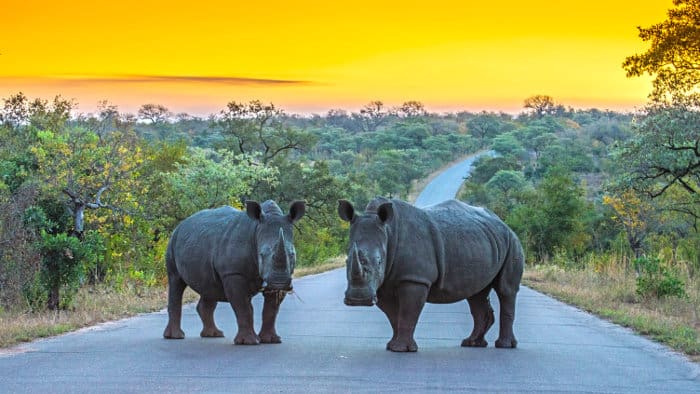
Some of the animals you can look forward to seeing are:
- The Big Five
Things to Know Before You Book a Kruger Safari
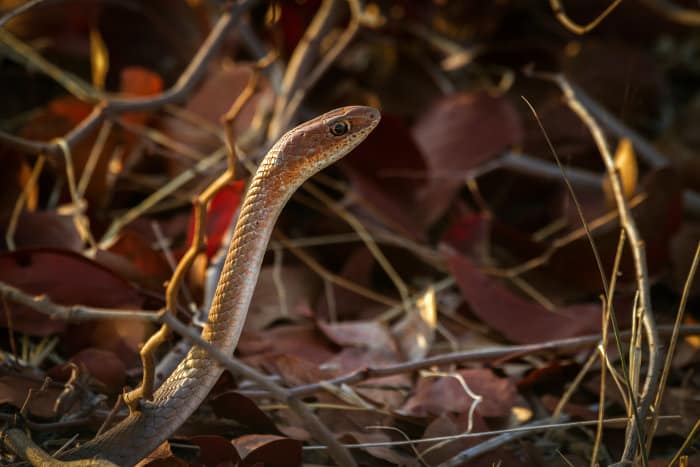
Here are some things to remember when planning your ultimate safari experience in SANParks Kruger National Park.
Be prepared for the African wilderness
Africa is as beautiful as it is wild, and this is something to keep in mind when booking your safari.
It’s important to take safety procedures into account. You aren’t in any real danger of being eaten (if that’s what you were thinking). Yet the harsh terrains of mother nature often have many surprises in store.
So be aware of scorpions , spiders , and snakes when camping or lodging in Kruger Park.
Medical advice and concerns
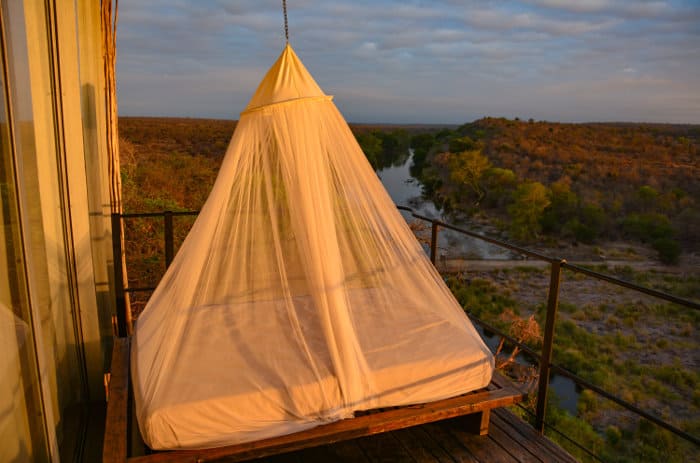
Kruger National Park is one of two parks in South Africa situated in a malaria-risk area. You need to take malaria precautions before entering the park. Your chances of catching malaria during the summer season (between October to May) are much higher than the rest of the year. If you visit during this time, it is especially a must.
But, no matter the season, you are advised to keep mosquito repellant with you and perhaps use a mosquito net when you sleep.
You can also learn all about mosquito bite prevention here .
Keeping safe on your safari
You are not allowed to leave the 4×4 open-top game vehicle on the drive. This is for your own safety as you explore wild animal territory.
A breakdown of important rules is given before your safari by the guides. So you can relax, knowing you are in good hands and that your guides are carefully looking after you.
Other helpful guidelines
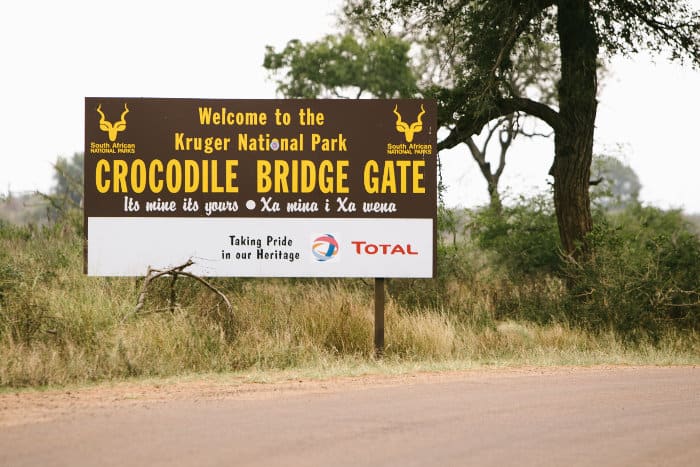
The tap water is clean and completely safe to drink. No need to load up on bottled water for your safari trip.
Keep in mind that the monkeys can be feisty, and are known to steal anything lying around.
Also note that skateboards, roller skates or quad bikes are not allowed.
On the park’s website, you will find Maps of Kruger Park and guides about the animals and their habitats.
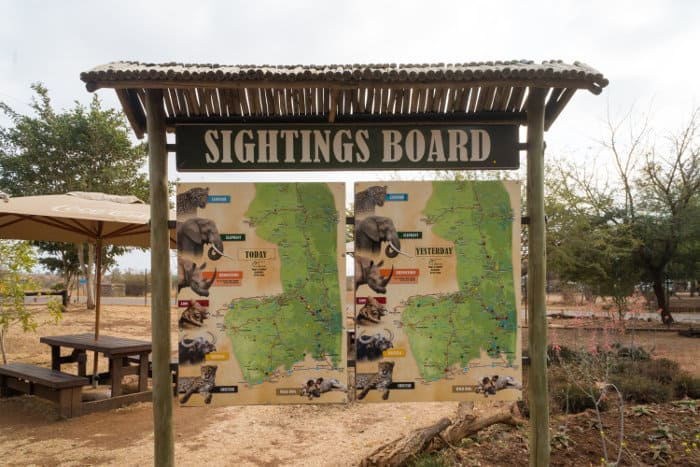
Check with the South African Consulate or Embassy to know whether or not you will need your visa onhand. This is necessary when staying longer than 30 days.
To avoid any mishaps during your safari, be sure to get travel insurance .
Business hours of Kruger National Park:
Entrance gates open
From 05:30 (06:00 latest).
All gates close
From 17:30 (18:30 latest).
Best Time to Go on Kruger Park Safaris
Choosing the best time for your safari depends on your personal preferences and how long you want to stay . You need to plan based on what aspects of the safari are most important to you.
Do you want a week-long visit , as opposed to a weekend? Then you may want to go during a season when the malaria risk is lower.
Do you want to see the indigenous flowers in bloom, or are you more focused on spotting the Big 5? These considerations will guide which season is best for your sightseeing preference.
Overall best time to visit
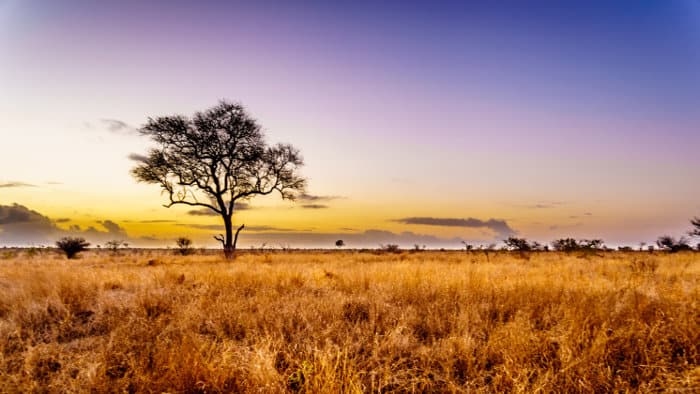
South Africa’s winter season is from June to August, providing a cool and dry climate . This is the ideal time to go on your safari. The dryness of the area allows much better chances to spot the wild animals of Kruger. Wildlife is not able to hide as easily and is more active in the search for food (and water).
Best time to see lush vegetation
The summer months of October to May provide jaw-dropping scenery . The thriving landscapes and blooming plants are a sight to behold, making every nature lover feel as if they’re in paradise. Some of the most beautiful plants to see during this time are:
- Thunderbolt flower
- Russet bushwillow pod
- Sausage tree flower
- Impala lily ( Also known as the Swazi Lily)
What to Pack for a Kruger National Park Safari
Packing for a safari in Africa can be tricky, but this list will help to make it much easier. Some essentials simply cannot be left behind. These include:
- High SPF sunscreen
- Durable hiking shoes
- Warm jacket for chilly mornings
- Camera with a long lens
- Good pair of safari binoculars
- Cotton clothing
- Swimming costume
- Mosquito repellent
- First-aid kit
Pack everything on this list and you are good to go. However, if you visit during winter, include a decent amount of warm clothing . The extra layers will be a huge asset, keeping you warm during the chilly mornings and evenings.
The Difference Between Guided Safaris and Self-Drive Safaris
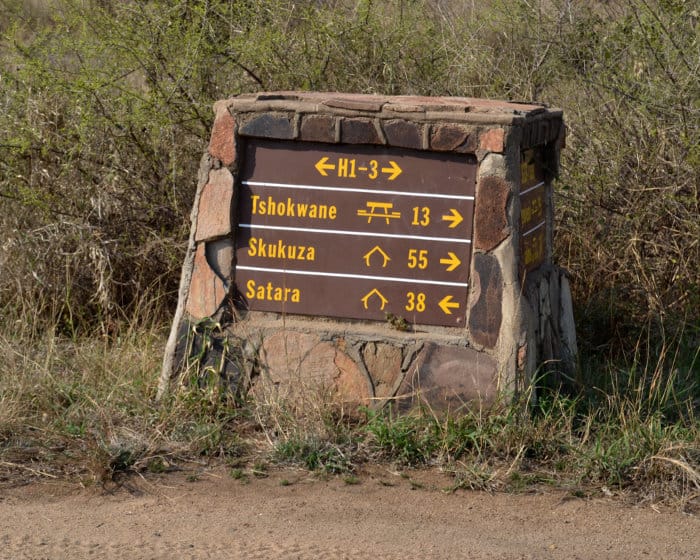
The biggest difference between the two is that with a guided safari, you explore the area with a private guide who shares his knowledge of the bush.
In comparison, on a self-drive safari you drive your own car through the routes.
Kruger National Park offers both of these options, so you can go wild and choose a safari that is perfect for you!
Some Kruger Park Safari Packages

There is a huge range of safaris available, but these are some of the most popular. You are likely to find the perfect fit for your safari in the Kruger National Park. These tour packages are flexible to availability, with choices between 2-day to 7-day safaris.
These options all include accommodation combos.
The budget safari
The budget safari adventure includes accommodation in a 2 bedroom chalet, with communal ablutions. This safari option is 3 days long. However, you can always request a different length of stay to suit your needs. Expect to enjoy delicious meals, all served al fresco style.
Added perks include game drives, a boma braai, and even an early morning bush walk along the Klaserie River.
Classic safari options
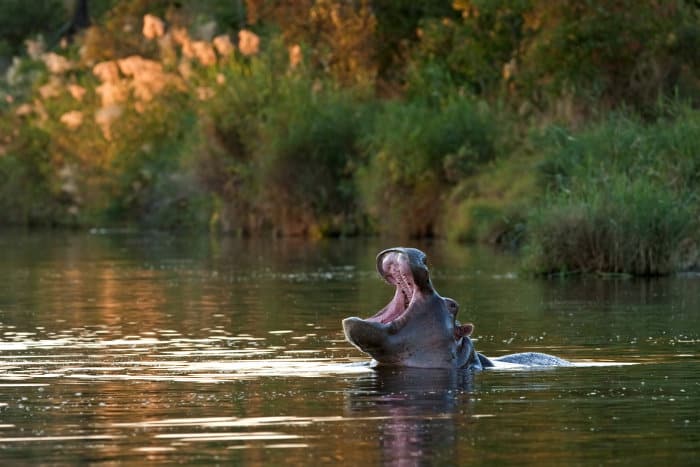
When it comes to having the traditional experience of Kruger’s authentic African wildlife safaris, the classic safari is the best option. Here are three major safari tour packages to choose from.
- 5 Day Classic Wildlife & Culture Safari
- 6 Day Classic Panorama & Kruger Safari
- 4 Day Kruger Park Walking Safari
Each of these packages offers a stylish getaway into nature. They combine elegance and wilderness, so you can travel in comfort. Classic safaris are all about capturing the true meaning behind the journey into Kruger’s wildlands. These tour packages focus on a non-commercial experience.
You learn about and discover the untouched magic of Africa’s wild habitats during a classic safari.
Family holiday safaris
Get your loved ones together for a truly incredible wildlife experience. Bond over campfires at night, or the shared experience of an elephant encounter. Family safari packages are diverse, with four suggested options to choose from.
- Luxury Family Safari
- South-eastern Family Getaway
- Family Elephant Encounter
- Deluxe Family Safari
Family holiday safaris also cater for small children and make sure that you get quality time with your loved ones. Special dinners, family picnics, bush walks, and exciting activities are all part of the packages.
These tour options have an itinerary built around giving you and your family the ultimate wildlife experience. There is an emphasis on spoiling the little ones, so you can have lots of fun with the kids on your safari.
Romantic safaris
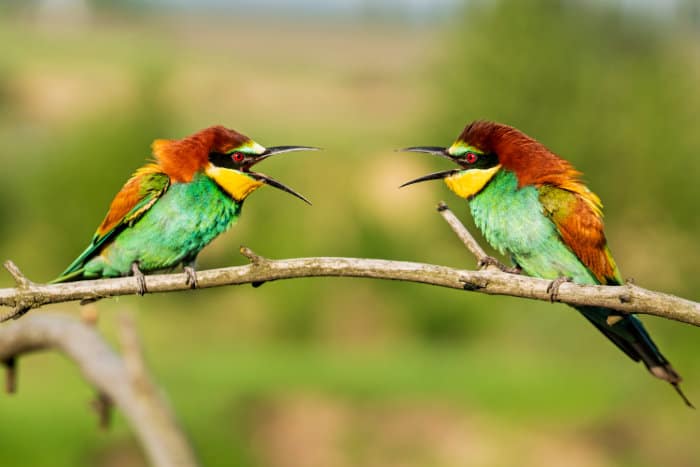
If you’re looking for a romantic getaway with your partner, fiancé, or spouse then you’ll love these tranquil and intimate honeymoon safaris.
Immerse yourself into wild Africa and have the chance to join one of the five romantic safaris. You can choose between:
- Classic Kruger Honeymoon
- Classic Self-Drive Honeymoon
- Premier Kruger Honeymoon
- Take a Moment Getaway
If you want to tie the knot with your partner, then also take a look at a Deluxe Kruger Wedding safari.
Kruger Park will turn into the romantic sanctuary of your dreams. With private game drives, beautiful lodging options, and dinner under the stars.
Kruger Accommodation
When it comes to accommodation in Kruger, you have a large variety to choose from. There are three main options to book. Opt for the one that best suits your budget and style of travel. Make the most of your safari with the perfect accommodation.
Private lodges and resorts

Private lodges can be found near the park and offer guests the chance for self-drive safaris. The accommodation options range from luxury to mid-range. They also include guided daytime safaris.
This option is perfect for those wanting a stay that offers more flexibility and freedom .
Safari lodges
Find yourself in the heart of the African bush with a stay at a safari lodge.
There are safari lodges throughout Kruger, ranging from extravagant , self-catering tents to 5-star lodges with indoor pools.
Safari lodges are perfect for those who want all the perks of a stylish stay. Enjoy culinary masterpieces, beautiful rooms with incredible views and luxury safari outings.
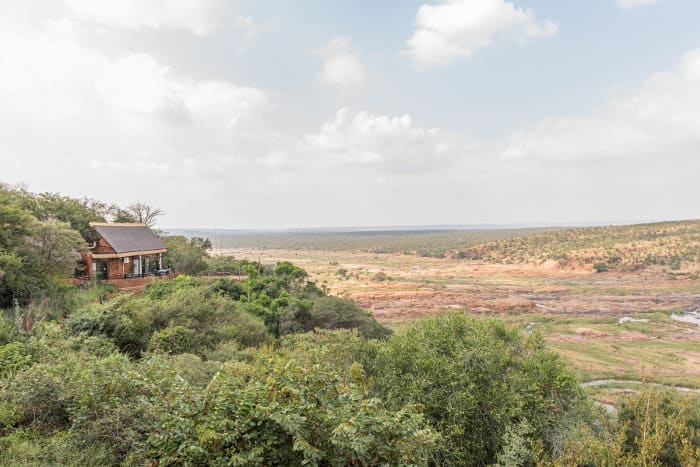
Rest camps are perfect for the low-key adventurer . You can find cheap chalets, bungalows and cottages within Kruger.
These all contain basic amenities and appliances to make your stay comfortable and affordable.
There are also communal campsites available. These have electricity, so you can still charge your phone or laptop. They provide a fantastic opportunity to meet other travelers and share a traditional South African braai with friends.
Frequently Asked Questions About a Kruger Park Safari
You may still have questions about planning an African safari to the Kruger Park. Here are some of the most frequently asked questions (and answers).
What are the conservation fees for? How much are they?
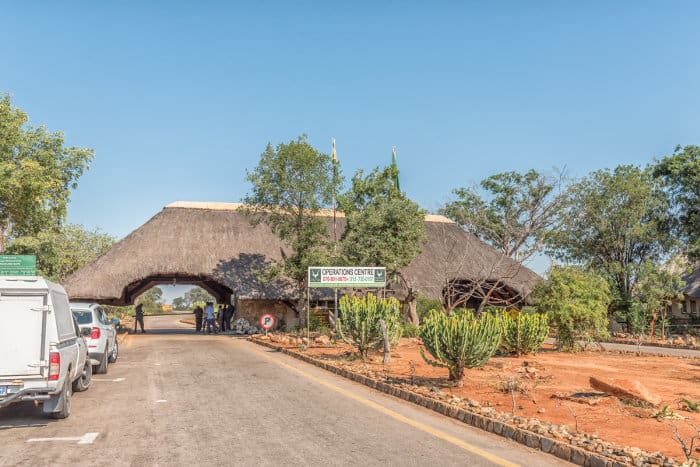
The Kruger Park charges daily conservation fees. These fees fund projects and efforts made by the park to preserve the area’s pristine habitat, as well as its cultural heritage.
They also go towards the general upkeep of boreholes , viewing hides and water supplies . There is a fee for each day you spend in the park, and it varies between international and local guests. On average, you are looking at daily costs of:
- R100 for locals (USD $7)
- R400 for international guests (USD $28).
Here are SANParks’ full details about daily conservation and entry fees in the Kruger .
Are pets allowed to come with on your safari?
This is a solid no . Pets are not allowed in Kruger park.
Your pet could potentially spread diseases to wild animals. It’s also not safe for a cat or dog to roam around in wild habitat. You do not want to risk their safety with so many potential predators. You will have to leave your four-legged companion behind for this adventure.
Additional Activities in Kruger Park
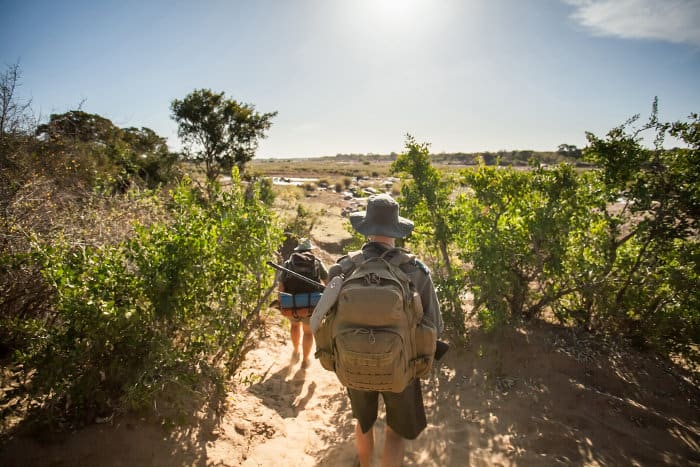
The incredible variety of safaris available at Kruger means that you have many ways to enjoy Africa’s wildlife right at your fingertips. And, during your safari, you can enjoy a host of activities.
The activities offered during your safari are as follows.
There are many bushwalks to choose from. Each of them take you to some of the most scenic parts of the park. You will be lead by an armed, knowledgable guide who will share insights along the way. Track animals like rhinos, elephants and lions on foot. Unfortunately, no children under the age of 13 are allowed to join.
These exciting bush walks are available on mornings and afternoons.
Mountain biking
Kruger National Park has incredible biking trails for adventurers at heart. However, it is exclusive to people staying at the Olifants camp .
Drive with the game vehicle to the starting point of the trail, with your bike carefully mounted on a bike trailer. You will receive complimentary helmets, backpacks, water bottles, snacks, and juice.
Depending on which route you choose, bike rides take 3-4 hours. This option is only available to fit and experienced cyclists and no children under the age of 16 may join.
Bird watching

The Kruger is home to some of the most remarkable birding spots. Each route includes a drive through the diverse and magnificent wilderness. The best routes for bird sightings are those that travel along riverine forest habitats . You can choose between a variety of locations, such as:
- Satara to Lebombo
- Napi and Doispane Roads
- Malelane to Berg-en-Dal
- Mahonie Loop
- Luvuvhu River Drive
- Lower Sabie to Tshokwane
- Lower Sabie Road
- Kanniedood Dam
- Engelhard Dam
- Crocodile Bridge to Lower Sabie
There are no guarantees, but your chances are much higher of spotting majestic birdlife while on a bird-watching route. The Kruger even has its own Big 6 , the bird-version of the notorious Big 5. These six birds are the lappet-faced vulture , martial eagle , kori bustard , saddle-billed stork , pel’s fishing owl, and southern ground hornbill .
Tick off each of these stunning birds from your list as you cruise the optimal bird watching routes.

The Skukuza Golf Course is Kruger’s only golf course. Found on the road to Paul Kruger Gate, it is a complete nine-hole, 72 par, 18-tee course. This is the perfect place to relax when you’re not in the safari vehicle.
Located in the majestic bushveld, the golf course offers views over Lake Panic. You may even spot a lion as you’re lining up for your next swing.
Kruger National Park Safaris
This article should give you a better idea of what to expect on your Kruger safari. From accommodation to tour packages, and anything else you were unsure of. You can now finish your planning with confidence, knowing what waits for you in sunny South Africa’s largest national park.
Kruger safaris are a must for anyone fascinated by the raw power of African wildlife. See the Big 5, spend nights in the wilderness and learn from certified professionals. Kruger Park prides itself on providing authentic bush getaways that are both safe and engaging.
Whether you are a solo traveler, with your family or planning your honeymoon – this diverse national park offers safari treats for everyone. You can go wild during the safari of a lifetime, with plenty of activities available and many options to choose from.
It’s time to ignite the wilderness within you and plan your ultimate safari , handcrafted to suit your every desire.
About The Author
Editorial Team
Related posts.
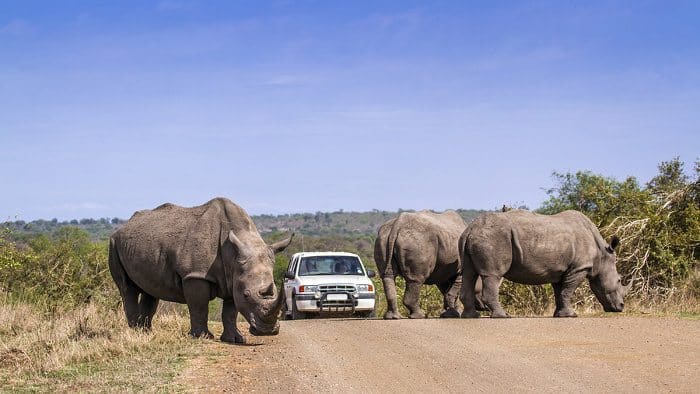
10 “lekker” ways to go on safari like a South African
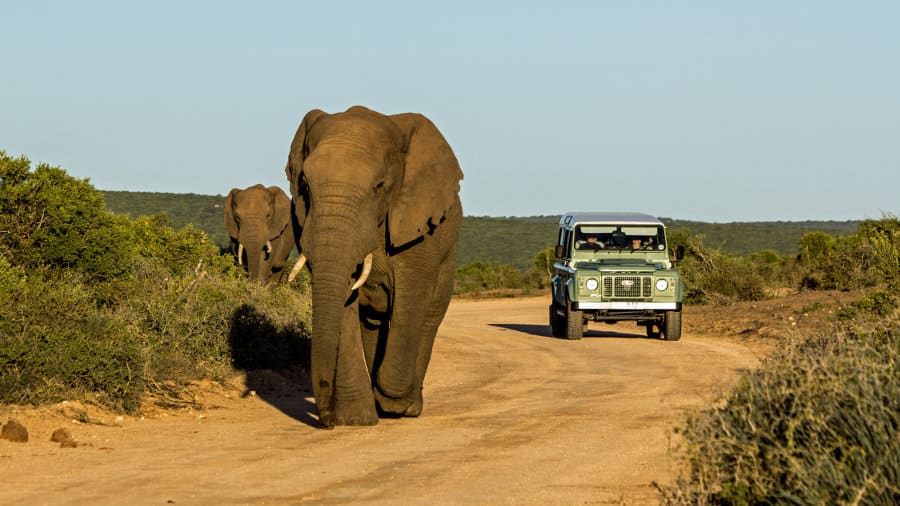
Addo Elephant Park – Safari and accommodation guide
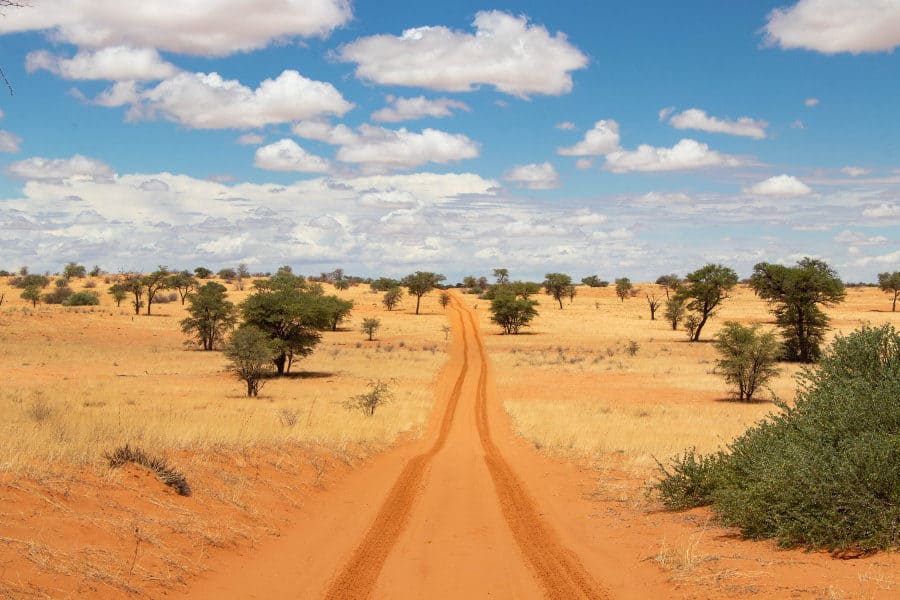
Kgalagadi Transfrontier Park safari guide
Leave a comment cancel reply.
Your email address will not be published. Required fields are marked *
Matador Original Series
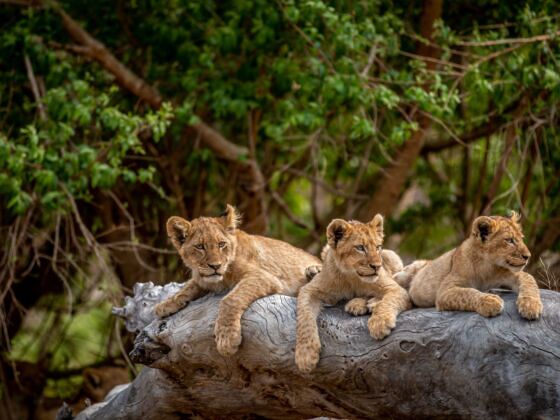
6 Things to Know Before Planning Your Kruger National Park Safari
K ruger National Park is probably the most popular tourist destination in South Africa. The sprawling national park is certainly the most popular safari destinations in South Africa, and potentially the world, thanks to its resident “Big Five” species. It’s a bucket-list destination for many wildlife photographers, but even a novice shutterbug is likely to get fantastic photos of herds of animals like giraffes, elephants, and other iconic species roaming the grassy landscape.
Established in 1898, Kruger National Park holds the distinction of being one of the oldest national parks or protected areas in Africa. Over the years, the park has weathered numerous challenges, from encroachment by humans to the devastating impacts of poaching to overtourism and a COVID-spurred lack of tourism — but it’s continued to thrive, as have the tens of thousands of animals in its care.
For travelers from the US, the park is extremely popular. That’s probably because how easy it is to reach. It’s not far from Johannesburg, which has many direct flights from cities in the US. It also has multiple entrances, hundreds of options for hotels and Kruger National Park safari packages, and a well-developed park and road infrastructure. Because of that, it can be surprisingly affordable, with local hotel starting at under $100 a night year-round.
Scroll down for the basics of planning a Kruger National Park safari, including when to go, the best affordable and luxury Kruger National Park lodges, how much to budget, and how to get there.
We hope you love the hotels and activities we recommend! Just so you know, Matador may collect a small commission from the links on this page if you decide to book a stay or book a tour through one of our affiliate partners. Listed prices are accurate as of the time of publication.
Where is Kruger National Park?
- Kruger National Park map
- Kruger weather and when to go
- Booking a Kruger National Park safari
- Wildlife in Kruger
- The best Kruger National Park lodges, starting at $55

Photo: Robert Wedderburn /Shutterstock
Kruger National Park is in northeastern South Africa, bordering Mozambique and Zimbabwe. It covers more than 7,523 square miles, making it larger than many US states — and many countries.
The park’s landscapes vary from dense forests and rugged mountains in the south to open savannas and arid grasslands further north. It’s the largest national park in South Africa, unless you count the combined lands of Kgalagadi Transfrontier Park, which straddles both South Africa and Botswana. Only a few other national parks on the continent are larger, such as Namibia’s otherworldly Namib-Naukluft National Park and Tanzania’s Selous Game Reserve, both of which are about 19,000 square miles.
Kruger National Park map and getting there
That’s why most people visiting the park fly to Kruger Mpumalanga International Airport, about 50 minutes from the park’s Numbi Gate. You can fly there from Zambia, Mozambique, and Zambia, as of July 2023. From either airport, you have several options for getting to the park: you can rent a car and drive yourself, ask your hotel to arrange an airport pickup, or book a travel package that includes your transportation from either airport. Or you can book a shuttle company like Kruger Transfers to take you from any area airport to your lodge or hotel of choice.
That’s right — any area airport. There are actually two other Kruger National Park airports: Hoedspruit, for the central park of the park, and Skukuza, if you’re heading to some of the private reserves that border the park. Both fly only to Cape Town and Johannesburg. Phalaborwa airport used to serve the northern park of the park, but it closed in 2020.
Kruger National Park weather

The rainy season can have its perks, too. Photo: JONATHAN PLEDGER /Shutterstock
Kruger National Park’s weather is pretty simple, with a dry season and a wet season.
Most people consider the dry season (May to September) as the best time to go to Kruger National Park. While there can be a bit of rain in May or September, most of this season is dry and mild, with daytime temps between the mid-60s and mid-70s Fahrenheit. Evenings can be in the 50s F, so wear an extra layer for early morning or night safaris. Another perk of the dry season is that guides usually have a good idea of where animals will be, since they tend to congregate around water sources. It can also be a bit easier to spot animals from afar as there’s less foliage for them to hide behind.
During the wet season, from October to April, it’s warmer and wetter, especially in January and February. It can be anywhere from the high 70s to the high 90 degrees Fahrenheit, and heavy rain is common. The bonus is that the park is extremely lush, spring brings a better chance for seeing baby animals, and it’s less crowded and usually cheaper to visit. And having fewer people nearby to scare off wildlife is always a plus. Do an online search for photos of busy roads in Kruger, and you may decide that the wet season is actually the best season.
Kruger National Park safaris
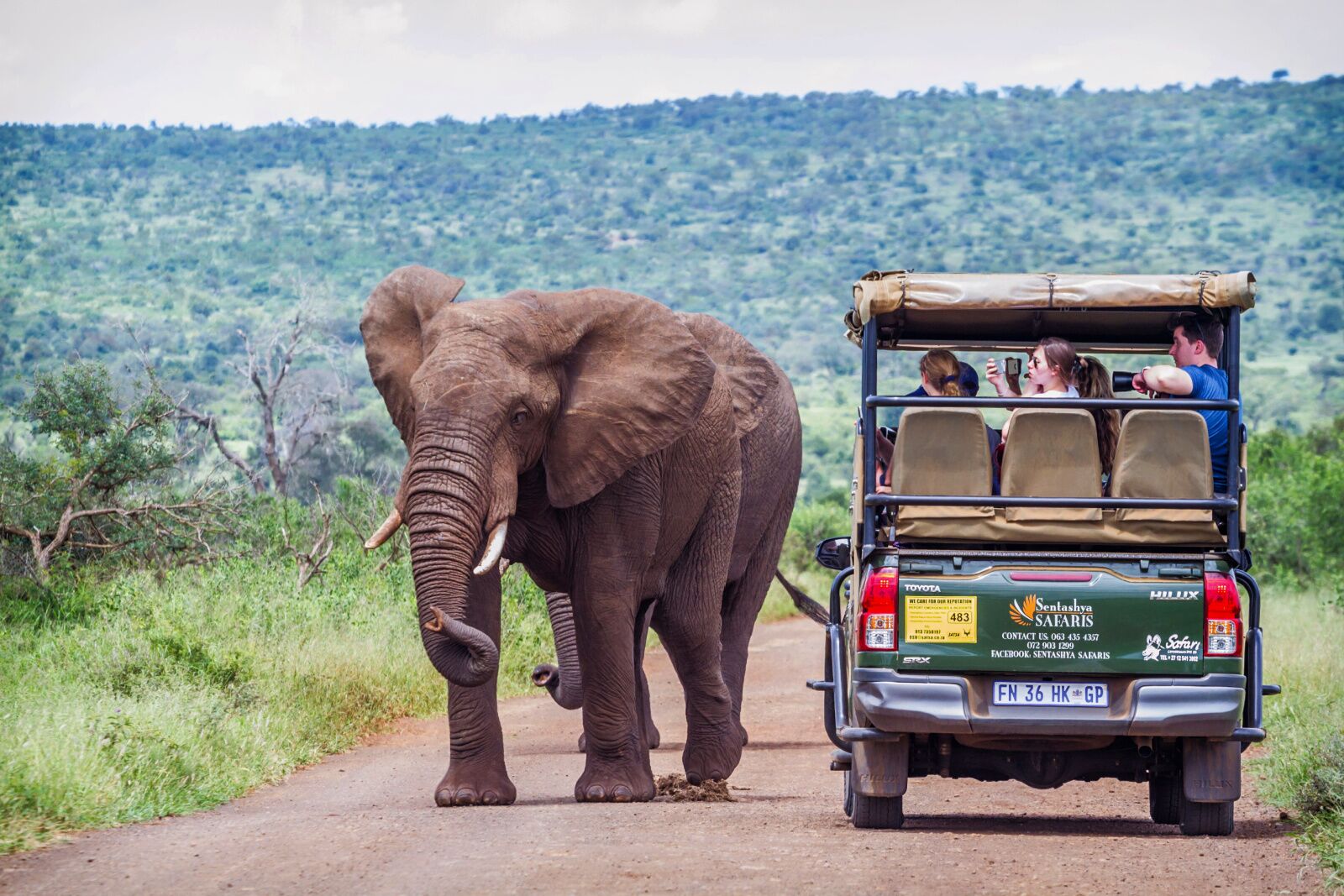
Photo: PACO COMO /Shutterstock
Nearly all visitors head to the park for the same reason: going on a Kruger National Park safari, the park’s most famous activity. Visitors have lots, and lots, and lots of options for booking a Kruger safari. In addition to game drives and walking safaris, you can book everything from hot-air balloon safaris to a guided Kruger National Park safari via mountain bike .
Option 1: Book directly with the park
The park offers several different types of safaris, called game drives, which you can book online directly through the park website . Your options include a 3-hour sunrise or sunset drive (r490, or about $25 USD), 2-hour night and late night drives (around $20), or a morning or river walking safari (r760, or about $40). The park doesn’t offer a bookable all-day drive, but you can contact the park in advance to ask about availability of safari cars if you’d like to arrange a private one. Hotels and lodges can also help arrange this.
You can also rent a car and drive yourself through the park as long as you pay the r460 ($24) per person entrance fee. Here’s a link to more than a dozen excellent self-drive routes in Kruger. Just remember that someone is going to have to drive, which is the least fun role when the rest of your party gets to search for wildlife.
Option 2: Book a safari through a tour operator
Because private vehicles are allowed into the park, you can also book a Kruger National Park safari through a private company. There are hundreds of options. Siyabona Africa offers private all-day game drives starting at r4.,653, or about $250 per vehicle (not per person). You can also opt for a shared full-day drive at r2,200 ($116) per person. And if you don’t mind an early start, Elephant Herd Tours offers a 5:30 AM start with hotel pickups before that for around $97 per person — which could be worth it to be among the first in the park that day.Alternatively, you could ask your lodge or hotel to arrange a private driver for you, if safaris aren’t already including in your lodging.
Option 3: Book a Kruger safari package
View this post on Instagram A post shared by andBeyond (@andbeyondtravel)
The most budget way to find a package will be to book one with a local operator when you arrive in either Jo-burg or one of the park’s gateway towns. You’ll find plenty of on-the-ground, local guiding companies willing to sell budget safari packages around $400-$500 for a two-night trip. For a mid-range trip you can book in advance online, expect to spend anywhere between $700 for a 4-day trip in homestays with a shared vehicle ( Elephant Herd Safaris ) to $1,200-ish for a five-day private tour with daily safaris through Amatungulu Tours. Luxury tours can range from a few thousand for a private multi-day tour to $10,000 or more with companies like Niarra Travel or andBeyond , where you’ll spend two or more weeks in the lap of luxury.
Your last option is to book a package through your hotel. Kruger National Park lodges like Jock Safari Lodge and Lion Sands Tinga Lodge include twice-daily game drives in the accommodation cost. More budget hotels, like Crocodile Kruger , are room-only, but the staff can assist with add-ons like daily safari drives.
Kruger National Park animals
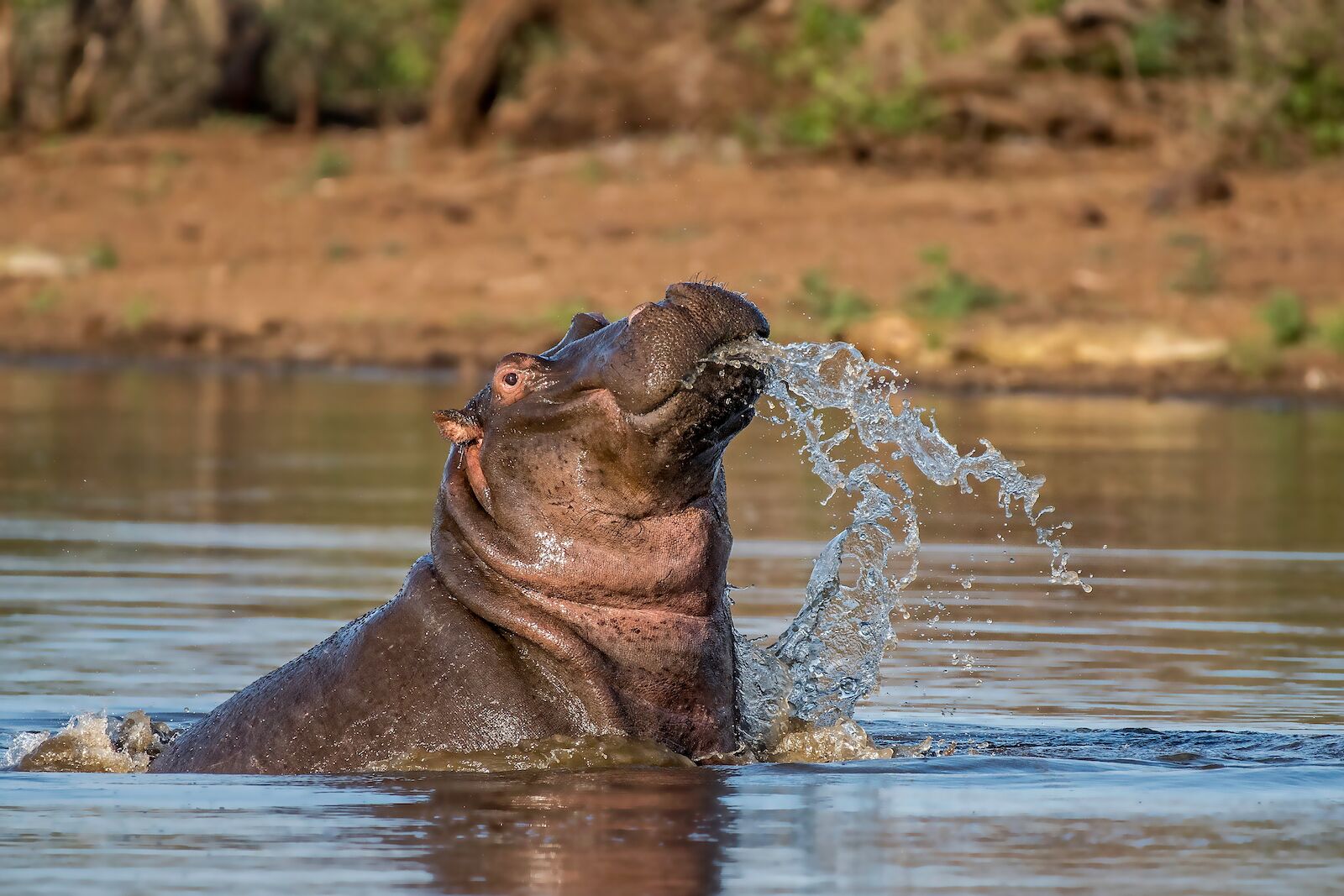
Kruger National Park offers the chance to see both giant herds of animals in sprawling grasslands, and tight interactions with single animals hidden in trees or hiding behind rocks. The park is so big that it offers pretty much every type of African wildlife sighting you can imagine, which is likely why it’s so popular with tourists.
The park is home to the famous “African Big Five”: lions, leopards, elephants, buffalos, and rhinos.
Lions are usually in the central part of the park in open savannas and on rocky ridgelines. Look around areas of the park like the Satara, Orpen, and Lower Sabie. For leopards, look on tree branches and in densely vegetated areas. Like lions, you’ll want to look for them around the Satara, Orpen, and Lower Sabie areas, plus around the Sand River.
The park has anywhere between 1,500 and 7,000 elephants; in fact, they’re starting to throw the food web out of balance. While that’s not a good thing, the large population size does mean you’re almost guaranteed to see them. It doesn’t matter so much where in the park you are, but they’re usually found around water sources or along roads in areas where they’re too big to move through the brush comfortably. Water buffalo are also more or less everywhere, often in the same area as elephants.

Photo: Ondrej Prosicky /Shutterstock // Photo: JMX Images /Shutterstock
The hardest of the Big Five to spot are rhinos. The park has both black and white rhinos, but not in large numbers; poaching has made both species extremely endangered. The southern region (between Skukuza and Lower Sabie) is a good place to start, but it requires a blend of luck and patience. Schedule a few extra days in the park if spotting rhinos is essential to you.
Aside from the Big Five, the park has species like cheetahs (also quite hard to spot), African wild dogs, giraffes (not so hard to spot), baboons, zebras, hippos, and hundreds of bird species. Kruger has one of the largest concentrations of large animal species in the world, so while you may not see the exact species you want to see on every drive, you’re bound to see something amazing.
Kruger National Park lodges

Photo: Expedia
Perhaps no safari destination in the world has more options for places to stay than Kruger National Park. The park is huge, and each entrance has dozens of hotels both inside and outside the park gates. Kruger is also one of the most popular safari destinations in the world, and hospitality companies have realized this. So there are hundreds of options, from five-star luxury hotels beloved by celebrities to budget stays owned by locals where you can sleep near the park for less than $80 a night.
However, most hotels falls somewhere in the middle — affordable stays with a touch of what’s best describes as open-air, safari chic: rooms with balconies or decks, outdoor communal spaces with firepits and couches, and amenities like infinity pools and stargazing showers.
When booking, be sure to check what’s included in your selected room or package. Some hotels include all food and drink, but not safaris; some include safaris, but nothing else; some include all your activities and your room; and some include only the room — but you can add on activities à la carte. And some offer all of the above. The details are usually front and center on the booking platforms, and if you book via Expedia, Booking.com, or similar, it will list what is included on the booking page.
Note that there’s only one downside to staying outside the park (aside from a short drive to get in every day): occasionally, the park will reach capacity just from guests staying in the park, and no outside guests will be allowed for that day. However, that’s very rare, and usually only happens once in a while on public holidays in the busy season. It’s possible, but not likely.
Crocodile Kruger Safari Lodge
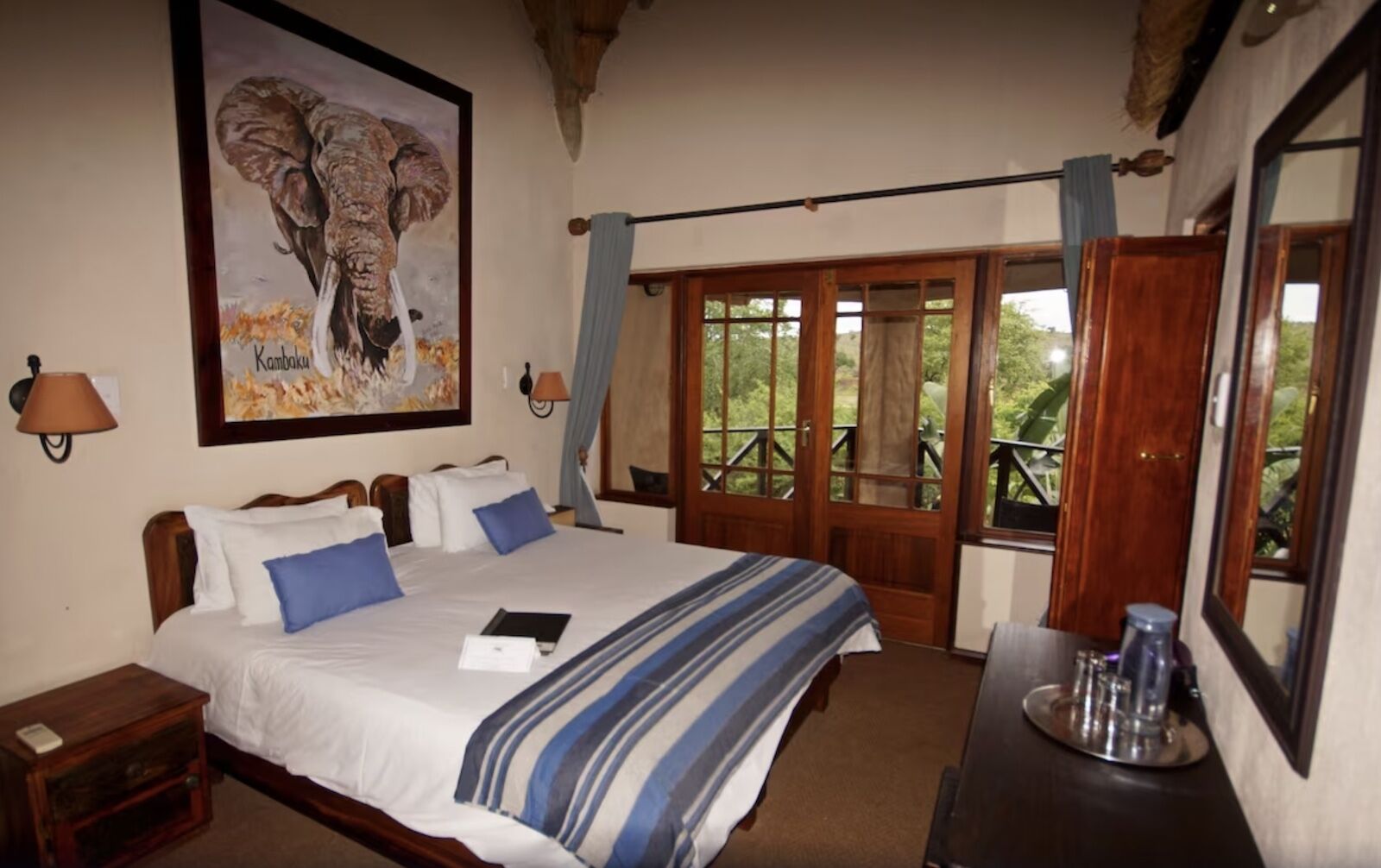
See more photos
Crocodile Kruger Safari Lodge is probably the best of affordable Kruger National Park lodges. It sits just outside the park on the aptly named Crocodile River, and rooms range from standard hotel rooms with patios overlooking the gardens and river to a full three-bedroom cottage with a private pool and kitchen. Rates start around $50 per person per night with breakfast, or $53 per person per night for full board — it’s a steal. Amenities include Wi-Fi, a pool, and an on-site bar. Activities are not included in the price, but the hotel can assist with booking anything you’d like to do in the area.
Lion Tree Top Lodge
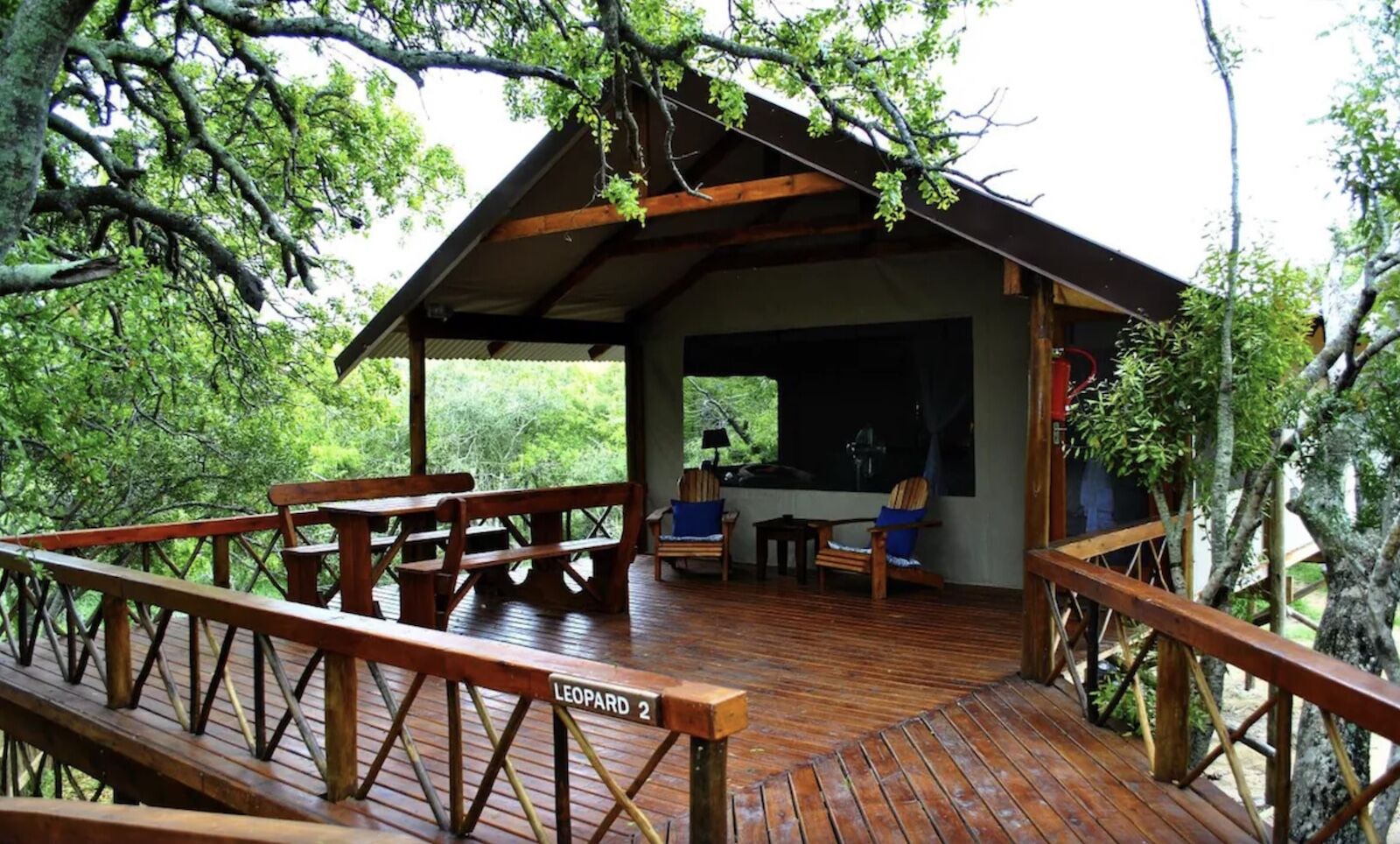
Lion Tree Top Lodge hits the sweet spot between posh boutique hotel and affordable Kruger National Park lodge. All “rooms” are actually fully furnished safari tents on raised platforms in the bush. Rooms have outdoor showers and relaxation decks, which means you may be able to spot wildlife from your room.
Safaris and other activities are not included in the fee, which gives you the freedom to book whatever local operator you’d like based in nearby Hoedspruit. You can also add on safaris when you book your room if you’d rather not deal with extra planning. Rooms start at a reasonable $106 per person, per night.
Jock Safari Lodge
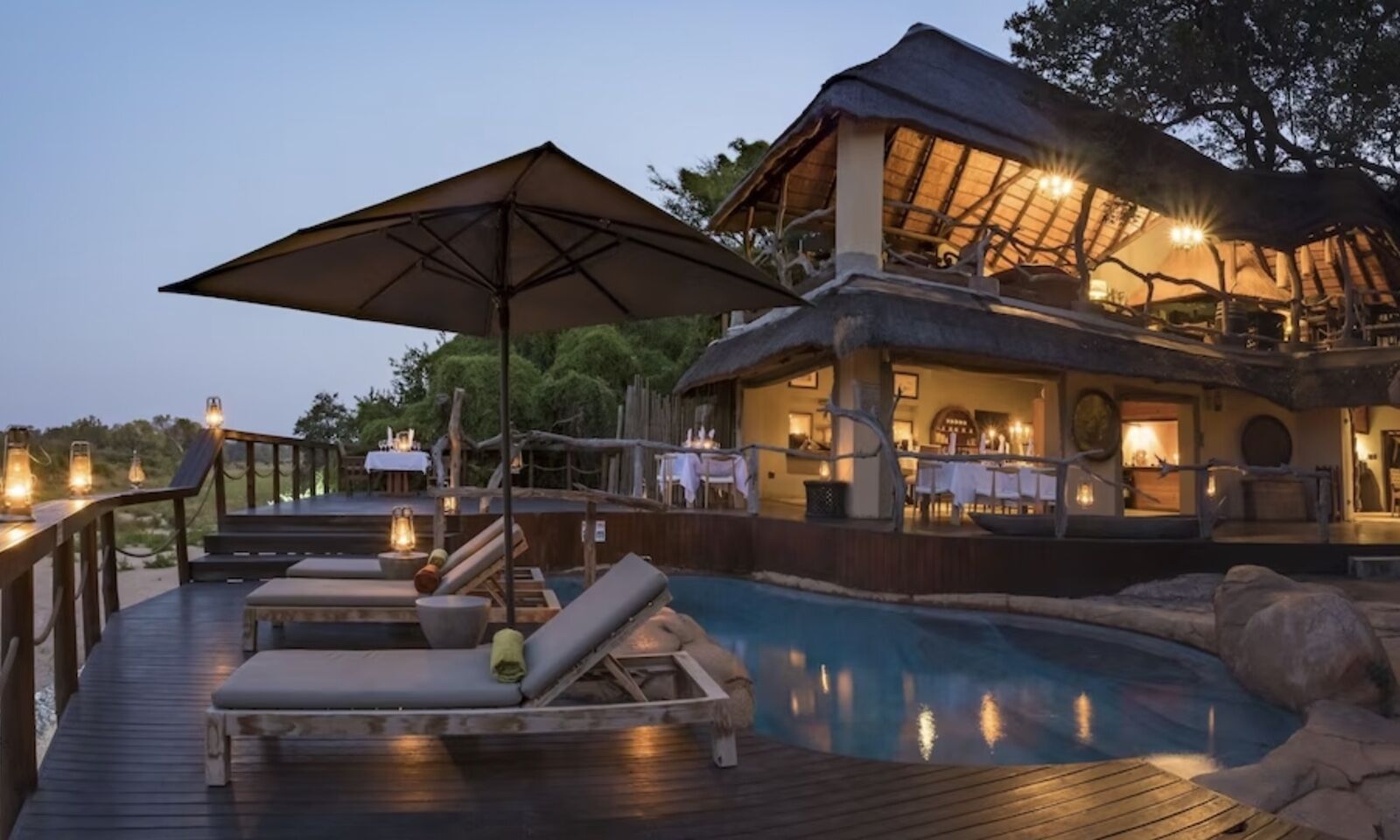
Jock Safari Lodge is inside Kruger National Park but owned and operated by a private company. It offers two places to stay: the Main Jock Lodge, or a private villa called Fitzpatrick’s at Jocks. The hotel sits on 600,000 acres just for hotel guests, which essentially amounts to private safari access within that space. Each safari-themed cabin has an outdoor daybed and private pool, and twice-a-day game drives are included in the cost of a stay. Rooms start around $887 a night — which seems pricey, but remember: it includes full days of game drives every day.
Hoyo Hoyo Safari Lodge

Hoyo Hoyo is another high-end Kruger National Park safari lodge, but it’s not quite as expensive as Jock Safari Lodge — rooms at Hoyo Hoyo start around $700 per night . It’s an all-inclusive Kruger resort (including twice-daily safaris and all food and drink) with a traditional style. Rooms have earthy decor with thatched roofs and natural materials, and the buildings sit naturally in a break in the tree-covered landscape.
More like this
Trending now, rare mammal safaris: all about the growing travel trend, wildlife pictured in ways you’ve never seen before: the best photos from 2024’s world nature photography awards, beautiful and resilient: the best of the british wildlife photography awards 2024, the 9 best countries for safari vacations around the world, florida's manatee hotspots: where to see these gentle giants in the sunshine state, discover matador, adventure travel, train travel, national parks, beaches and islands, ski and snow.
- AI Generator
victoria falls zimbabwe
805 kruger national park safari stock videos, 4k footage, & video clips, browse 805 kruger national park safari videos and clips available to use in your projects, or search for victoria falls zimbabwe to find more footage and b-roll video clips..
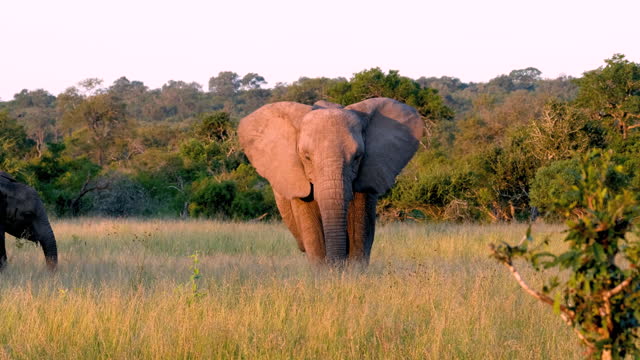
- You are here:
- All South Africa Tours
- Kruger Tours
Your Safari
Tour length, rates in usd $ – change currency, starting from.
- Johannesburg (350)
- Cape Town (13)
- Hoedspruit (3)
- Port Elizabeth (0)
- Pretoria (9)
- Nairobi (0)
- Entebbe (0)
- Zanzibar (0)
- Dar es Salaam (0)
- Kampala (0)
- Victoria Falls Town (0)
- Windhoek (0)
- Addis Ababa (0)
- Livingstone (2)
- Mombasa (0)
- Antananarivo (0)
- Nelspruit (5)
- Bujumbura (0)
- Hazyview (8)
- Blantyre (0)
- Upington (0)
- Diani Beach (0)
- Lilongwe (0)
Comfort Level
- Luxury+ (38)
- Luxury (86)
- Mid-range (181)
- Budget (77)
Private or Shared Tour
- Private tour (126)
- Shared tour (268)
Safari Type
- Lodge, tented camp or hotel (364)
- Camping (30)
Operator Rating
- & up (372)
Specialized Tours
- Fly-in safaris (20)
- Family (177)
- Beach time (8)
- Honeymoon (124)
- Gorilla trekking (0)
- Photographic safaris (2)
- Mountain climbing (0)
- Walking safaris (2)
- Self-drive (6)
- Guided self-drive (5)
- Chimp trekking (0)
- Overland tours (7)
- Cycling safaris (0)
- Canoe safaris (0)
- Horseback safaris (0)
- Birding tours (0)
- Accessible safaris (0)
- Golf & Wildlife (0)
Other Tour Features
- Airport transfer is included (382)
- Itinerary can be customized (153)
Filter by Operator
Filter by accommodation, operators from.
- South Africa (380)
- Tanzania (3)
- United Kingdom (18)
- United States (5)
- Australia (3)
- Belgium (0)
- Botswana (0)
- Comoros (0)
- Denmark (0)
- Ethiopia (0)
- Eswatini (0)
- Germany (0)
- Ireland (0)
- Lesotho (0)
- Madagascar (0)
- Mauritius (0)
- Mayotte (0)
- Mozambique (0)
- Namibia (0)
- Netherlands (0)
- New Zealand (0)
- Nigeria (0)
- Portugal (0)
- Reunion (0)
- Seychelles (0)
- Singapore (0)
- Switzerland (3)
- United Arab Emirates (0)
- Zimbabwe (2)
Kruger Safari Tours - Compare 394 Packages
South Africa’s premier safari destination, Kruger National Park throws up some staggering statistics. Established in 1898, it extends over some 19,000km²/7,335mi² and supports a total of 147 mammal species (the most of any African national park). This includes an estimated 13,000 elephants, 40,000 buffalo, 2,000 lions and more rhinos than any other protected area. Kruger is an ideal safari destination at both ends of the price and experiential spectrum. No other major African park is so well geared to budget-conscious self-drivers. Equally, some of the all-inclusive private and concession lodges associated with Kruger and its immediate surroundings (including MalaMala, Sabi Sabi and Londolozi) rank among the most exclusive, prestigious and costly in Africa.

4-Day Greater Kruger Safari with Marc's Treehouse
$799 pp (USD)
South Africa: Shared tour (max 9 people per vehicle) Mid-range Lodge
You Visit: Johannesburg (Start) , Balule NR (Greater Kruger) , Kruger NP, Blyde River Canyon (Panorama Route) , Johannesburg (End)
Indigo Safaris
4.8 /5 – 125 Reviews

3-Day Kruger National Park Experience
$675 pp (USD)
South Africa: Shared tour (max 9 people per vehicle) Mid-range Guest House
You Visit: Johannesburg (Start) , Southern Kruger, Kruger NP, Nelspruit (End)
Elephant Herd Tours & Safaris Tour operator has an office in South Africa
4.8 /5 – 90 Reviews

5-Day Kruger Park and Manyeleti Reserve Bongan Lodge
$840 pp (USD)
South Africa: Shared tour (max 9 people per vehicle) Budget Lodge
You Visit: Johannesburg (Start) , Manyeleti GR (Greater Kruger) , Central Kruger, Blyde River Canyon (Panorama Route) , Kruger NP, Johannesburg (End)
Bongan Safaris Tour operator has an office in South Africa
4.9 /5 – 19 Reviews

4-Day Classic Kruger Park Safari
$958 pp (USD)
South Africa: Shared tour (max 6 people per vehicle) Mid-range Lodge
You Visit: Johannesburg (Start) , Kruger NP, Johannesburg (End)
Wildlife Safaris Tour operator has an office in South Africa
4.9 /5 – 259 Reviews

4-Day Ultra Budget Glamping Kruger Safari
$509 pp (USD)
South Africa: Shared tour (max 10 people per vehicle) Budget Tented Bush Camp
You Visit: Johannesburg (Start) , Kruger NP, Panorama Route (Highlight) , Johannesburg Airport (End)
MoAfrika Tours Tour operator has an office in South Africa
4.9 /5 – 1158 Reviews
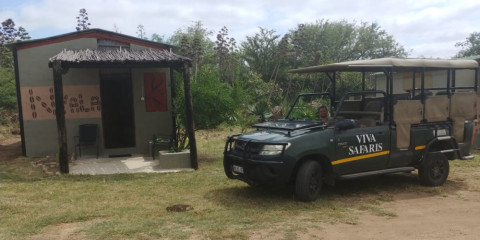
3-Day Tremisana/Masango Kruger Park Safari
$638 pp (USD)
South Africa: Shared tour (max 9 people per vehicle) Budget Lodge & Chalet
Viva Safaris Tour operator has an office in South Africa
4.9 /5 – 262 Reviews

5-Day Safari with Night Drive and Panorama Route Tour
$1,322 pp (USD)
South Africa: Private tour Lodge
You Visit: Johannesburg (Start) , Panorama Route (Highlight) , Kruger NP, O.R. Tambo Airport (Johannesburg) , Johannesburg (End)
Khalanga Safaris Tour operator has an office in South Africa
5.0 /5 – 62 Reviews

6-Day Sabi Sands and Kruger Park Safari
$4,098 to $4,495 pp (USD)
South Africa: Private tour Luxury Lodge & Tented Camp
You Visit: Johannesburg (Start) , Sabi Sands (Greater Kruger) , Kruger NP, Johannesburg Airport (End)
Discover Africa Safaris Tour operator has an office in South Africa
4.9 /5 – 420 Reviews

5-Day 4 Star Panorama Route & Greater Kruger Park Safari
$1,883 pp (USD)
South Africa: Private tour Luxury Lodge & Hotel
You Visit: Johannesburg (Start) , Panorama Route (Highlight) , Greater Kruger, Kruger NP, Johannesburg (End)
Mmilo Tours Tour operator has an office in South Africa
5.0 /5 – 123 Reviews

3-Day Big 5 Budget Safari, Kruger National Park
$372 pp (USD)
South Africa: Shared tour (max 10 people per vehicle) Budget Lodge
Safari With Us Tour operator has an office in South Africa
5.0 /5 – 217 Reviews

3-Day Safari in Style - Lodge Living & Kruger Safari Fun
$765 pp (USD)
South Africa: Shared tour (max 9 people per vehicle) Luxury Lodge
You Visit: Johannesburg (Start) , Balule NR (Greater Kruger) , Central Kruger, O.R. Tambo Airport (Johannesburg) , Johannesburg (End)
Shinzelle Safaris Tour operator has an office in South Africa
4.9 /5 – 63 Reviews

4-Day Kruger Safari, Soweto & Apartheid Museum
$860 pp (USD)
South Africa: Private tour Mid-range Lodge & Tented Camp
You Visit: Johannesburg (Start) , Soweto (Johannesburg) , Kruger NP, Johannesburg Airport (End)
Nhlalala Travel Tour operator has an office in South Africa
4.9 /5 – 33 Reviews

3-Day Camping Safari in Kruger National Park
$520 pp (USD)
South Africa: Shared tour (max 10 people per vehicle) Budget Camping
You Visit: Johannesburg (Start) , Kruger NP, Johannesburg Airport (End)
Mbombela Experience Tours & Transfers Tour operator has an office in South Africa
5.0 /5 – 32 Reviews

4-Day & 3-Night Kruger National Park Budget Safari
$583 to $649 pp (USD)
South Africa: Shared tour (max 8 people per vehicle) Mid-range Guest House
You Visit: Johannesburg (Start) , Southern Kruger, Kruger NP, Johannesburg Airport (End)
The Mzansi Experience Tour operator has an office in South Africa
4.8 /5 – 63 Reviews
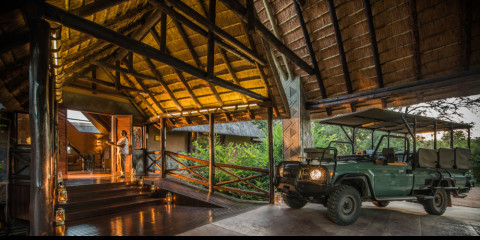
5-Day Luxury Kruger Park and Sabi Sand Safari
$2,921 pp (USD)
South Africa: Private tour Luxury Lodge & Chalet
You Visit: Johannesburg (Start) , Kruger NP, Sabi Sands (Greater Kruger) , Johannesburg (End)
Safari.com Tour operator has an office in South Africa
4.7 /5 – 186 Reviews

7-Day Classic Eco-Safari in Kruger National Park
$4,091 pp (USD)
South Africa: Self-drive Mid-range Lodge
You Visit: Johannesburg (Start) , Klaserie NR (Greater Kruger) , Southern Kruger, Kruger NP, Panorama Route (Highlight) , Blyde River Canyon (Panorama Route) , Johannesburg (End)
5.0 /5 – 42 Reviews

5-Day Discover the Ultimate Escape Unlock Your Getaway
$1,690 to $2,242 pp (USD)
South Africa: Private tour Luxury Tented Camp & Hotel
African Wildlife Plains Tour operator has an office in South Africa
5.0 /5 – 2 Reviews

4-Day Zula Kruger Shalati Train on the Bridge
$3,166 to $3,454 pp (USD)
South Africa: Private tour Luxury Lodge
You Visit: Johannesburg (Start) , Sudwala Caves (Highlight) , Kruger NP, Panorama Route (Highlight) , Johannesburg (End)
Zula Zula Adventure Bus Tour operator has an office in South Africa

5-Day Imbali Lodge Safari
$2,291 pp (USD)
South Africa: Shared tour (max 9 people per vehicle) Luxury+ Lodge
You Visit: Johannesburg (Start) , Kruger NP, Imbali Concession (Kruger NP) , Johannesburg (End)
The Kruger Safari Co. Tour operator has an office in South Africa
5.0 /5 – 125 Reviews

4-Day Luxury Mdluli Game Lodge Kruger National Park
$796 pp (USD)
Gems of Africa Safari and Tours Tour operator has an office in South Africa
4.9 /5 – 98 Reviews
Related Searches
- South Africa Safari Tours
- Kruger Tour Operators
- 5-Day Kruger Packages
- Best Kruger Safari Tours
- 6-Day Kruger Safaris From Johannesburg
- 3 Day Kruger Safaris From Johannesburg
- Kruger Safaris From Hazyview
- Timbavati Safari Tours
- Tshukudu Safari Tours
- Klaserie Safari Tours
- Lion Sands Safari Tours
- Addo Elephant Safari Tours
8 Questions About Kruger National Park Safaris

Answered by
Philip briggs.

When is the best time to go on safari in Kruger?
“The best time for Kruger safaris is during the southern hemisphere winter months of May to September, with wildlife-viewing conditions improving throughout this period. Climatically, it is most pleasant during these dry winter months (warm by day, cool by night) and there are fewer mosquitoes, which reduces the risk of contracting malaria. Winter offers the most productive wildlife viewing. This is because the vegetation tends to be lower and thinner, allowing for better visibility, and the lack of rain causes wildlife to gather around permanent water sources. Bird-watchers may arrange their Kruger tours for summer, when large numbers of migrant birds arrive from Europe and many resident species display a colorful breeding plumage. If you don’t like crowds, avoid visiting Kruger during South African school holidays.”
What are the most popular areas in the park?
“Most Kruger safari packages focus on the park’s southern third. Partly this is because it’s the closest section to Johannesburg, and pretty much everywhere else in South Africa, which means it fits most comfortably into a countrywide itinerary. In addition, the south has denser wildlife populations than the north and wildlife tends to be more habituated to cars (and therefore easy to view). There is also a greater choice of rest camps and concession lodges. Probably the most productive and popular game drives in the south comprise a triangle of roads connecting Skukuza, Lower Sabie and Satara, and the two roads running south from Skukuza to Malelane and Lower Sabie to Crocodile Bridge Gate. The popularity of these roads means they can become congested during busy periods such as school holidays, which is when locals tend to visit Kruger.”
Is Kruger good for a self-drive trip?
“Yes, Kruger is arguably the best self-drive safari destination anywhere in Africa. This is due to its easy accessibility, combined with a network of good surfaced roads and well-equipped rest camps, and the ready availability of interpretative material such as maps and dedicated field guides. Self-drivers can either rent a car in Johannesburg or Pretoria and drive to Kruger, or they can fly to an airport within the park or just outside it and pick up a rental car there (by advance arrangement). Self-drivers should bear in mind that cars drive on the left side of the road (like the UK and many former British colonies, but unlike the USA and most of Europe and Asia). You should allow for average driving speeds of around 30km per hour within the park. The speed limit in Kruger is 50km per hour on surfaced roads and 40km per hour on dirt, but you also need to allow time for stops to look at wildlife. Another attraction for independent travelers is that prices for Kruger safaris tend to be very low compared to other major African parks.”
What animals can I expect to see on a Kruger safari?
“All the Big Five (lion, leopard, elephant, rhino and buffalo) are present in significant numbers. However, wildlife viewing in Kruger can be hit-and-miss, so those seeking a Big Five quick fix would be better heading to one of the private reserves that offer expertly guided all-inclusive safari packages. That said, those who allocate a couple of days to their Kruger safari can be confident of encountering large herds of buffalo and elephant, and also stand a good chance of seeing lion, white rhino and, to a lesser extent, leopard and black rhino. Other wildlife commonly seen on Kruger safari trips includes spotted hyena, black-backed jackal, southern giraffe, plains zebra, hippo, warthog, wildebeest, impala, greater kudu, common waterbuck, vervet monkey and chacma baboon. Sightings of cheetah and African wild dog are possible but rare. Birdlife is prolific, with more than 500 species recorded. The park is particularly good for colorful savannah dwellers such as the lilac-breasted roller, yellow-billed hornbill and white-fronted bee-eater. There is also a wide variety of eagles, vultures and other raptors, as well as hefty ground dwellers such as the southern ground hornbill, kori bustard and ostrich.”
How long is the drive to the park?
“Coming from Johannesburg or elsewhere in Gauteng, most of the southern gates lie between 400km/249mi and 500km/311mi to the east, a drive of up to five hours on good surfaced roads. Coming from Kruger Mpumalanga International Airport outside Mbombela (Nelspruit), most of the southern gates lie between 40km/25mi and 100km/62mi away, so allow up to 90 minutes. The most remote gate from Johannesburg is Pafuri, which lies about 620km/385mi to the northeast, a seven- to eight-hour drive on roads that deteriorate as you approach the park. When planning your Kruger holidays in the context of a full South Africa tour, be aware that the park is an astonishing 1,800km/1,118mi from Cape Town using the most direct route, and almost 750km/466mi from Durban.”
What condition are the roads in within Kruger?
“An excellent network of surfaced roads suitable for 2WD cars connects all gates and rest camps in Kruger. This is supplemented by a secondary network of unsurfaced roads, most of which are also suitable for any 2WD car, though some might become problematic after heavy rain. A good map showing the full internal road network can be bought cheaply at any entrance or rest camp gate, and all junctions within the park are signposted for easy navigation. From a wildlife-viewing perspective, surfaced roads often follow busier routes, so taking quieter unsurfaced routes will probably enhance your Kruger vacation.”
Is the park fenced?
“Until a few years back, the entire park was fenced. Today, however, it shares open borders with a number of private reserves that run along the western border, though in most (if not all) cases, these private reserves are fenced along their outward boundary. Fences along the international boundaries with the other two components of the Great Limpopo Transfrontier Conservation Area (namely Limpopo National Park in Mozambique and Gonarezhou National Park in Zimbabwe) are no longer maintained. This allows wildlife some freedom of movement into these neighboring reserves.”
What lodges or camps do you recommend for a Kruger safari?
“For a short Kruger holiday (up to 3 nights), I would concentrate on the far south. My favorite camp there is Lower Sabie, which has a beautiful location on the Sabie River at the heart of several top-notch wildlife-viewing roads. Skukuza, the park’s largest rest camp, is a bit too busy for some, but it’s very well equipped (with everything from ATMs and car-rental outlets to a well-stocked supermarket and restaurant) and has a useful location for exploring some good wildlife-viewing roads. Those able to dedicate more time to a Kruger tour (4 or more nights) could head to the central plains. Satara Rest Camp lies in an area of open savannah where lion and cheetah are often seen. Olifants Camp has a stunning location on a wooded ridge overlooking the eponymous river, and tiny Balule Satellite Camp is ideal for those seeking a remote and super-affordable bush experience. An extended Kruger tour (ideally 7 to 10 days) might also take in the far north, where my favorite rest camps are riverside Shingwedzi and remote Punda Maria. For those seeking more exclusive safari packages, try one of the dozen or so upscale concession lodges scattered throughout the park. These lodges offer a luxurious all-inclusive guided experience similar to the legendary Sabi Sands block of private reserves along the park’s western border.”
Kruger Safari Reviews

Alan is a travel writer and author of over 20 Lonely Planet guidebooks, including the guides to Southern Africa and Zambia & Malawi.
Killing time in Kruger
The mothership of South Africa’s parks, Kruger is more organised and has more variety of accommodation than any other park. It also has a HUGE number of animals with the Big Five and every other kind of five you can think of rustling...
Full Review

Mike is an award-winning wildlife writer, former editor of Travel Zambia magazine and author of the Bradt Guide to Southern African Wildlife.
Africa’s Best DIY Safari
South Africa’s premier wildlife reserve divides opinion. Some who’ve visited supposedly ‘wilder’ parks argue that the Kruger’s developed infrastructure, complete with paved roads and large public camps, undermines the wilderness...
The parks we visited during our stay were varied. The first evening safari we didn’t see the animals we hoped. However the full day drive the following day made up for this. We saw everything we hoped to, mainly the Hippis and Giraffes....
It is everything that thousands of others have experienced. It is soo big that it would take weeks to discover each region, but we were thankful for seeing the best that we could in a limited timeframe.
Brilliant glamping experience. The safari tour guide was knowledgeable and we managed to spot the animals. The glamping staff were friendly and they kept the facilities clean. This was a girls trip and we felt safe throughout our stay....

Once in a life time unforgetable experiance . All staff members were very helpful +HIGHLY capiable.
Viva Safaris kept to their programme, Bushwalk, Great Kruger Safaris with very well trained, friendly guides, Sunrise and Sundown safaris (Bush Braai was unbelievable crowned with an Amarula Liquer Toast). The safari jeeps accomodated very...
- International edition
- Australia edition
- Europe edition
Kruger national park: the best animal videos
A quick-thinking impala forging an escape route from a hungry cheetah through a window of an unsuspecting tourist's car: it had all the ingredients for a runaway YouTube hit . But these tourists aren't the first to have had an unbelievable run in with nature on the roads of South Africa's Kruger national park, and they won't be the last. Here are some more incredible encounters between drivers and animals within the park, all captured through tourists' amateur footage.
Note that Kruger rules insist that visitors remain in their vehicles within the park, unless in a designated area. Vehicle doors have to be closed at all times, and no body parts can protrude from window, doors, or sunroofs.
Battle at Kruger
This is the ultimate Kruger video, and, with over 72m views on YouTube, it's certainly the most famous. Professional camera crews would kill to have witnessed a scene such as this one – in which a herd of cape buffalo, a pride of lions, and some crocodiles go head to head. On the off-chance you've haven't seen it, we won't give any spoilers, but this eight-minute sequence has more twists and turns than a python in a U-bend. Even if you've seen it before (perhaps way back in 2007, when it first surfaced), watch it again now – this is a scene that never ceases to amaze, no matter how many times you see it.
Leopard gets it on with a Fiat Punto
The way this leopard rounds a Fiat Punto, circling it and even pawing it, it's as if it has never encountered anything quite so fascinating. Surely he must have seen loads of cars on these roads? Look more closely though, and it appears to be his own reflection that has captured his attention. A vain leopard can't change his spots, but, given the chance, he can admire them.
Python slips into car bonnet
"He's going to go under you car, people!" exclaims one tourist as a huge python gets closer and closer to the vehicle in front of them. Ultimately, the python goes one step – or slither – further, and heads right under the car bonnet. After making a temporary home there, it stays put for the ride and even poses for some photos when the car – and its convoy – pulls into a designated area, where tourists are allowed to disembark.
'I don't like the way he's looking at us'
The majesty of this gentle, lumbering elephant almost gets upstaged by the couple filming it. "This is great videoing!" exclaims the man, as his panic-stricken wife holds the camera. Skip forward to 2m20 to hear the playful domestic argument reach its peak ("Video it! Video it!", "No! Please! Move! Please!") It's almost as if the elephant knows what's going on and so deliberately teases them, stopping and starting while creeping slowly towards their windscreen. As the elephant moves away, the husband gets the last word: "That was beautiful! What a joy! [Silence] Love? Are you still videoing?"
The king of the tarmac
This lion causes roadblock by getting romantic with ... the tarmac. He licks it, he caresses it, he never seems to want to leave the spot. We don't know quite what's going on here. Can he taste something? If so, it must be really good. Finally, he regains himself and slowly moves on as if nothing happened. If any animal behaviour experts want to explain what's going on here, we'd love to hear your thoughts (leave a comment below).
Man charges at elephant
It can't be deemed as one of the best, but it's a great example of exactly what not to do when visiting Kruger. This man breaks every rule in the book by charging towards a wild elephant on foot while, allegedly, drunk. "Run! Run at him!" shouts one of the onlookers, before falling into hysterics. The man – a professional guide – lost his job after the video went viral and he later issued a public apology .
- South Africa holidays
- Africa holidays
- Wildlife holidays
Comments (…)
Most viewed.
Kruger Park Video
The most popular video ever taken at the kruger national park: battle of kruger. watch buffalo, lions and crocodiles in action.
- James Steveson Hamilton
- Paul Kruger
- Louis Trichardt
- Kruger Maps
- South Africa
- Malaria Information
- Opening Times
- Maqueda Lodge
- Johannesburg Airport
- Hazyview Guesthouse
- Hazyview B&B
- Grand Kruger Lodge
- River Lodge
- Tanda Tula Game Reserve
- Mala Mala Game Reserve
- Jock Safari Lodge
- Mohlabetsi Safari Lodge
- Golfing Holiday Home
- Numbi Suites
- Komanti River
- Durban Hotel
- Victoria Falls Hotel
- Swaziland Lodge
- St Lucia Lodge
- Camping Safari
- Safaris with Accommodation
- Private Safaris
- Panorama Tour
- Shangana Culture Village
- Elephant Safari
- Disabled Tours
- Kruger National Park Swaziland Durban
- Kruger Park Big 5 Camping Safari
- Victoria Falls to Johannesburg
- South Africa to Zimbabwe
- Swaziland Kruger Park Camping Safaris
- Okavango & Chobe Safari
- Mozambique Diving Tour
- Zimbabwe Safaris
- Zimbabwe Tour
- Kruger Park Lesotho Swaziland
- Lesotho Swaziland Kruger Park
- South Africa Tour
- Victoria Falls
- Garden Route
- Desert Tour
- Experience Namibia
- Lesotho Garden Route
- Victoria Falls to Cape Town
- Garden Route Camping Safari
- Desert Safari
- Cape Town to Kruger
- Southern Africa Safari
- Three Rondavels
- Gods Window
- Bourkes Luck Potholes
Krüger National Park Tiervideo - Südafrika Video aus dem Kruger Nationalpark - The Battle at Kruger
The first video we want to show you is a fight between a buffalo and a herd of lions. The video is very exciting, because crocodiles also interfere in the action. The owner of the videos was extremely lucky to catch the entire action on video. It is, howerver, not exactly suitable for viewers with a faint heart. Spoiler Alert: The video has a good end!
Kruger National Park Video - 8 Minutes
The Battle at Kruger Video - Eye-Witness Reports - First video on this page It all started one afternoon when we received a message by radio from my colleagues. Lions were present at the waterhole between the Pretoriuskop and Skukuza.
When we arrived there, we found seven lions lying near the dam. A large herd of buffalo drinking at the waterhole as well. All the lions were very young and inexperienced. An adult lioness was there and I did not think they would have the courage to attack the buffalo herd. We decided with my clients to watch the buffalo and lions a while longer. The buffalo herd began to move in the directions where the lions were lyying. The lioness was hiding behind a rock, nearby where we had parked our vehicle. The buffalo herd moved inexplicably in the direction of the lions. At the very front of the buffalo herd, there was also a young calf. The rest of the lions, that did not have any cover were fascinated by the situation. One of the guests asked me what would happen. I told him based on my long experience, that the lions would leave the scene, as buffalo are too strong as a unit. I did not even finish the sentence, as a lion already started to approach the buffalo in a threatening attitude. The front of the buffalo herd was around 20 to 30 meters away from the group of lions. The lead animal stopped suddenly as it recognized the danger and they moved quickly back in panic. The Lions saw their chance and attacked the weakest animal in the group - a young calf. The Lions ran past the two adult buffalo and jumped on the calf. The calf was close to the water and the fight continued in the water. The rest of the buffalo herd quickly moved away from the water hole. Now the famous video''The Battle at Kruger''began in earnest. The remaining lions were busy to pull the calf out of the water. Suddenly a giant crocodile from the water had captured a leg of the buffalo calf. A big fight between the lion and the crocodile began but the lion managed to pull the calf ashore. Five or six lions now dealt with the calf, which they had dragged back on land. In the meantime, the buffalo herd had regrouped and moved back towards the water hole. A cloud of dust appeared as the buffalo herd came back. The entire herd came to the aid of the calf. The first lion was trying to assert itself and a bull attacked the lion. The lion was flying high through the air and the other lions decided to give up on the calf. The calf got up and rejoined the group without major problems. Those were incredible moments! But look at the video; it's indescribable!
Should you have any safari videos you want to share with us, we will be very happy if you can contact us. We will also gladly publish an material (pictures or videos) that you send to us.
We hope you enjoy your time at the Kruger National Park. The two videos on this page are just a little taste what you will experience on your safari.
Your Kruger Park Team
Back >>> Kruger National Park Videos

- [email protected]
- Plan my Safari
4 Day Kruger Park Safaris
4-day kruger park safari.
A safari is a thrilling and adventurous journey done by travellers to explore the African continent’s culture, geography, landscape, and wildlife.
What Is a 4-Day Kruger Park Safari?
This 4-day Kruger Park safari is one of the best ways to experience that “genuine Africa,” as it allows guests to experience a variety of wildlife in their natural habitat.
A safari excursion allows you to get up close and personal with the terrain and landscapes and can be custom-built from elite, luxury private safaris to more economical, traditional group or individual safaris.
Classic safaris can still offer great wildlife encounters while staying in Kruger National Park’s comfortable safari accommodation, whilst a private luxury safari will provide an opulent experience in a more refined safari refuge with creature comforts and luxury facilities.
The ultimate Kruger Park safari would, of course, be a combination of the two, so a 4-day safari will provide an excellent introduction to both – travelling along routes noted for wildlife populations and spending the night in a luxurious chalet or tented accommodation.
In short, a four-day safari in the Kruger Park is the ideal getaway.
Brief overview of the Kruger National Park
Kruger National Park is a 2 million-hectare national reserve in South Africa’s north-eastern portion. SANParks manages Kruger National Park, which has many big rest camps, a few bush camps and lodges, and private camps in privately managed concessions inside the park’s limits.
Greater Kruger is an extra region of approximately 180 000 hectares of private protected wilderness properties on the western edge of the national park.
Although Kruger National Park is state-owned, tourism is the primary source of funding, and some private concessions inside the national park contribute significantly to revenue generation.
They are popular with guests who want the type of luxury provided in a private game reserve but prefer to stay inside the park itself.
Many Kruger Park safaris provide such lodgings in four to five star accommodation and with open vehicle safari drives. Others make use of more modest accommodation, including optional self-catering and the option of self-driving or guided game drives.
What Should I Pack for My Safari
To make the best of your safari and be prepared for minor crises, pack the following:
- Passports, travel insurance docs itinerary, and etickets
- Prescription Medication as well as a basic first aid kit with hand sanitizer, antihistamine), eye drops, and anti-malarial tablets.
- Sunglasses, hat, sunblock, lip balm, and mosquito repellent
- Binoculars, camera, and lenses
- Comfortable clothes, bandanna or cotton scarf, walking shoes, sandals, swimsuit, and a rain jacket
- Phone, tablet or Laptop
- A good flashlight or headlight
- A good book and t travel diary or journal
Best Time to Go on Safari
South Africa is a huge and diversified country with a diverse climate that differs by location. Summer generally lasts from roughly December to March, followed by winter from June to August.
From May through October is the finest season to visit the Kruger National Park and surrounds for a safari.
The animals are concentrated around water sources and are easier to identify in the dry season’s thinned-out foliage, making these months ideal for game.
3 Best 4-Day / 3-Night Kruger Park Packages
A private 4-day/3-night safari at Lukimbi Safari Lodge inside the Southern Kruger National Park is the best one can indulge in.
Bounded by three major river systems, the lodge offers a diverse habitat of grasslands, wooded areas, and riverine thickets. You will go out on sunrise and sunset safaris every day when the animals are most active.
Game drives take place on exclusive private roads and off-road driving is permitted to get you close up to the “Big Five”.
This tour starts and ends at Kruger Mpumalanga Airport near Nelspruit in Nelspruit and a transfer from and back to the airport is included.
On this classic 4-day tour by Kruger Safari Company Tours, guests are transported from OR Tambo for a stay at a Game Lodge in the Balule Game Reserve next to the Kruger Park. They can enjoy the Orpen, Satara, and Nwanedzi regions of the park with sunrise and sunset game drives, and a thrilling bush walk. A visit to the Blyde River Canyon and a traditional Bush Braai at the Marula Tree Boma is also included.
Kruger Safari Company also offers a 4-day tour from OR Tambo International Airport, with accommodation at a lodge near Hazyview and Phabeni Gate.
The 4-day itinerary includes a sunset / night safari on day 1, a full-day open vehicle safari on day 2, a full-day Panorama Route on day 3 and a morning safari in Kruger National Park on day 4.
You will experience a variety of eco zones in the Kruger National Park, each zone with its own set of wildlife as well as the famous attractions of the Panorama Route.
Pros and Cons of a 4-Day/ 3-Night Safari
Kruger National Park has the greatest diversity of wildlife in South Africa, and you could spend up to a week enjoying safari and nature walks here. The pros and cons of a 4-day safari is summarised below:
5 Tips for Going on Safari
- Go late in the dry season because in the wet season, the vegetation is thick and animals hide in the bushy shade. The later in the dry season you go, the drier the land and the easier it is to spot animals through the vegetation.
- Don’t sleep late, you need to be up early to catch predators, especially the big cats, who hunt during the night when the temperatures are cooler. The gates of the Kruger camps open between 4:30 and 6:00 already.
- Dress in layers. It might be very chilly when you start out on a morning drive, but temperatures may soar during midday.
- Get a decent map and wildlife book or app to help you plan your day and identify unfamiliar sightings.
- Be careful when approaching dangerous animals. You can get into trouble when getting too close to an elephant herd with small ones.
Luxury vs Budget Safaris Explained
When you go on a luxury safari, you can expect luxury accommodations – either extravagant lodges or lavish tented camps set in fabulous spots of the park, where you can experience exclusivity.
You will sleep in comfortable beds adorned with plush linens, have access to an en-suite bathroom with a hot shower and bathtub; some vanities and a private veranda that overlooks the African bush. You will enjoy round-the-clock electricity and even Wi-Fi connection.
Game drives in open safari vehicles will be done with expert guides who will track animals and beautiful sights.
A budget safari suggests budget accommodation, lower-priced and smaller rooms with basic facilities.
For a budget safari, you will probably stay in one of the rest camps in Kruger National Park itself. You will only be required to pay the daily conservation fees and will be free to drive around yourself or go on a pre-organised guided morning, sunset or night drive.
Optional Activities on Your 4-Day Safari
There are a lot of activities you can enjoy during your safari, including eco trails, backpacking, day walks, wilderness trails, mountain biking, golf and birding.
Types of Accommodation to Choose From
If you’re searching for self-catering lodgings in Kruger National Park that aren’t too expensive, the rest camps provide a wide range of options, including campsites, huts, bungalows, cottages, rondavels, safari tents, and guest homes.
Restaurants, supermarkets, and gas stations are available at the camps. These rest camps are ideal for a self-drive safari, but guided game safaris can also be arranged.
During the busiest holiday seasons, travellers sometimes complain about the hordes of tourists in the Kruger National Park rest camps and the “queuing to observe” animal sightings. If this is the case for you, staying at a luxury lodge on a private concession on some nights of your 4-day safari may provide you with a more intimate and personalised experience.
Several parts within the Kruger National Park’s limits have been leased out for private use.
Private concessions operate separately from the rest of Kruger National Park. The property is managed by the operator, and the private lodge on the site is exclusively accessible to booked guests. Although the concessions are located within the main Kruger Park, only staying guests are granted access to the concessions, adding to the uniqueness of your safari experience.
FAQ’s
Can you do a 4-day safari from johannesburg.
Yes, several tour operators offer 4-day safaris from Johannesburg. The Kruger within a 6-hour drive from the city and international airport
How Many Days Do You Need in Kruger National Park?
Four to five days in the Kruger National Park will give you ample time to experience its diversity of wildlife.
Which Month Is Best for Kruger National Park?
The best month to visit the Kruger National Park is between May and October when vegetation is sparse and animals easier to spot and track.
Do I Need Malaria Tablets for Kruger National Park?
Visitors on a Kruger safari holiday should take anti-malaria tablets and other precautions to prevent being bitten by mosquitos.
Package Safaris:
Payment gateways, accommodation:, extra information:, contact us:.
© 2024 Krugerpark.travel | All Rights Reserved | Privacy Policy | Terms & Conditions The Kruger Safari Co. is a destination management company (DMC) and is not an entity of the South African National Parks Board (SANparks).
Specials Enquiry
4 day kruger park safaris enquiry.

IMAGES
VIDEO
COMMENTS
Join me on a phenomenal safari in South Africa's Kruger National Park and Sabi Sand Game Reserve. The video includes:- Spectacular sightings of Africa's Big ...
Experience an African Safari in this 360 video experience. The video was filmed just outside the Krugar National Park at Thornybush Game Reserve. The Reserv...
Explore the incredible wildlife Safari destination in 5K Ultra HD while watching our 5K nature relax video from https://beautifulwashington.com and http://p...
A safari to see Africa's Big 5 in Kruger National Park has been on our bucket list since we started first met! This adventure was definitely one we will neve...
'Battle at Kruger' is perhaps the most epic homemade safari video ever filmed. It's also one of the most viewed, having raked up 83 million views on YouTube! The now-legendary video was caught on camera in South Africa's Kruger National Park in autumn 2004 by an amateur whilst on a guided safari game drive, just meters from the action.
The Kruger National Park is one of the best places in Africa to cost effectively and successfully go on a self drive safari, as this 360° video illustrates. Two leopards seen within an hour of entering Malelane Gate. Key Moments In This 360° Video. 0.34s. Leopard In Tree . ... The Kruger National Park has 12 main rest camps, 5 bushveld camps ...
Safari Video Gallery. A selection of fantastic safari game drive and wildlife sighting videos taken by our guides in the Kruger National Park as well as other private reserves including Balule and Motlala. Subscribe to the Viva Safaris YouTube channel ...
The quickest route to Kruger Park from Johannesburg is 392 km via the N12 and N4. Driving to Kruger Park from Johannesburg International Airport takes about 4-5 hours without stopping along the way. Driving from Johannesburg to Kruger in perfect conditions should take 5-6 hours. The route has excellent rest stops.
Tips For Planning Your Kruger Safari. 1. Go During the Dry Season (But Don't Stress if You Can't) Kruger Park is a year-round destination, with each season bringing its own highlights. During the dry season (Sep-Nov), animals are easier to spot because the vegetation is sparse and they have nowhere to hide.
Kruger National Park is located in South Africa and is one of the largest game reserves in the country. The park covers an area of over 19,000 square kilometers and is home to over 147 species of mammals, 114 reptile species, 51 snake species, 49 fish species, and a massive 508 species of birds. These numbers that are unrivaled anywhere else in ...
Safari Travel Planner. Safari Enquiry. Extending over a similar area to Wales, Kruger National Park is a 20,000km2 (7,722 square mile) national park that supports more than 160 mammal and 500 bird species, including substantial populations of all the Big Five. The park is an important stronghold for several of Africa's most iconic large mammals.
Kruger National Park. South Africa, Africa. Kruger is one of the world's greatest wildlife-watching destinations. All of Africa's iconic safari species - elephant, lion, leopard, cheetah, rhino, buffalo, giraffe, hippo and zebra - share the bushveld with a supporting cast of 137 other mammals and over 500 varieties of bird.
Business hours of Kruger National Park: Entrance gates open. From 05:30 (06:00 latest). All gates close. From 17:30 (18:30 latest). Best Time to Go on Kruger Park Safaris. Choosing the best time for your safari depends on your personal preferences and how long you want to stay. You need to plan based on what aspects of the safari are most ...
Do you want to go on safari in Kruger National Park? Check out our latest 360 degree video we created during our visit to South Africa. Rhino, Giraffe, Impal...
Because private vehicles are allowed into the park, you can also book a Kruger National Park safari through a private company. There are hundreds of options. Siyabona Africa offers private all-day game drives starting at r4.,653, or about $250 per vehicle (not per person). You can also opt for a shared full-day drive at r2,200 ($116) per person.
Browse 804 kruger national park safari videos and clips available to use in your projects, or search for victoria falls zimbabwe to find more footage and b-roll video clips. herd of elephants grazing in the plains at sunset - kruger national park safari stock videos & royalty-free footage.
South Africa's premier safari destination, Kruger National Park throws up some staggering statistics. Established in 1898, it extends over some 19,000km²/7,335mi² and supports a total of 147 mammal species (the most of any African national park). This includes an estimated 13,000 elephants, 40,000 buffalo, 2,000 lions and more rhinos than ...
Battle at Kruger. This is the ultimate Kruger video, and, with over 72m views on YouTube, it's certainly the most famous. Professional camera crews would kill to have witnessed a scene such as ...
Established in 1898 to protect the wildlife of the South African Lowveld, this national park is unrivalled in the diversity of its life forms and a world leader in advanced environmental management techniques and policies. Kruger is home to an impressive number of species: 336 trees, 49 fish, 34 amphibians, 114 reptiles, 507 birds and 147 mammals.
Kruger National Park Video - 8 Minutes. The Battle at Kruger Video - Eye-Witness Reports - First video on this page. It all started one afternoon when we received a message by radio from my colleagues. Lions were present at the waterhole between the Pretoriuskop and Skukuza. When we arrived there, we found seven lions lying near the dam.
It's been the best trip I ever had. I hope you'll enjoy the beauty of these landscapes and its inhabitants. During this week, I realized how important it was...
Kruger Safari Company also offers a 4-day tour from OR Tambo International Airport, with accommodation at a lodge near Hazyview and Phabeni Gate. The 4-day itinerary includes a sunset / night safari on day 1, a full-day open vehicle safari on day 2, a full-day Panorama Route on day 3 and a morning safari in Kruger National Park on day 4.
Travel video about Kruger National Park, South Africa.Kruger Park is South Africa's most exciting African safari destination. Steeped in legend and history, ...